- All Warped Tour Lineups, Ranked
- Strange Rules at Burning Man
- People You See at Every Festival
- How Altamont Ruined Everything
- All Coachella Years, Ranked
- The World's Greatest Music Festivals
- The Timeline of Fyre Festival
- The Worst True Festival Clichés
- Firsthand Tales from Woodstock
- Tips & Tricks for Sneaking In
- What Was Woodstock Really Like?
- Tips for a Legendary Experience
- The Best EDM Festivals
- The Best Country Music Festivals
- Things to Bring to Every Festival
- Dead Musicians to See as Holograms
- Best Drugs to Take at Coachella
- The 15 Best Headliners At Coachella, Ranked
- 15 Legendary Coachella Performances, Ranked By ...
- 14 Of The Best Music Festival Band Reunions, Ra...

All 25 Warped Tour Lineups, Ranked
Warped Tour is one of the biggest names in the concert canon. Those who haven't gone want to and those who have gone wait for the day they can go again. For a majority of its run, it was the largest traveling music festival in the United States. A number of past Warped Tour lineups have been impressive, but which year was the best? Help decide below!
Starting as an eclectic alternative rock festival in 1995 and gradually morphing into a punk rock festival by the next year, the tour gained momentum when Vans, the wildly popular shoe manufacturer, was signed on as the tour's main sponsor in 1996. As Warped Tour became increasingly popular with each passing year, more sponsors signed on, slowly growing the tour's scope of influence. Sadly, 2018 proved to be the final year of the famous tour as announced by Warped Tour's founder, Kevin Lyman.
You'll find every Warped Tour lineup here! Vote below on the best Warped Tour lineups, keeping in mind factors like the bands performing, production value, and overall spectacle. If you're an avid concert-goer, you can also check out this list of the best Coachella lineups ! (Disclaimer - some years certain dates had slightly different lineups).
Warped Tour 2005

Notable Peformers: My Chemical Romance, Fall Out Boy, Thrice, Billy Idol, The All-American Rejects, Bowling for Soup, Dropkick Murphys, Hawthorne Heights
Dates: June 18 to August 14
Warped Tour 2004
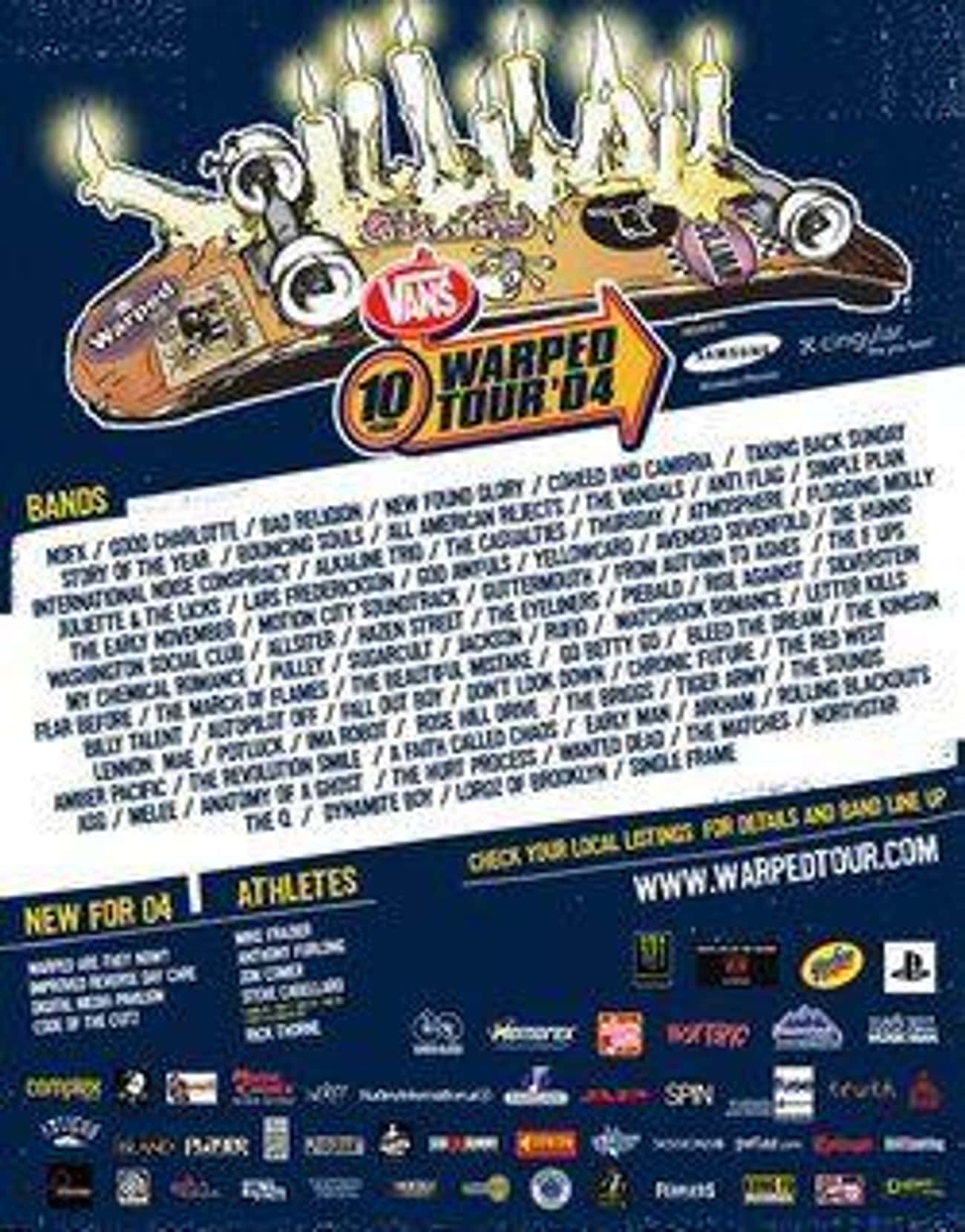
Notable Performers: NOFX, My Chemical Romance, The Used, Fall Out Boy, Billy Talent, Yellowcard, Motion City Soundtrack, New Found Glory, Good Charlotte, Anti-Flag, Bowling for Soup
Dates: June 25 to August 19
Warped Tour 1998
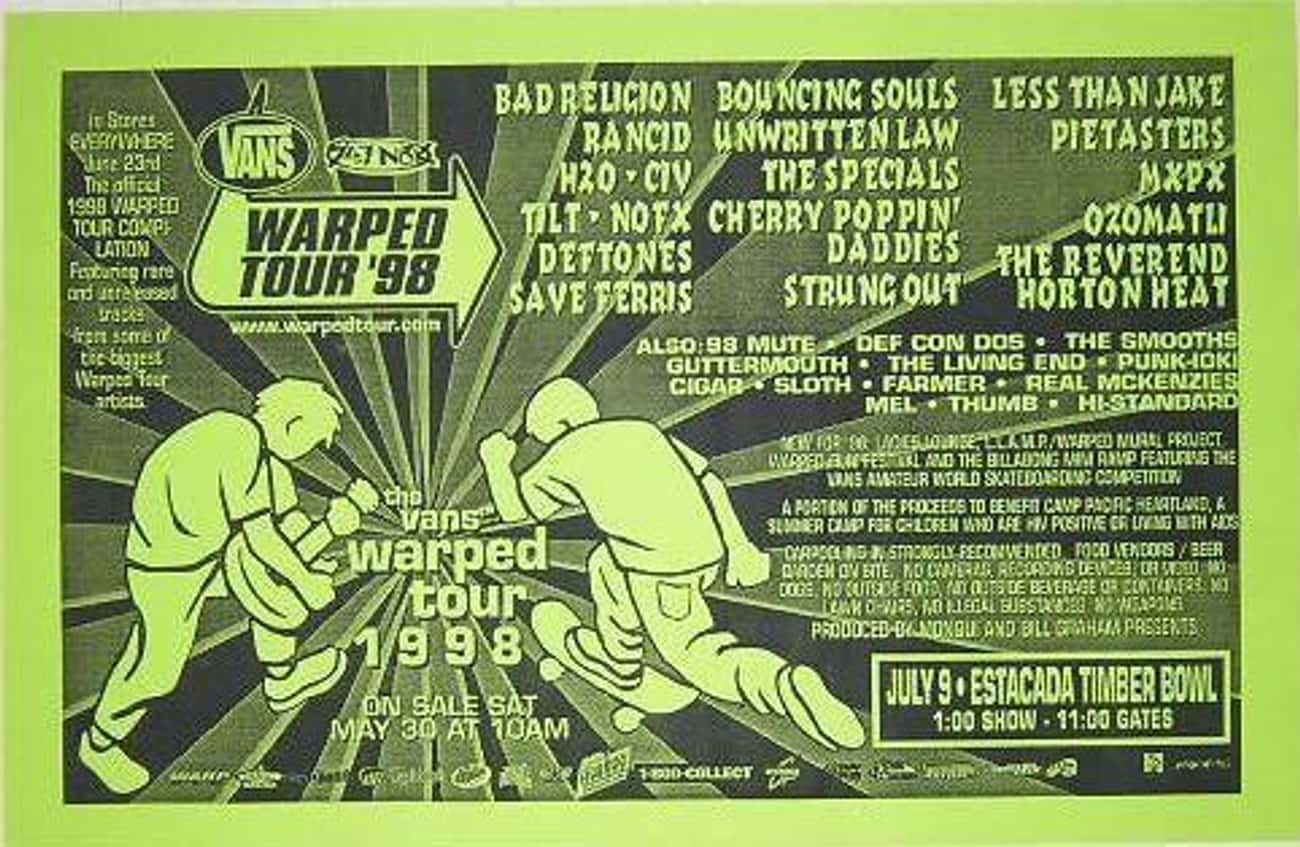
Notable Performers: Bad Religion, Godsmack, Rancid, Less Than Jake, Blink-182, Beck (some dates), Unwritten Law, Reverend Horton Heat, Incubus
Date: July 4 to August 9
Warped Tour 1997
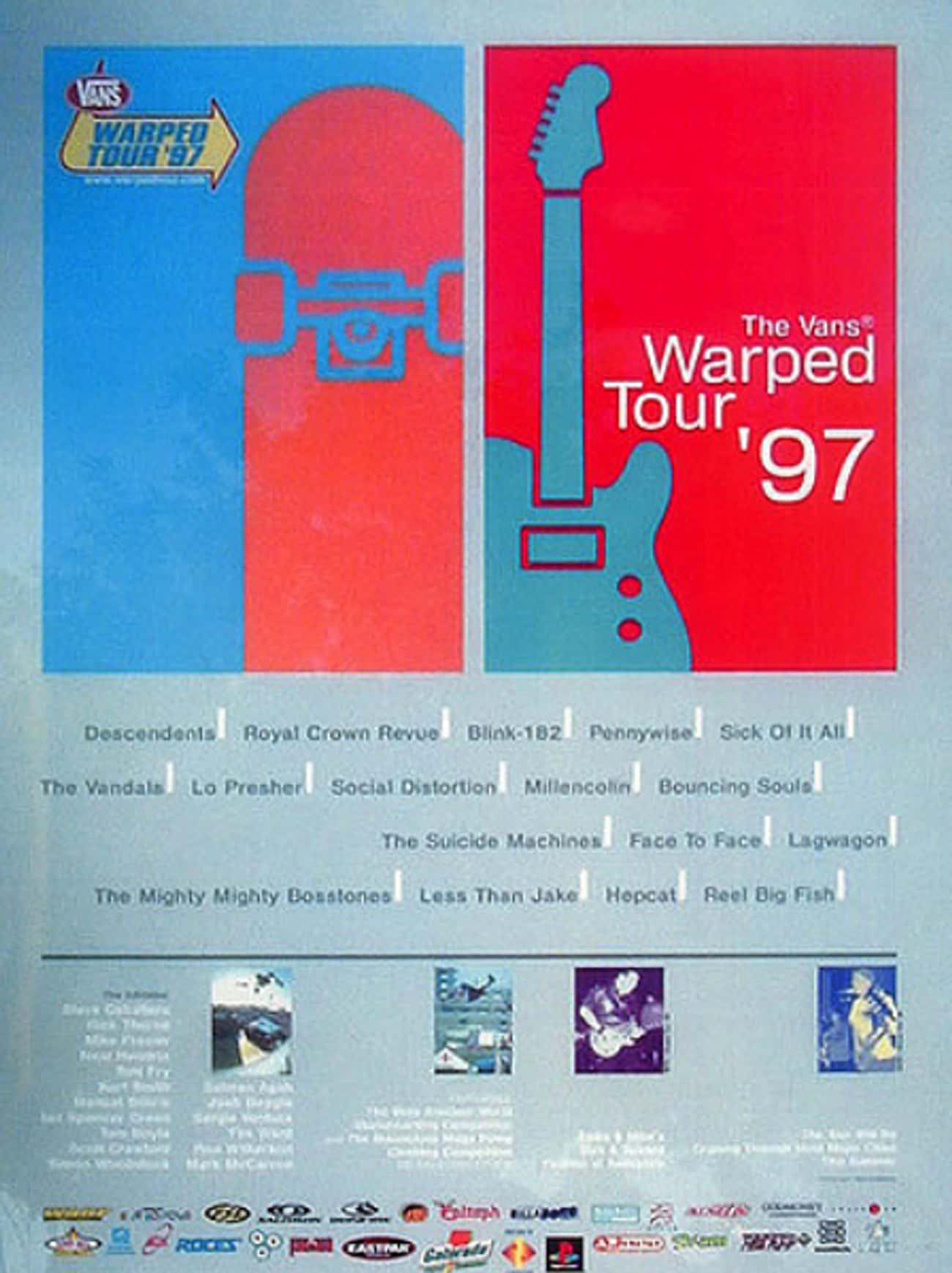
Notable Performers: Blink-182, Reel Big Fish, Descendants, Less Than Jake, Sugar Ray, Pennywise, Social Distortion, The Mighty Mighty Bosstones
Dates: July 2 to August 5
Warped Tour 2001
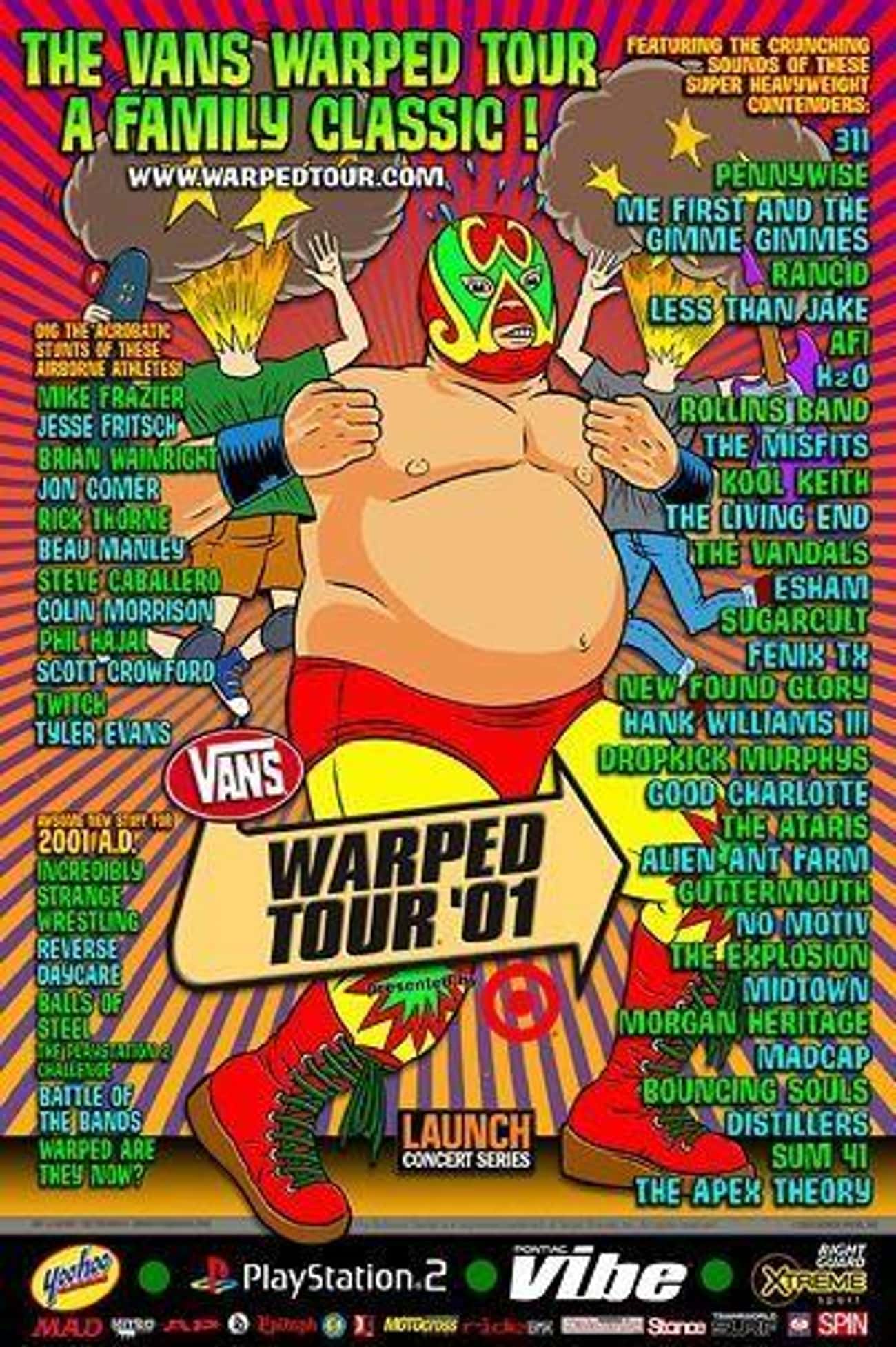
Notable Performers: Pennywise, New Found Glory, Dropkick Murphys, The Vandals, Sum 41, Rancid, Less Than Jake, The All-American Rejects, Good Charlotte
Dates: June 29 to August 12
Warped Tour 2000
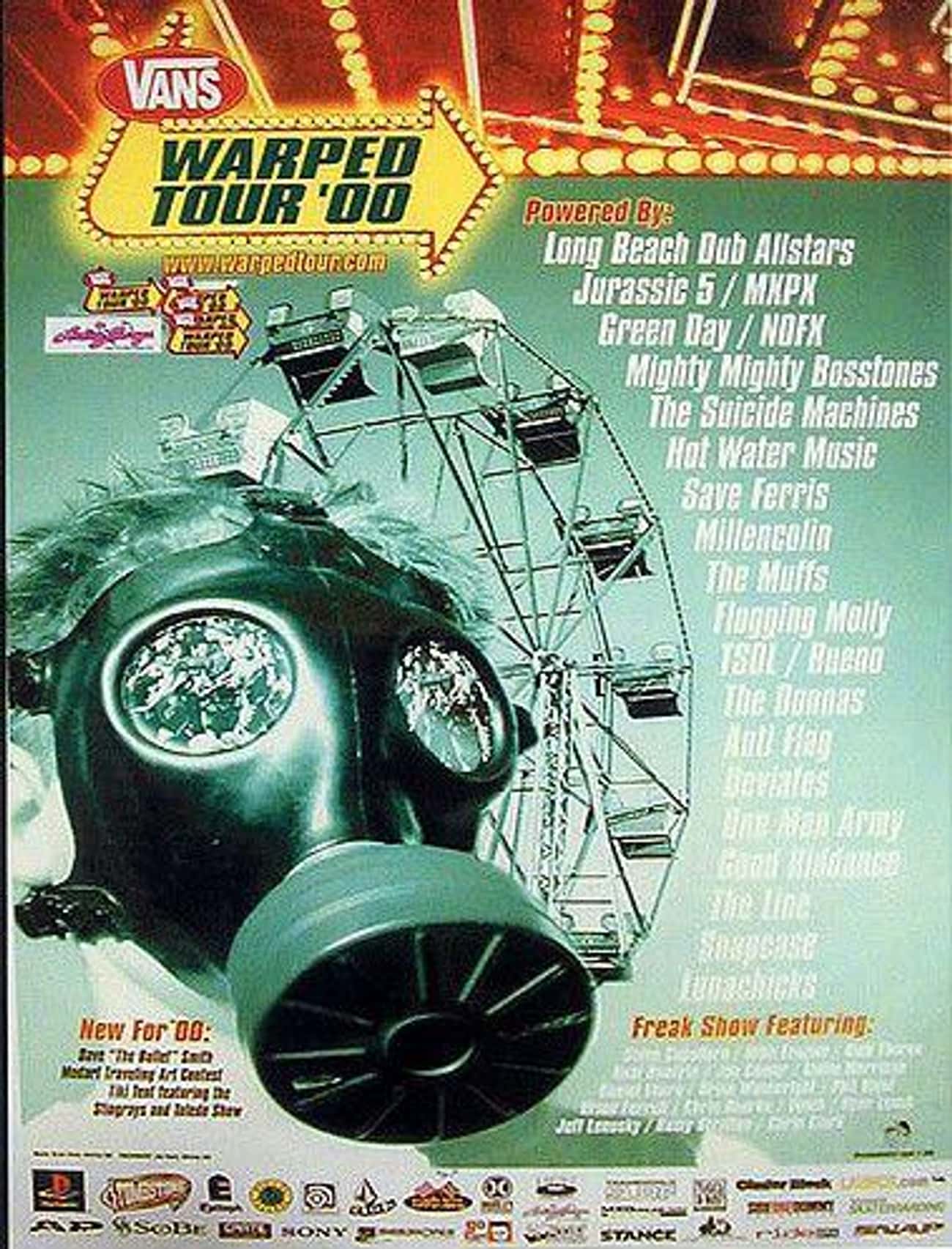
Notable Performers: Weezer, Flogging Molly, Green Day, Anti-Flag, No Doubt, Papa Roach, The Muffs, Suicide Machines, NOFX, Good Riddance
Dates: June 23 to August 6
Warped Tour 1999
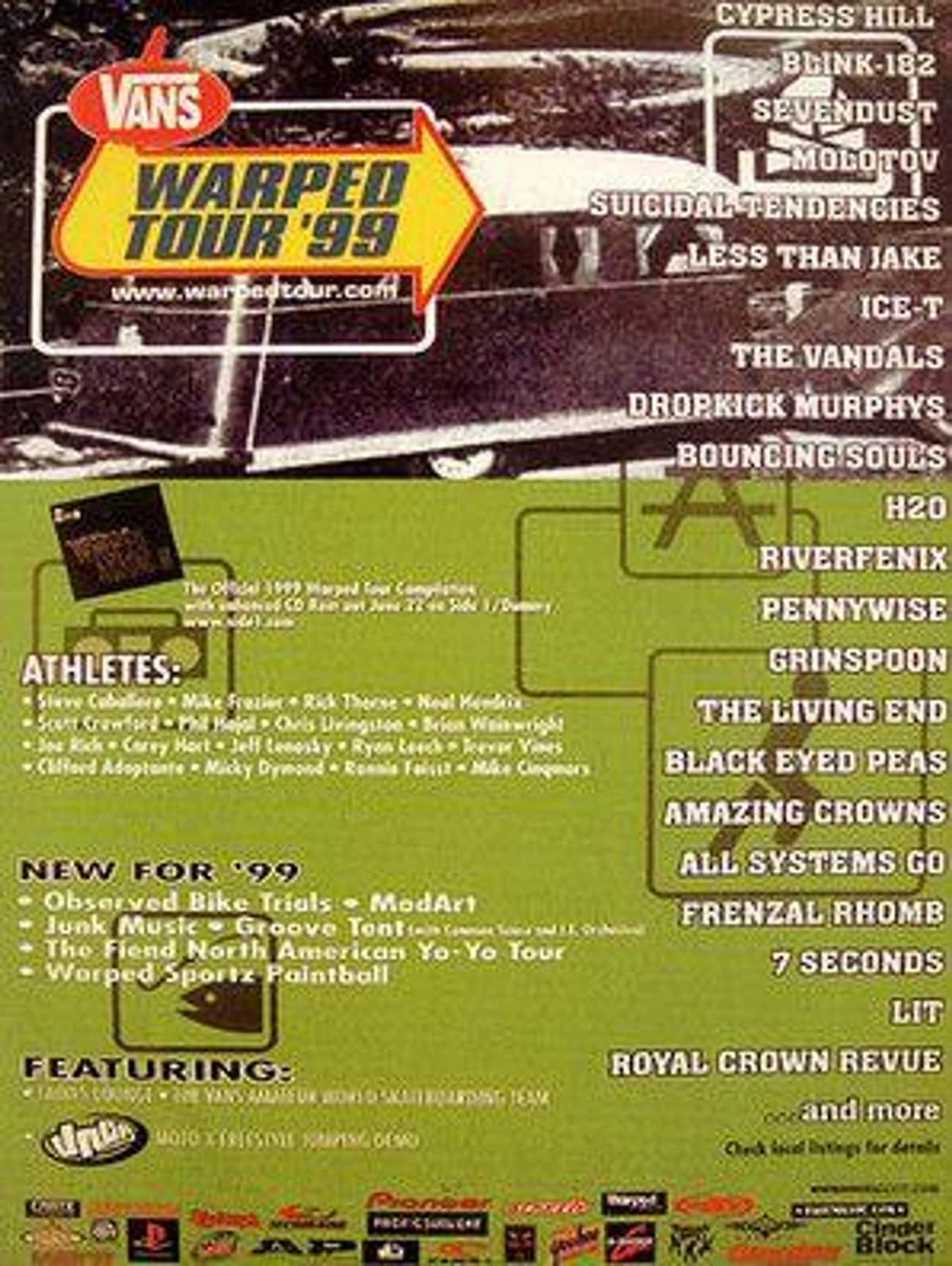
Notable Performers: Cypress Hill, Blink-182, Dropkick Murphys, Pennywise, Black Eyed Peas, Suicidal Tendencies, Less Than Jake, Bouncing Souls
Dates: June 25 to July 31
Warped Tour 1995
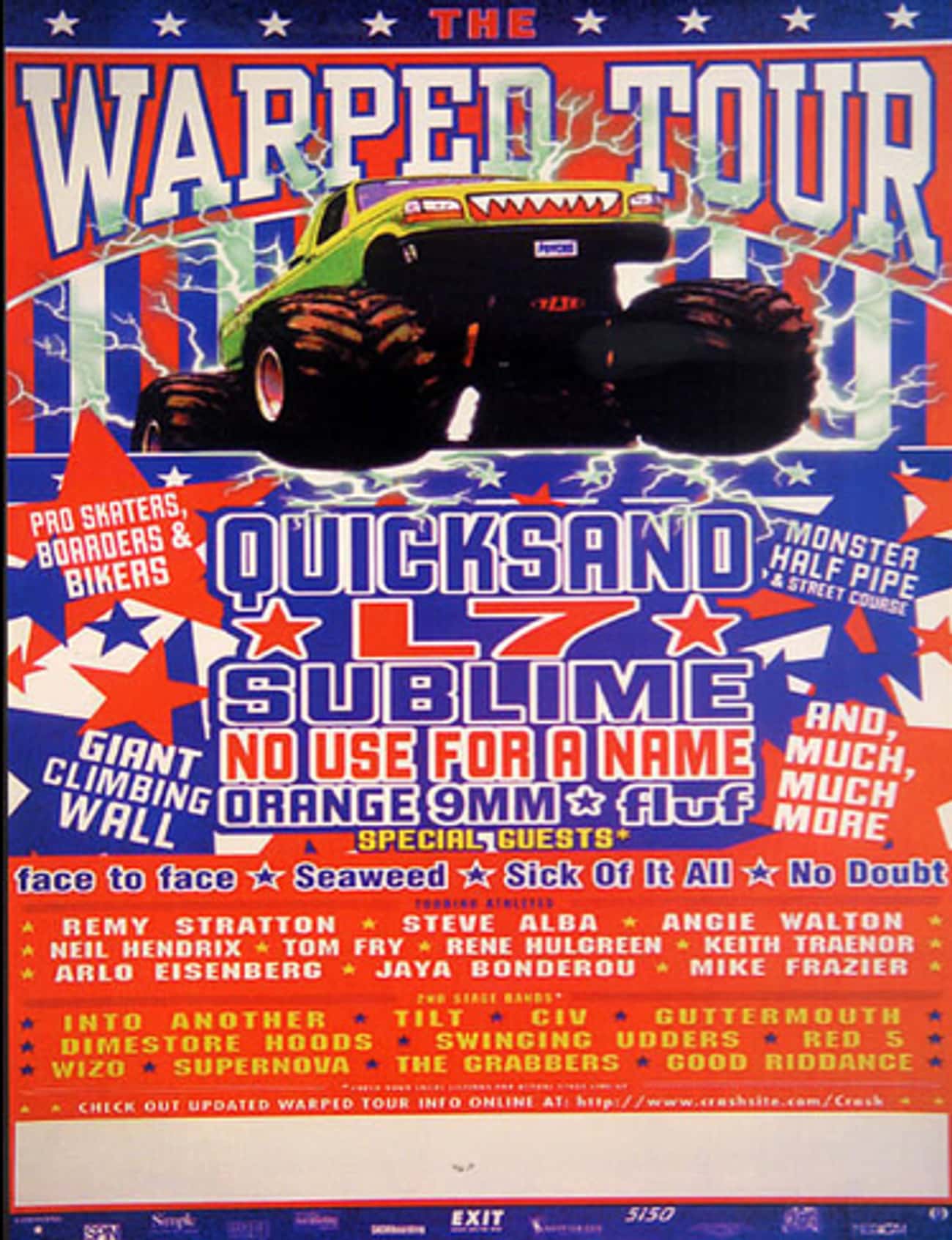
Notable Performers: Sublime, No Doubt, Quicksand, Fluf, Deftones, No Use for a Name, Supernova, CIV, Deftones
Dates: August 4 to September 5
Warped Tour 2007
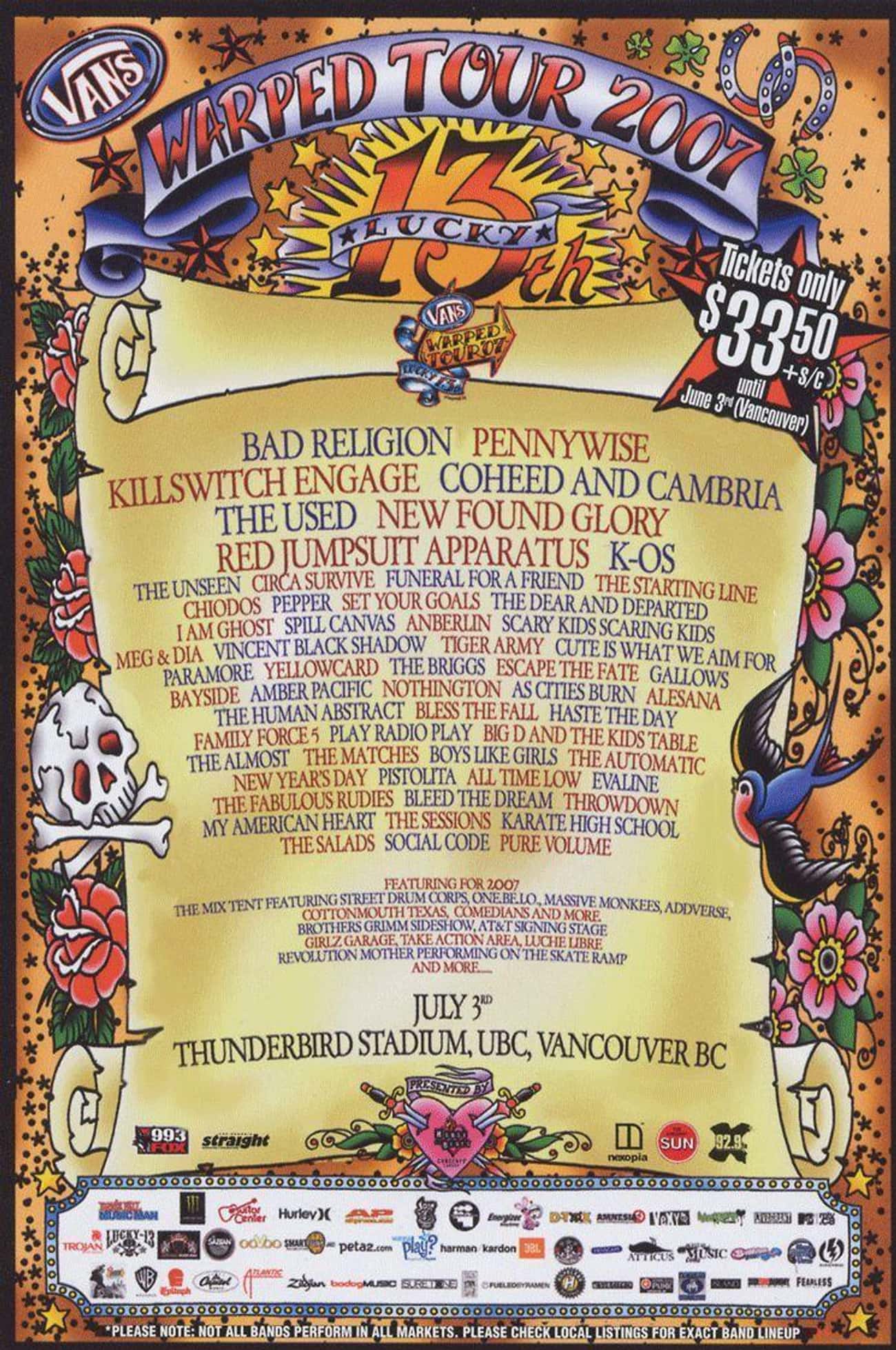
Notable Performers: Bad Religion, Pennywise, Red Jumpsuit Apparatus, Killswitch Engage, Yellowcard, Ambelin, Flogging Molly, Hawthorne Heights
Dates: June 28 to August 25
Warped Tour 2018
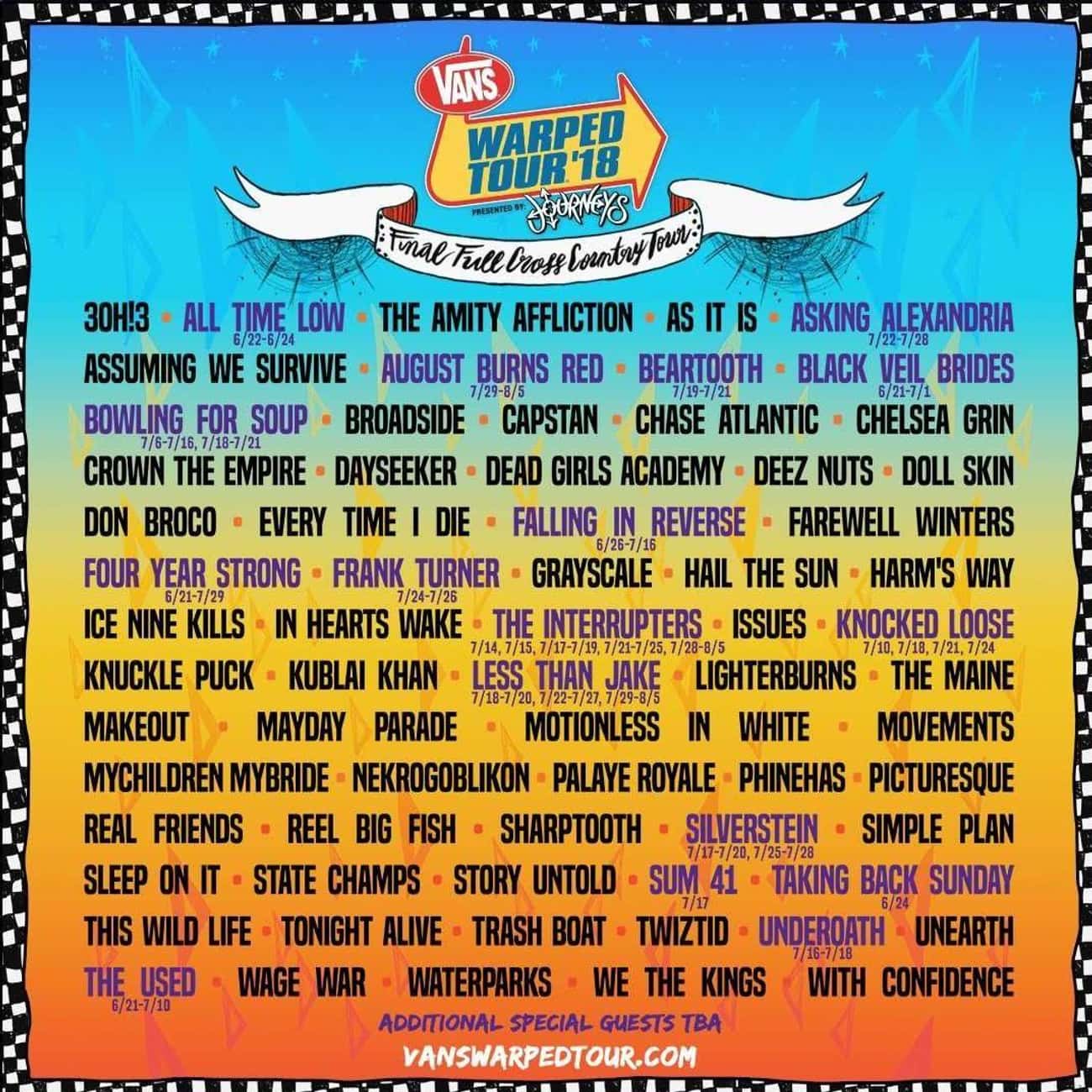
Notable Performers: Korn, Prophets of Rage, Limp Bizkit, Reel Big Fish, Pennywise, All Time Low, Taking Back Sunday, We The Kings
Dates: June 21 to August 5
Warped Tour 2011
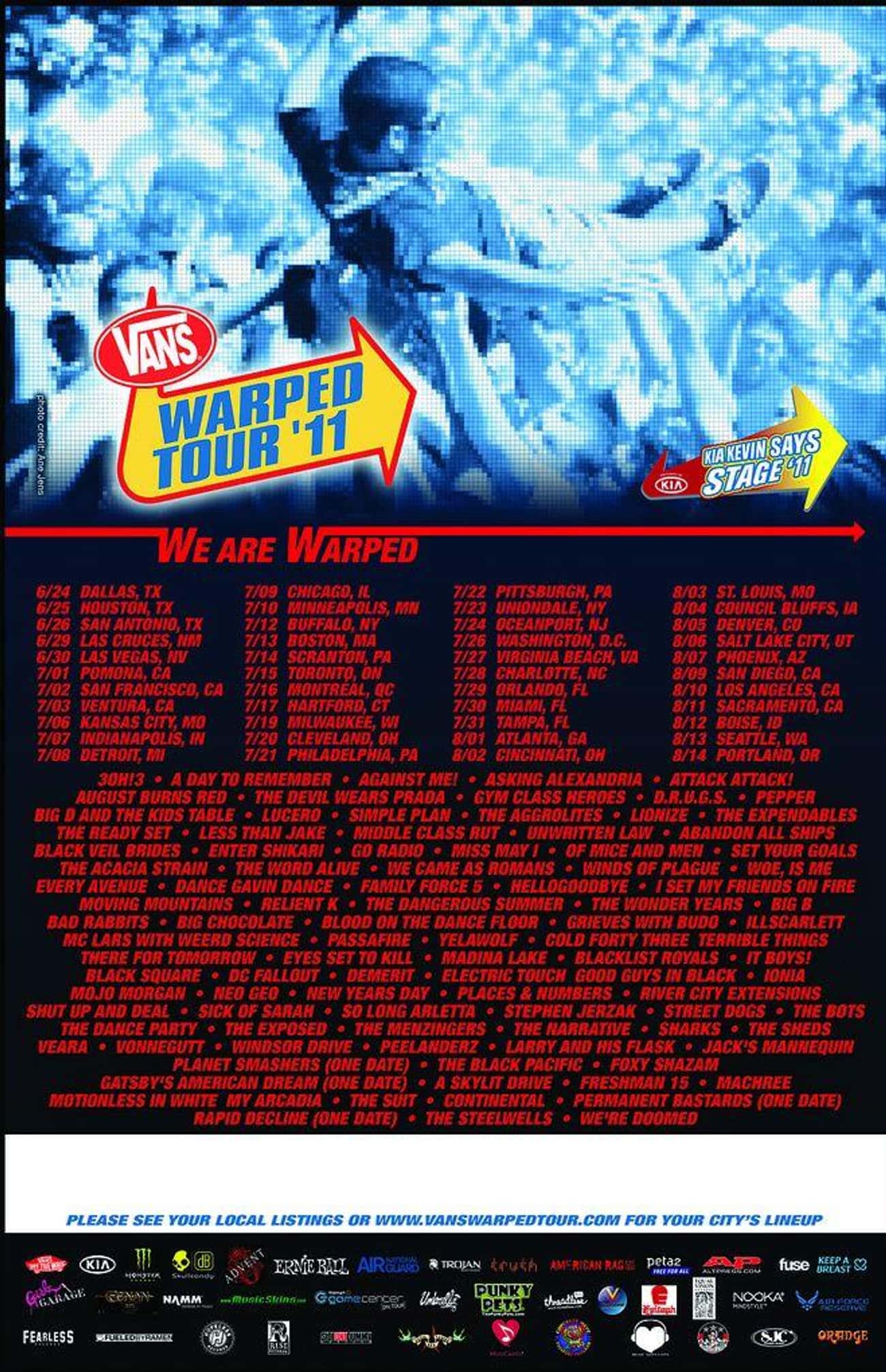
Notable Performers: Paramore, Jack's Mannequin, Bowling for Soup, Relient K, MC Lars, Less Than Jake, Anti-Flag, Simple Plan
Dates: June 24 to August 14
Warped Tour 2008
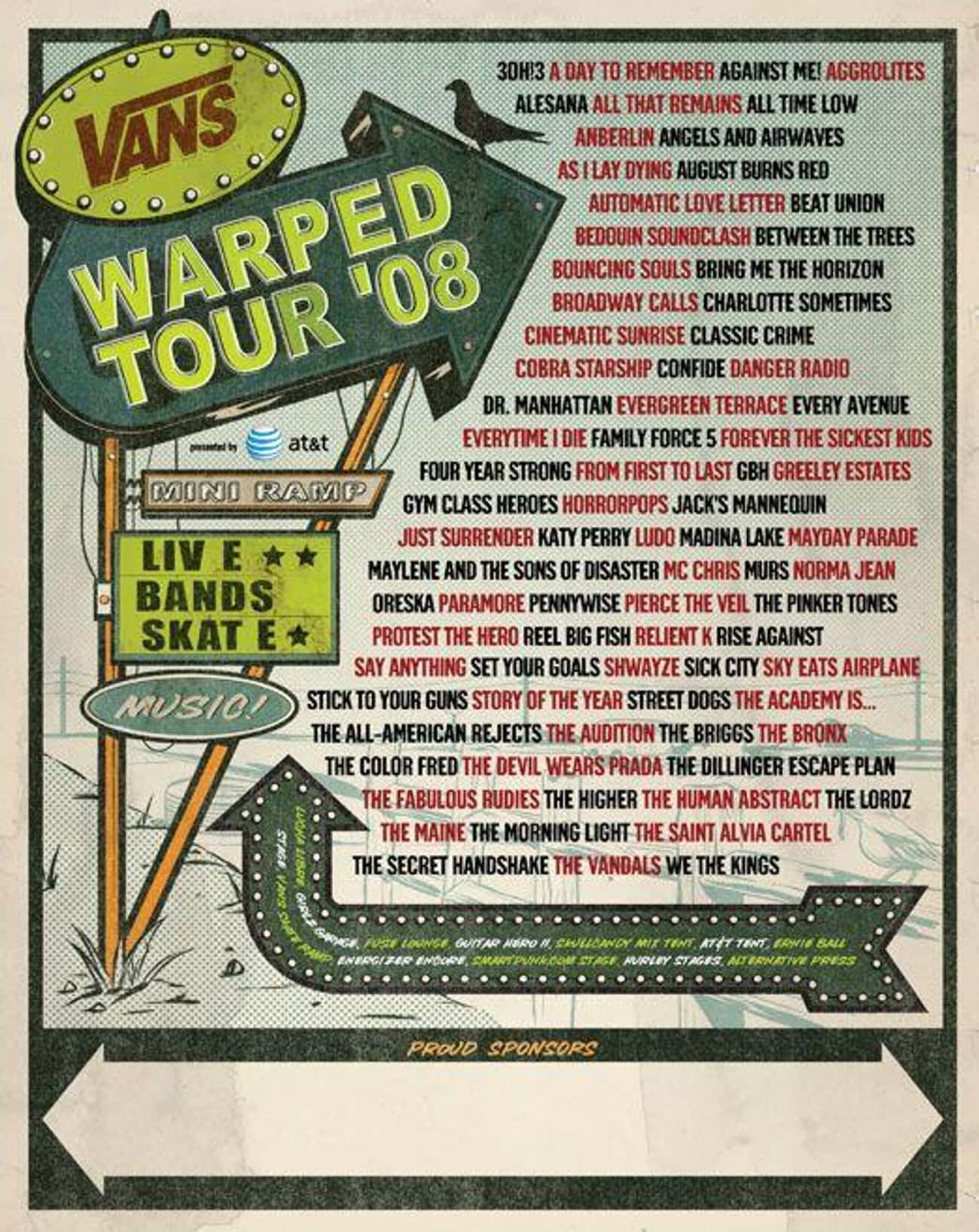
Notable Performers: Katy Perry, Amberlin, Jack's Mannequin, Angels and Airwaves, Reel Big Fish, The Dillinger Escape Plan, Broadway Calls, The Devil Wears Prada
Dates: June 20 to August 17
Warped Tour 2002
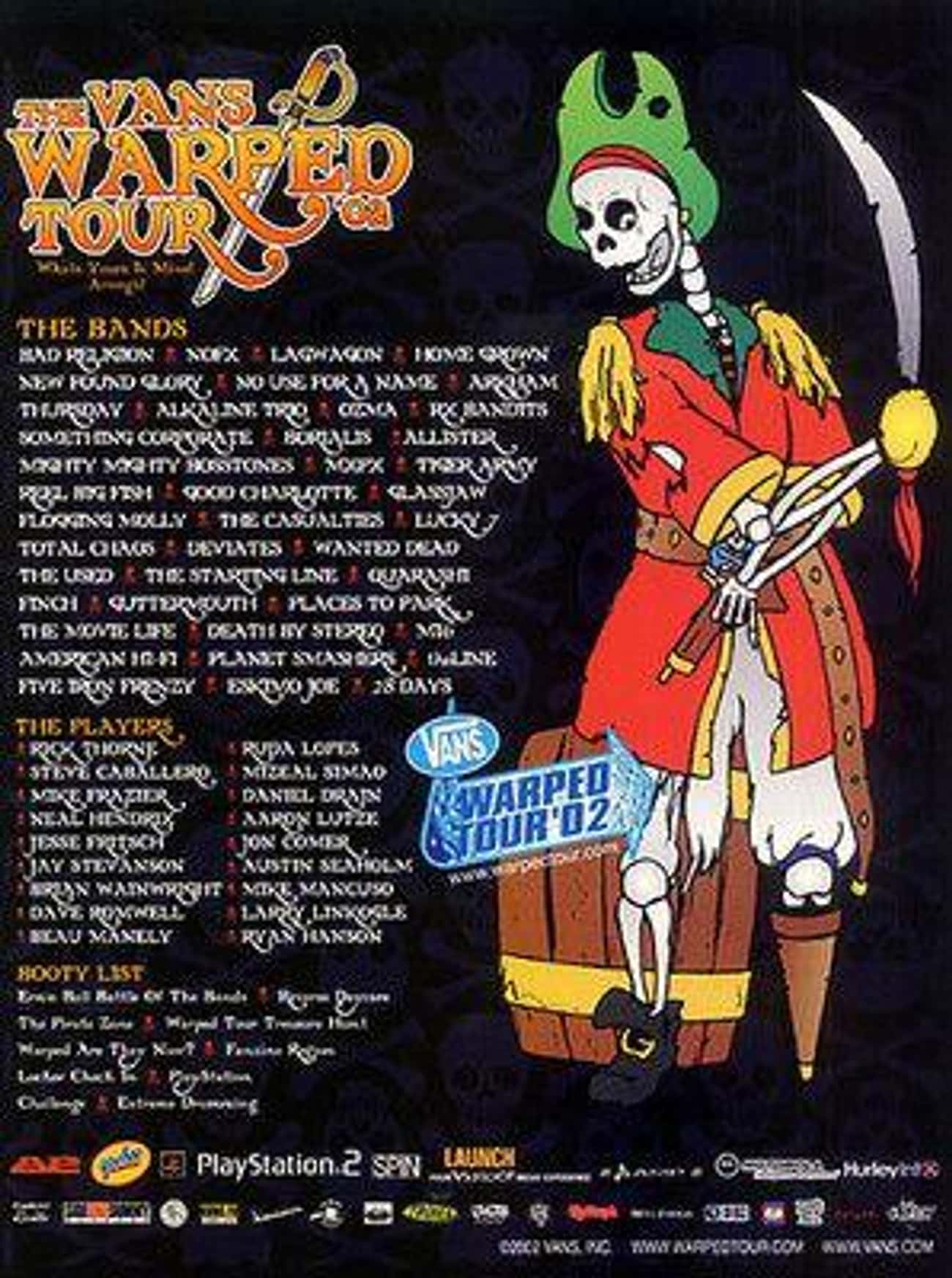
Notable Performers: New Found Glory, Simple Plan, Flogging Molly, Anti-Flag, Reel Big Fish, Yellowcard, Goldfinger, NOFX, Jimmy Eat World, Bad Religion, Good Charlotte
Dates: June 21 to August 18
Warped Tour 1996
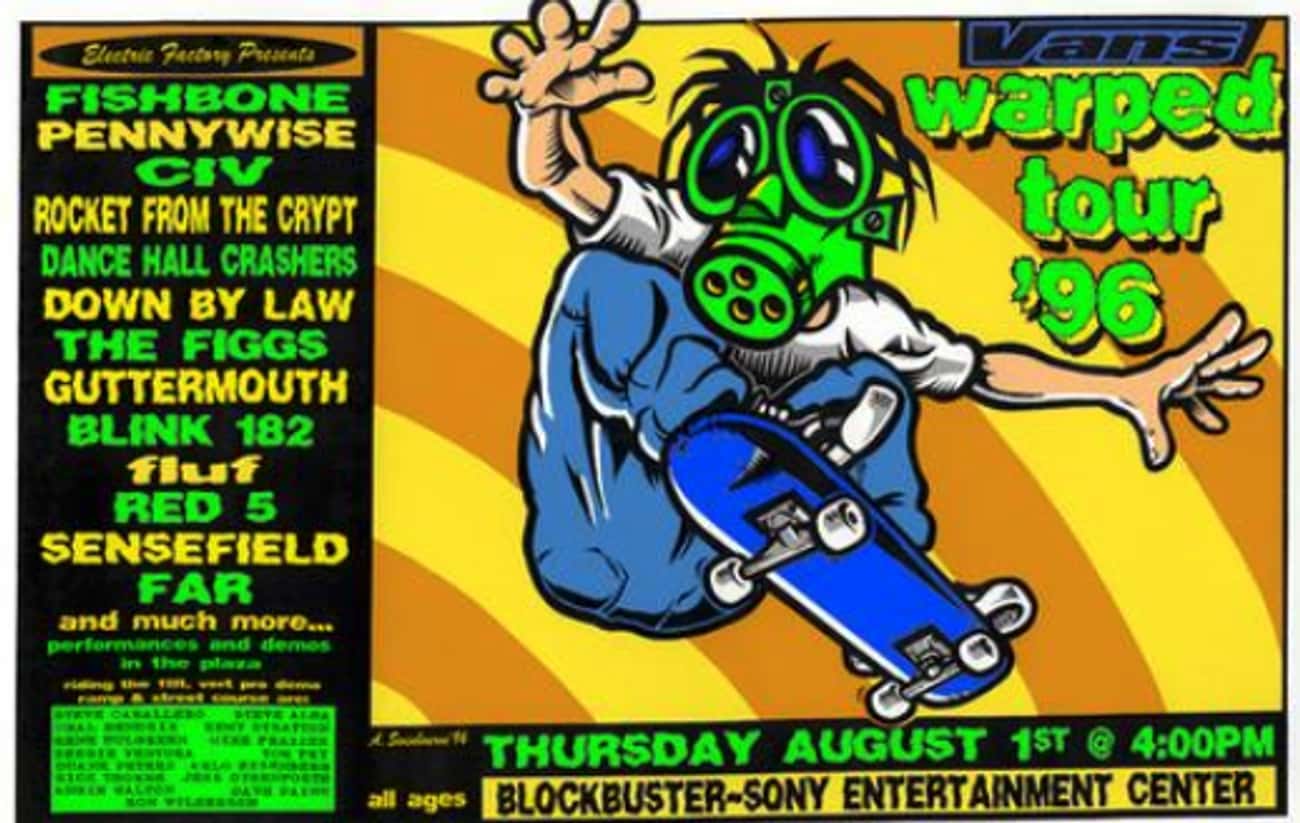
Notable Performers: Fishbone, Pennywise, CIV, Rocket From The Crypt, Dance Hall Crashers, Down By Law, The Figgs, Guttermouth, Blink-182, Fluf, Red 5, Sensefield, Far
Date: July 4 to August 8
Warped Tour 2006
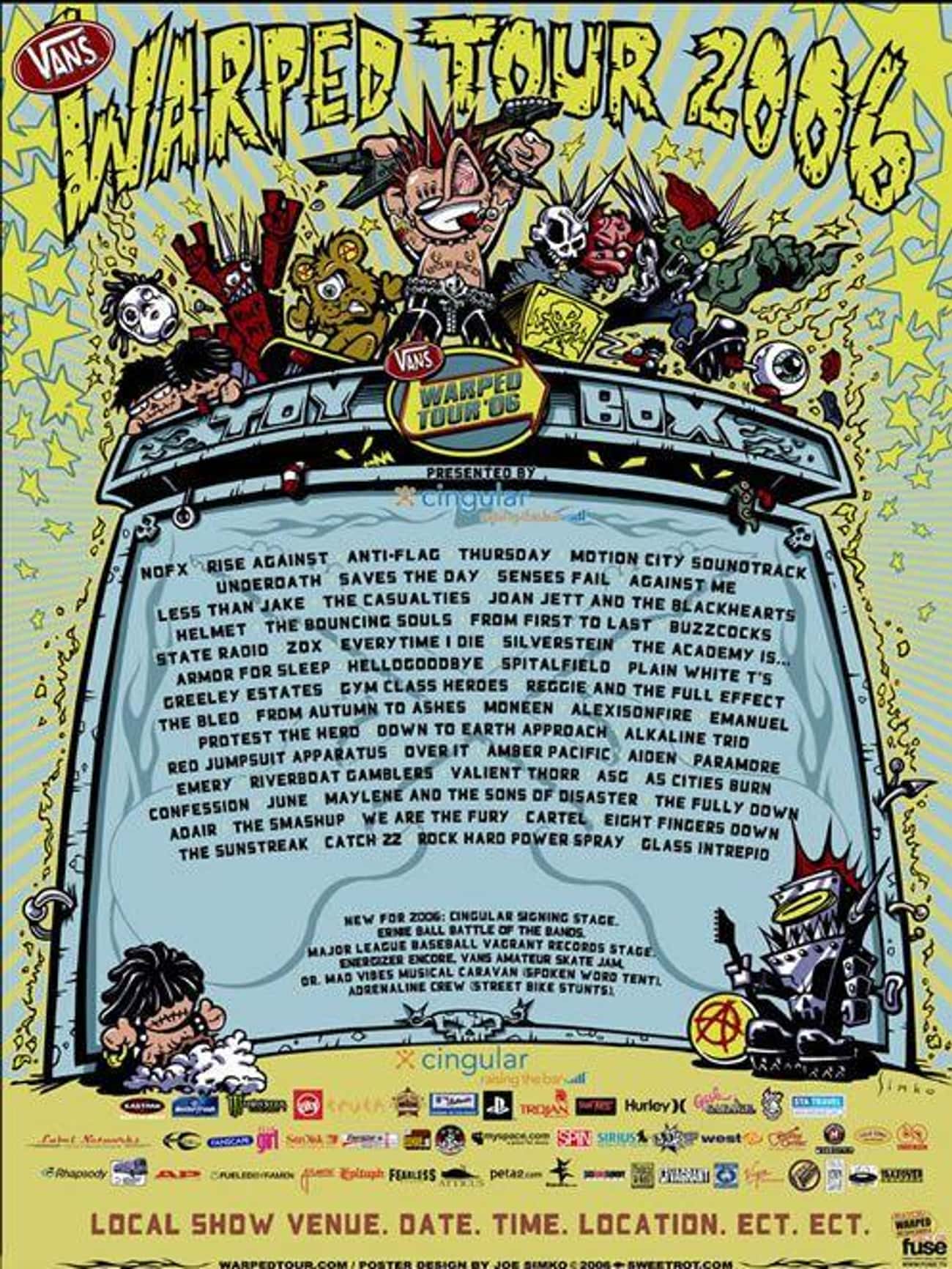
Notable Performers: Joan Jett and the Blackhearts, Less Than Jake, The Academy Is..., Anti-Flag, Billy Talent, Motion City Soundtrack, Paramore, Rise Against, NOFX
Dates: June 15 to August 13
Warped Tour 2003
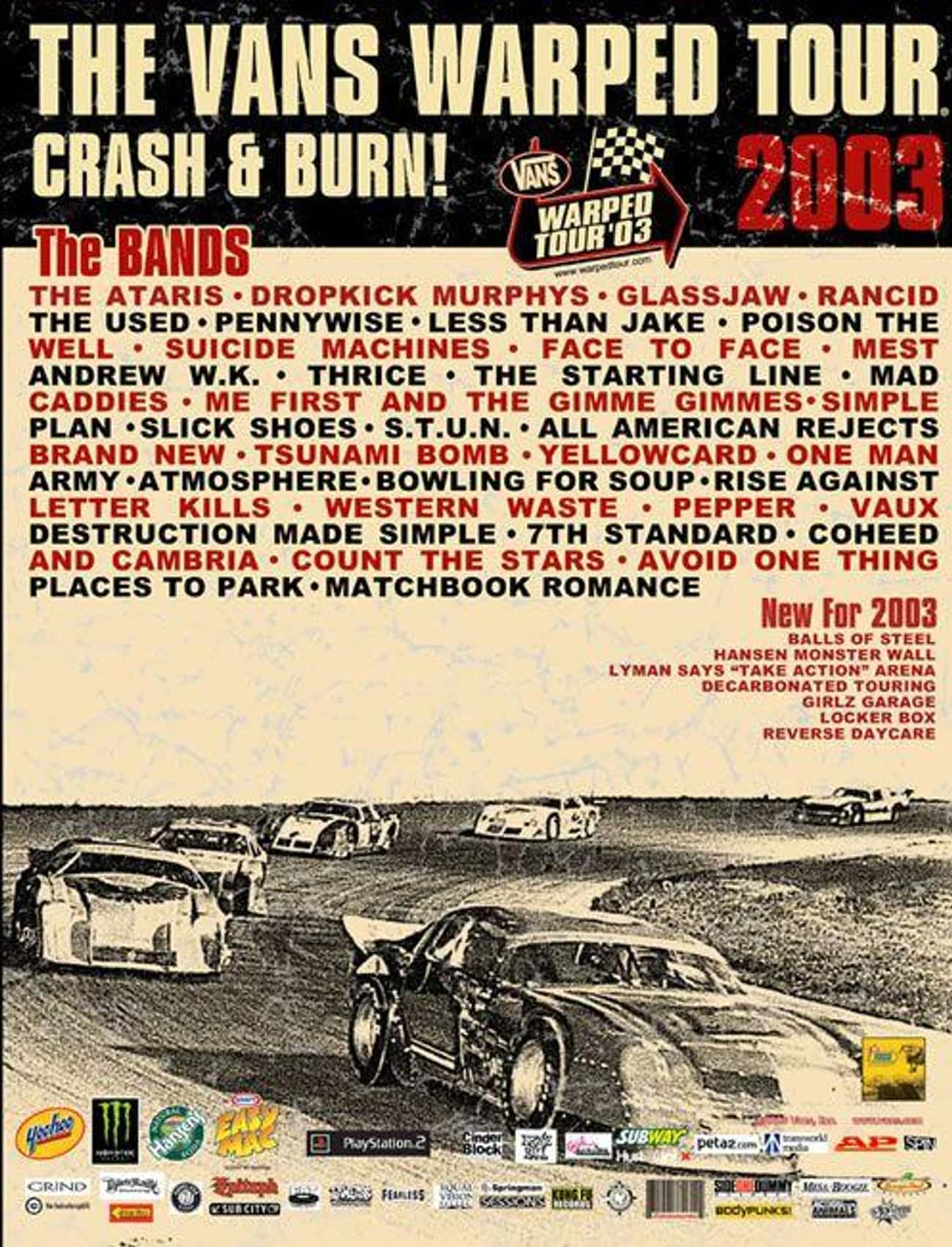
Notable Performers: The Ataris, Dropkick Murphys, Rancid, The Used, Pennywise, Less than Jake, Suicide Machines, Andrew W.K., Yellowcard, Glassjaw
Dates: June 19 to August 10
Warped Tour 2016

Notable Performers: Falling In Reverse, Less Than Jake, Good Charlotte, Sleeping With Sirens, New Found Glory, Yellowcard, Ghost Town, Bad Seed Rising, We The Kings
Dates: June 24 to August 13
Warped Tour 2013
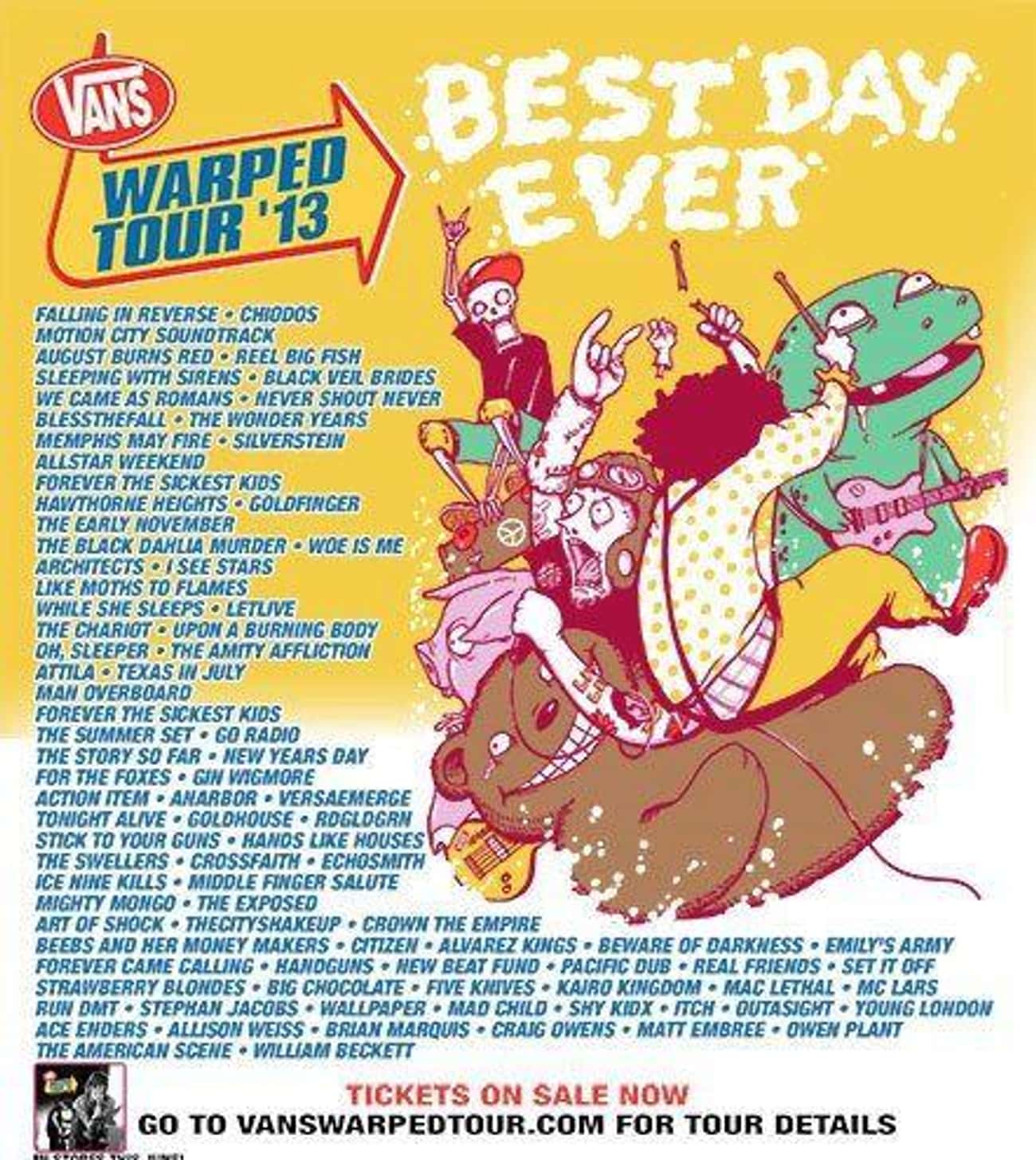
Notable Performers: Chiodos, New Beat Fund, Gin Wigmore, MC Lars, Craig Owens, Dia Frampton, Charlotte Sometimes, Big Chocolate, Echosmith, Motion City Soundtrack, Reel Big Fish
Dates: July 15 to August 4
Warped Tour 2019

Warped Tour 2010
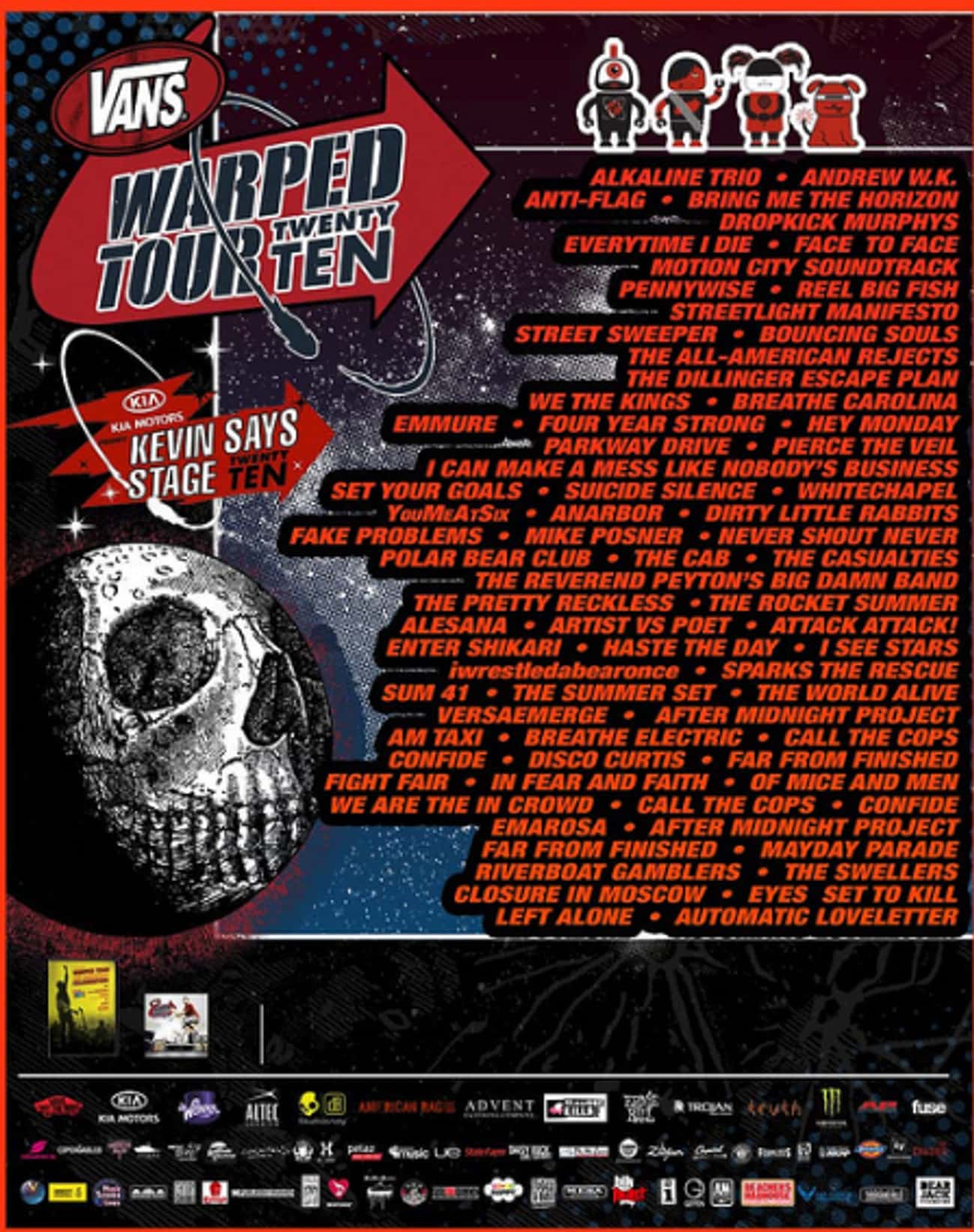
Notable Performers: Alkaline Trio, Motion City Soundtrack, Anti-Flag, Dropkick Murphys, Andrew W.K., Penny Wise, Reel Big Fish, The All-American Rejects, Suicide Silence, We The Kings
Dates: June 25 to August 15
Warped Tour 2012
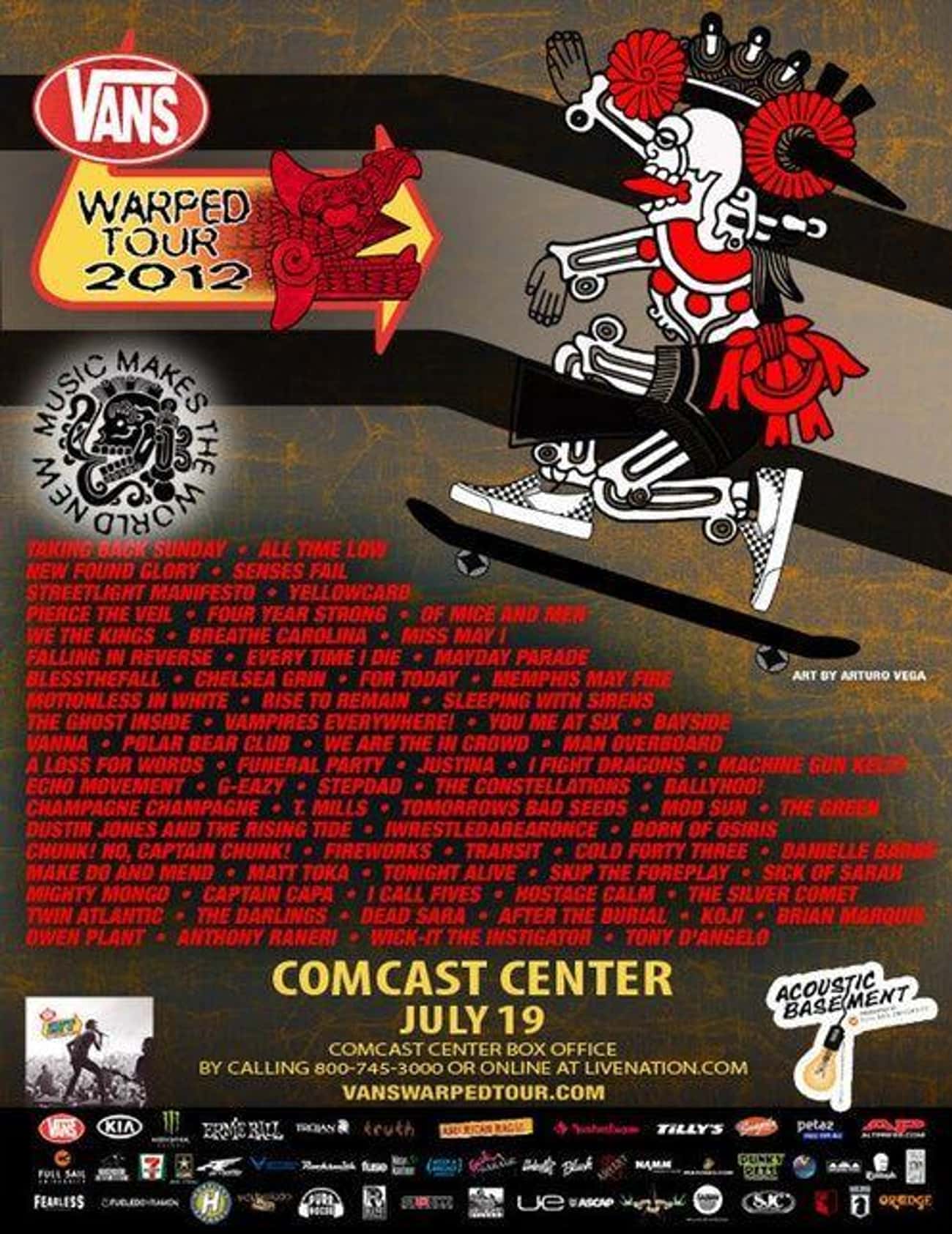
Notable Performers: Falling in Reverse, The Used, Yellowcard, Dead Sara, Rise Against, Yellowcard, MC Laws, Machine Gun Kelly, Anti-Flag
Date: June 16 to August 5
Warped Tour 2009
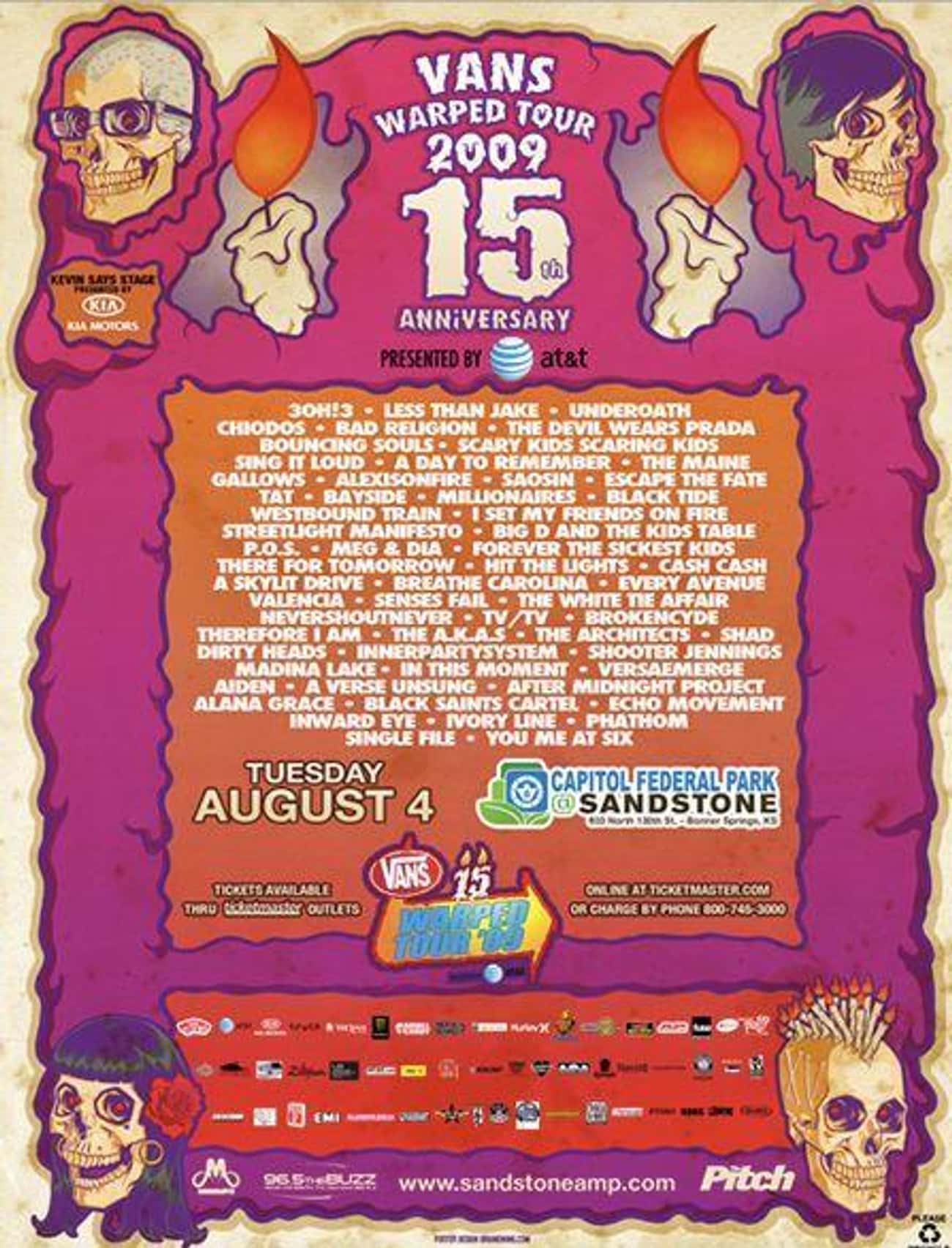
Notable Performers: Less Than Jake, Underoath, Bad Religion, T.S.O.L., The Adolescents, Sing it Loud, TAT
Dates: June 26 to August 23
Warped Tour 2014
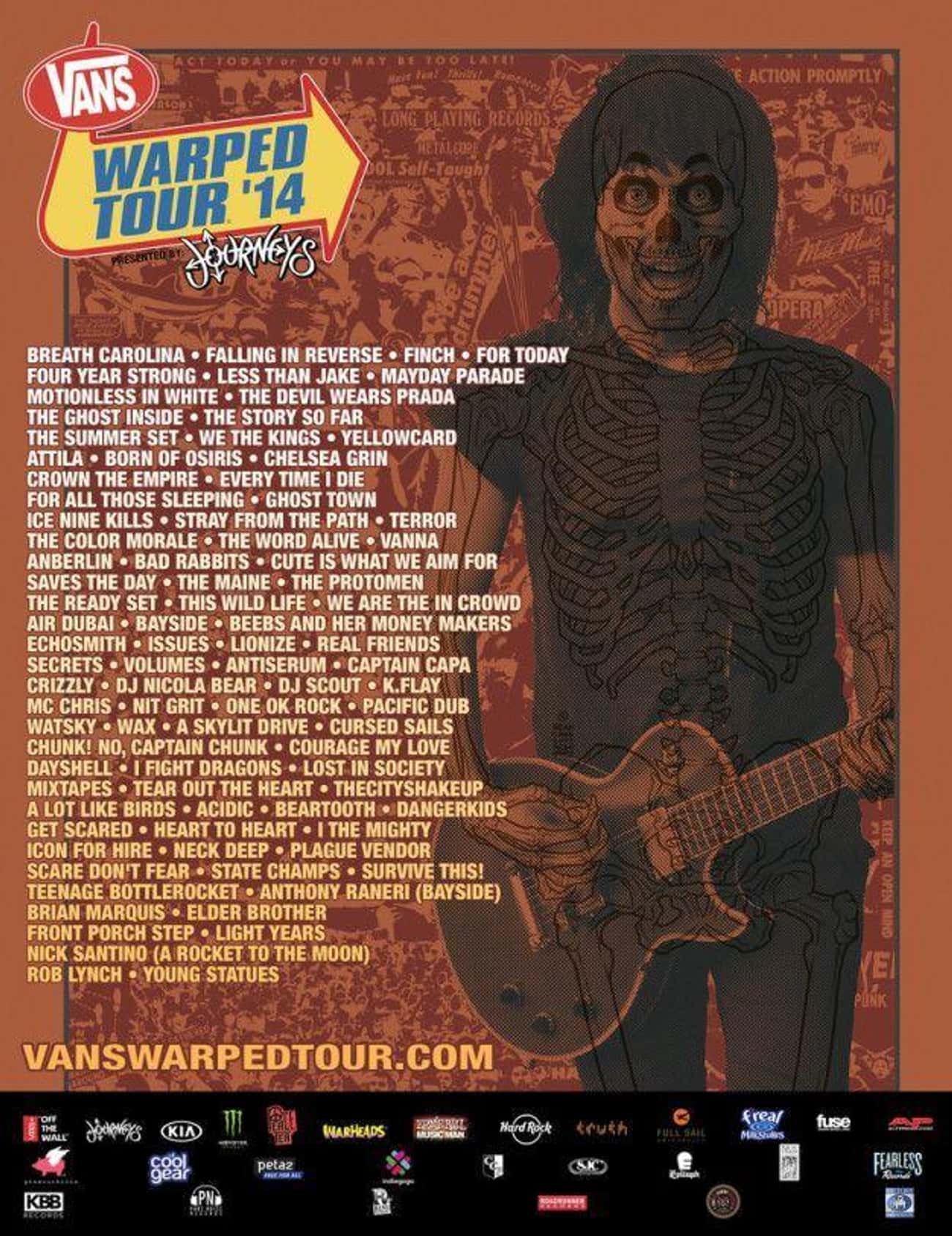
Notable Performers: Breathe Carolina, Falling in Reverse, Mayday Parade, Less Than Jake, We The Kings, Yellowcard, The Ghost Inside, The Mighty, Finch
Dates: June 13 to August 3
Warped Tour 2017
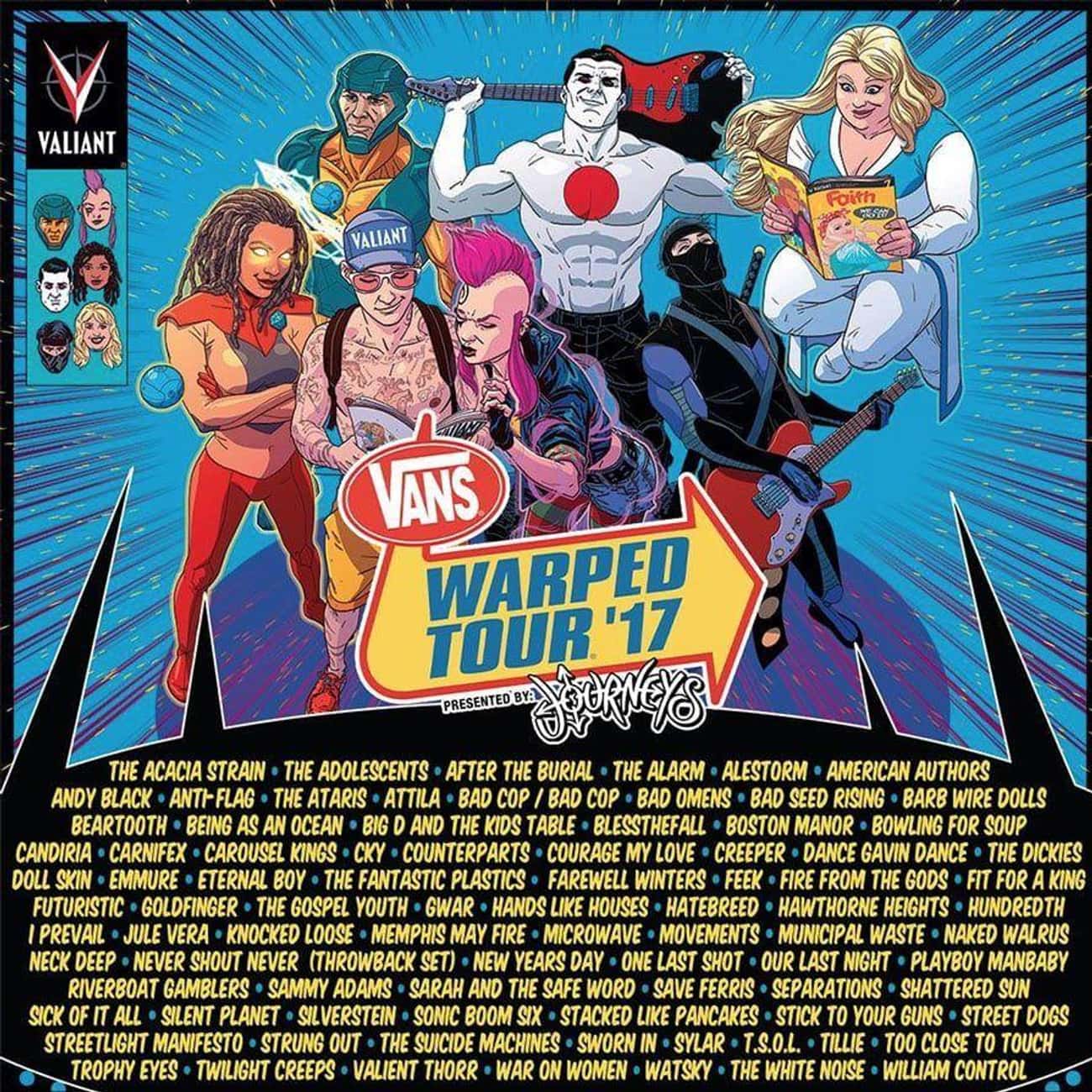
Notable Performers: Andy Black, Beartooth, Dance Gavin Dance, I Prevail, New Years Day, Falling In Reverse, Streetlight Manifesto, Neck Deep
Date: May 27 to November 1
Warped Tour 2015
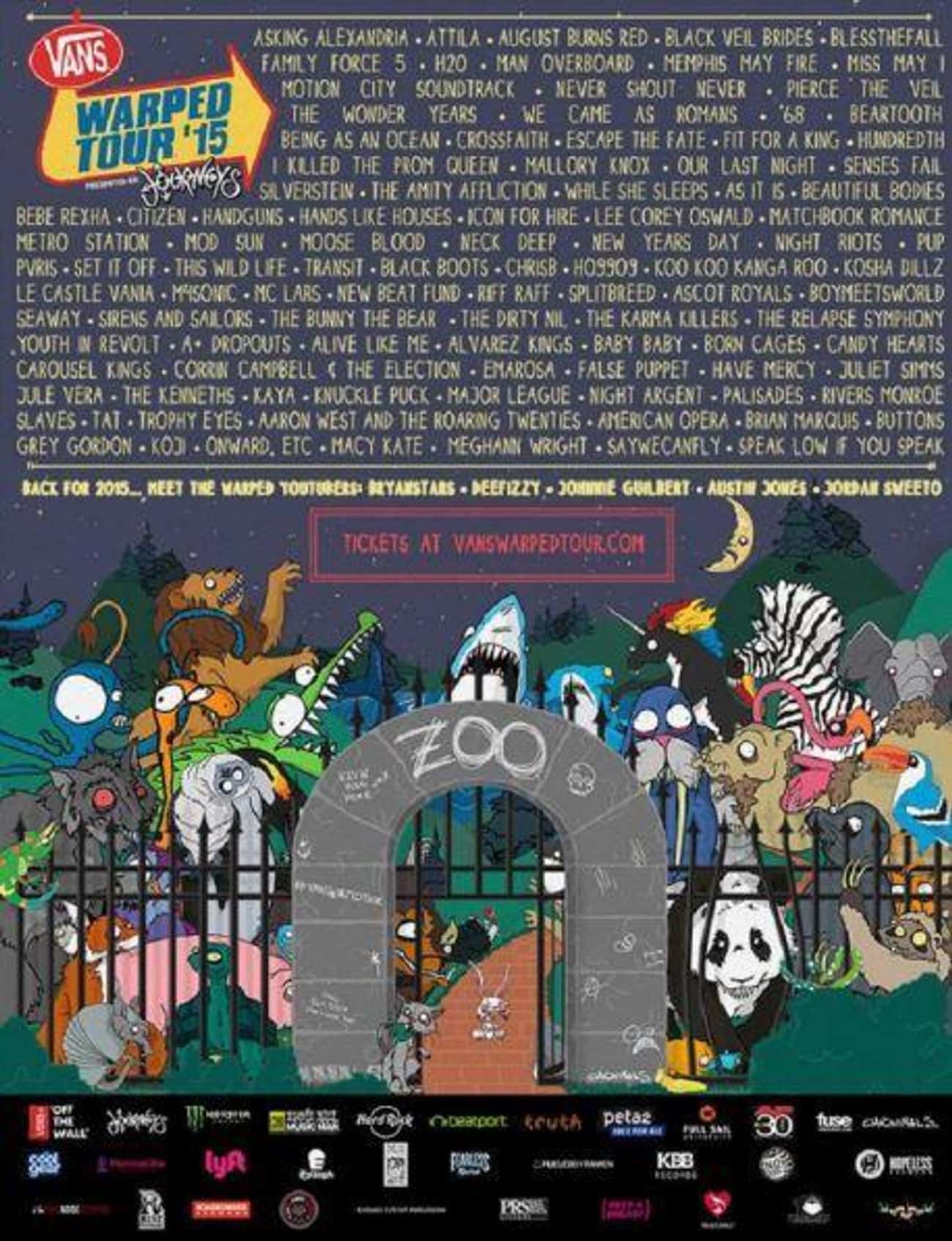
Notable Performers: As It Is, Bebe Rexha, New Years Day, Knuckle Puck, Metro Station, Candy Hearts, Motion City Soundtrack, Memphis May Fire
Dates: June 19 to October 18
Lists about the phenomena of the summer music festival - who to see, how to dress, and what to expect beyond heat, crowds, and bigger crowds.

- Skip to Nav
- Skip to Main
- Skip to Footer
How 23 Years of Warped Tour Changed America
Please try again
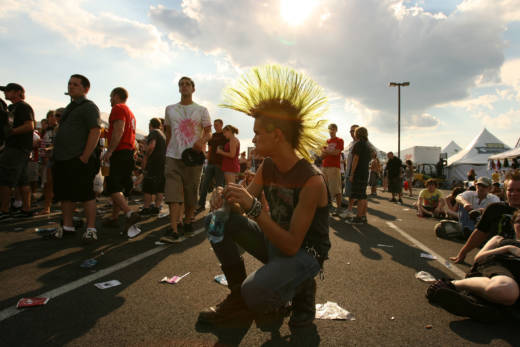
After almost a quarter of a century, and having showcased upwards of 1700 bands, Warped Tour as we know it will come to an end when summer 2018 does. For the most mainstream of Americans who never attended, the tour always looked like an outlier -- a noisy summertime day out for the same kids that shopped at Hot Topic, wore too much eyeliner, and learned HTML by editing their MySpace profiles. Truthfully though, Warped Tour's impact on mainstream pop culture was enormous.

Warped Tour started out scrappy. It was 1995, pop punk was just starting to explode out of the underground -- thanks to Green Day's major label debut, Dookie -- and founder Kevin Lyman , having spent three years working on the Lollapalooza tour, recognized a gap in the festival market. That first Warped was 25 dates -- a breeze for bands and crews who later got used to the jaunt going on for twice as long. No one could foresee back then just how big -- or long-running -- this juggernaut would become.
While Warped's biggest impact has been taking underground culture and smearing it across America in broad daylight every summer, what is so often forgotten is that this was also the venue used by the likes of Katy Perry and Eminem to launch their careers to wider audiences. It's where Sonny Moore started out (in a band named From First to Last ) before he metamorphosed into EDM megastar, Skrillex . It's where No Doubt spent their summer the year before they exploded on a global scale.

Dominic Davi , Oakland-based bassist of Tsunami Bomb , has been attending Warped since 1995 and playing it since 2001. "It's so easy to forget now," he says, "but when it started, and for a long time into it, the bands Warped Tour was assembling did not get played on the radio. They were not featured on festival lineups. Kevin Lyman helped shine a light onto all these bands that were drawing various amounts on their own, but together could fill a festival. That took a lot of vision."
"In the end," Davi continues, "Warped launched all these careers and was directly responsible for the punk rock explosion that happened in the early 2000s. That's quite a feat."
Warped Tour, especially in its earliest years, acted this way, year upon year, launching artists out of obscurity and into the eyeline of the mainstream. Blink 182, a band that was long considered too crude and provocative for mainstream success, appeared on three out of the four Warpeds between 1996 and 1999. It's no coincidence that by 2000, they were one of the biggest bands in the country.
Not only did Warped change how punk rock was treated by mainstream music culture, it had an indelible impact on the lives of the thousands of people who lived and worked on the tour over the years, some of whom came back annually, without fail. Along the way, it also helped to further unify a nationwide community of punks, rebels, and renegades.
Dominic Davi compares spending a summer on the tour to "running away with the circus." Photographer Lisa Johnson , whose work documenting Warped Tour has been featured on the covers of several official compilations, as well as in the book, Misfit Summer Camp: 20 Years on the Road With Vans , elaborates: "Warped Tour is a place where seemingly anything is possible. Utopia. Hard work and happiness, plus some fun in the sun. There is just always something magic in the air."
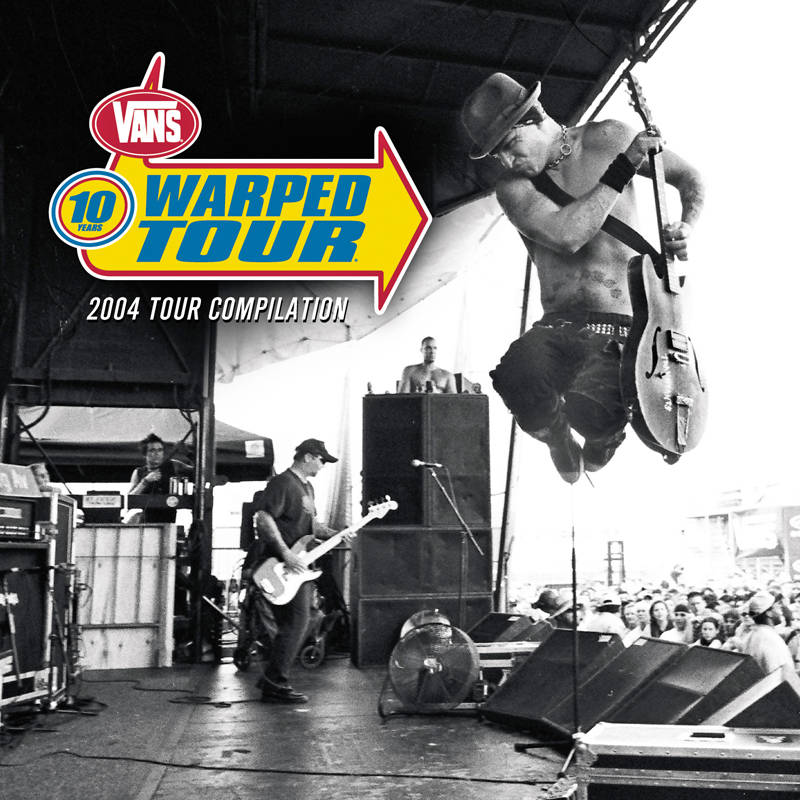
The unique spirit of Warped is precisely why hundreds of people have stepped up, year after year, to work in unbearably high temperatures, notoriously dusty environs, facing parking lot after parking lot with few views of the outside world (unless you count the occasional midnight trip to Wal-Mart) for weeks on end.
It's difficult to fathom why anybody would want to spend an entire summer in those conditions -- until you actually do it. In 2006, I joined Warped Tour for five days to write a story for a British rock magazine. Somehow, five days turned into seven weeks. I skipped my flight home to sell merch for one of the bands I had met along the way, and had zero regrets about hitting 'pause' on the rest of my life to do so.
For thousands of us, Warped has always been that way -- once you get caught in its vortex, it's hard to extricate yourself from it. "It's this huge production," Davi says, "with so many moving parts. It's hard work. You are moving all day. I think you have to be a particular personality to love that life. I always did."
The video below that Lisa Johnson took at a backstage party in 2014, effectively sums up the hilarity, unified chaos, and good-natured anarchy of Warped Tour (and also why the nightly after-show barbecues have become the stuff of legend). Take into account that the people you see in this clip are the people working the tour -- crew members, band members, merch people, stage hands. Work days may be long and conditions may sometimes be hard, but on the best nights, this is what happens once the ticket-buying public leaves:
There's no doubting that in recent years Warped Tour has, to some degree at least, lost its niche, while also weathering some damaging storms. "In many ways," Davi notes, "I think when the bands on the tour became bands that the radio and MTV embraced, it became harder to preserve that core exclusivity and unique feeling that Warped Tour had. At first it made the tour bigger, but having to chase the trends and adapt to bands with more exposure, I think made it more difficult to make the tour a special experience. By trying to please everyone they had a harder time pleasing anyone."
The summer tour's time might be drawing to a close, but Warped promises to live on in other capacities: there will be some sort of 25th anniversary celebration, and the first Warped Rewind at Sea cruise just happened last month. More than that though, the tour leaves behind a legacy. It impacted a couple of generations of punk, emo and hardcore bands, as well as their fans. Warped brought a newfound acceptance of alternative culture to all corners of the country. It was a confidence builder for teens who felt alienated in their suburban high schools; it was a training camp for small bands, and a springboard for larger ones; and, for a long while there, it fundamentally changed the fabric of alternative music in America.

Thanks for signing up for the newsletter.

/cdn.vox-cdn.com/uploads/chorus_image/image/64789449/GettyImages_71599352.0.jpg)
Filed under:
How Warped Tour led the consumerist music festival revolution
The iconic festival was as much about brands as it was about bands.
Share this story
- Share this on Facebook
- Share this on Twitter
- Share this on Reddit
- Share All sharing options
Share All sharing options for: How Warped Tour led the consumerist music festival revolution
Most of what I remember about being 14 involves wanting stuff: I wanted straighter hair. I wanted to seem like a grown-up (or at least like a 16-year-old). And I really, really wanted to go to Warped Tour.
It was the summer of 2004, and pop-punk was ascendant. In Canada, where I grew up, this meant listening to a steady stream of Sum 41, Avril Lavigne, Simple Plan, and Billy Talent — all homegrown acts that got regular radio play thanks in part to Canadian content laws . With that as our gateway, my friends and I began our foray into skate-punk lite, memorizing Taking Back Sunday lyrics, trying (poorly) to land an ollie , and developing extremely unrequited crushes on any boy who bore a passing resemblance to Blink-182’s Tom DeLonge.
To us, Warped Tour — the traveling “misfit summer camp” that merged punk, ska, rock, and emo with extreme sports and a healthy array of corporate sponsors — was the pinnacle of cool. Unfortunately, I never got to attend, on account of being at actual summer camp.
This summer, Warped Tour celebrates its 25th birthday, making it far older than the teenagers it has courted for two and a half decades. Last year was the tour’s final cross-country run — it featured hundreds of bands over the course of 38 stops for which nearly 550,000 tickets were sold, but this impressive turnout was buoyed by the announcement that it was the event’s last hurrah. Attendance the prior year, in 2017, had been down significantly, particularly among the 14- to 17-year-old demographic that had historically been Warped’s lifeblood. The audience was getting older, production costs were rising, and bands weren’t sticking around year after year like they used to. Plus, according to founder and producer Kevin Lyman, he was just getting tired.
But in the era of reboots and remakes , it’s not surprising that organizers would want to honor the tour’s silver anniversary just one year after it shut down. The result is a three-city affair: a single-day event in Cleveland celebrating the opening of a retrospective exhibit at the Rock & Roll Hall of Fame, and weekend shows in Atlantic City, New Jersey, and Mountain View, California. While not strictly a nostalgia play — there are up-and-coming bands booked alongside veterans, and plenty of fans are first-time Warped attendees — this year, the average age of concertgoers appears to be more than a decade older than it was at the tour’s height (15 or 16, as of 2006 ), and plenty of the once-wayward youth now have kids of their own in tow, keeping them a safe distance from the mosh pit.
:no_upscale()/cdn.vox-cdn.com/uploads/chorus_asset/file/18327147/GettyImages_1162641161.jpg)
This is how, on a Saturday in late June, I find myself on a crowded Jersey beach sandwiched between Caesars Casino and the Atlantic Ocean, belting out Simple Plan’s “I’m Just a Kid” with nearly 30,000 other people — many of whom, like me, were in fact kids when the song came out in 2002. High school may be a distant memory, but at least now I’ve finally made it to Warped Tour.
”Oh, my god, I am 12 years old again,” says the sunburnt guy in checkerboard Vans beside me as the crowd whines along with singer Pierre Bouvier: “Nobody cares, ’cause I’m alone and the world is having more fun than me tonight.”
The lyrics don’t exactly fit the setting — no one here is alone and everyone seems to be having fun — but the feeling’s still there. For a little while, we’re all our angsty teen selves again. Likewise, there’s a twinge of irony when Good Charlotte tear into their breakout single “Lifestyles of the Rich and Famous,” a middle finger to celebrity culture written long before Joel and Benji Madden (the band’s lead singer and guitarist) married Hollywood it-girls (Nicole Richie and Cameron Diaz, respectively).
Warped Tour itself is a contradiction — it’s a punk rock festival that’s also a prodigious marketing machine, sponsored from top to bottom by brands hoping to win over fans in between shows. This isn’t a knock on the tour, really: if it weren’t able to bridge that gap, it probably wouldn’t exist.
The idea for Warped began germinating while Kevin Lyman was working as a stage manager for the alt-rock-focused Lollapalooza in the early ’90s — back when that, too, was a touring festival. He had been immersed in SoCal’s hardcore and ska scenes growing up and wanted to bring some of his favorite bands to audiences around the country with a back-to-basics tour that did away with the music industry’s hierarchies and out-of-control egos: no headliners, no arenas — just a few thousand fans in a parking lot and an average ticket price of less than $30.
Even for the biggest acts, that DIY spirit shone through. “You feel more like a carnie on Warped Tour than you do on any other tour or at any other festival,” says Adam Lazzara, the lead singer of Taking Back Sunday, who are currently in the midst of a 20th-anniversary tour , “just because you’re literally there setting up and breaking down into the next town.” Lyman also tapped a handful of pro skateboarders and BMX bikers to come along, recognizing the crossover between extreme sports fans and punk rock’s moshing masses, as well as the fact that both subcultures were becoming increasingly mainstream.
:no_upscale()/cdn.vox-cdn.com/uploads/chorus_asset/file/18327179/GettyImages_75853548.jpg)
In 1995, the same year Warped made its debut run in the summer, ESPN aired the inaugural X Games (then called “Extreme Games”), with athletes competing in action sports such as barefoot water skiing, street luge, and skateboarding. The year prior, the Offspring and Green Day — both bands with roots in California’s underground punk scene — released best-selling albums that catapulted them into popular culture.
The time was ripe for something like Warped to exist, though in order to get it off the ground, Lyman needed to buck one of the central tenets of punk and get a few executives to break out their checkbooks. “I grew up with that whole ‘eff corporate America’ mentality,” he says. “And then, for me, I just started looking at corporate America, and no matter how punk rock we were or whatever, we were still supporting it in some way. We were buying their brands; we were using their products.” He looked at the Rolling Stones pulling in millions through sponsorships with Jovan fragrance and Budweiser, and thought: Maybe we can get some money too.
It didn’t go seamlessly at first. After the 1995 run — which featured an eclectic lineup that included the ska-reggae band Sublime, a Tragic Kingdom -era No Doubt, and the grunge pioneers L7 — the tour was in dire straits financially, as the small sponsorships Lyman had landed from brands like Converse and Spin weren’t enough to cover the significant production costs. To keep it going, he was desperate enough to consider brokering a deal with the decidedly not-punk Calvin Klein to become the title sponsor. “I don’t really think that would have worked,” he now says, matter-of-factly.
Fortuitously, the meeting with the fashion brand was delayed by the devastating East Coast blizzard of 1996, and before they could go any further with the arrangements, Lyman got a call from Vans CEO Walter Schoenfeld.
:no_upscale()/cdn.vox-cdn.com/uploads/chorus_asset/file/18327225/GettyImages_121430810__1_.jpg)
Founded in 1966 as the Van Doren Rubber Company, Vans had engendered strong ties to the skateboarding community, which was loyal to the brand’s sneakers thanks to their grippy soles. The $300,000 check the company wrote turned the Warped Tour into the Vans Warped Tour, giving Lyman some financial runway while securing the festival’s ties to corporate America. (At the time, Vans was owned by the venture banking firm McCown De Leeuw & Co., thanks to a $71 million 1988 leveraged buyout .)
The Warped partnership was led by Steven Van Doren, the company’s vice president of events and promotions and the son of Vans founder Paul Van Doren, who saw an opportunity to give the brand national exposure beyond the Sun Belt states that at the time accounted for most of its sales. He also introduced amateur skateboarding competitions to the tour, giving contestants the chance to win pro contracts with Vans. “Having Steve involved really solidified our partnership,” says Lyman, noting that he turned down bigger subsequent sponsorship offers from the shoe brand Airwalk because he felt Vans was in it for the long haul.
He was right: By 1999, Spin reported at the time, Vans owned a 15 percent stake in Warped and was paying $1 million per year “to strengthen [its] presence with ‘Generation Y’” (or, as we’d call them today, “millennials”). Two years later, it stepped up its investment, paying $5.2 million for a 70 percent controlling stake, according to Forbes .
Today, Vans is a $3 billion brand — current parent company VF Corp bought it for $396 million in 2004 — and a household name for most Americans, including those who have never set foot on a skateboard. Even as it has grown well beyond its fringier roots, though, the brand’s relationship with Warped has endured, and at the 25th-anniversary show, seemingly every other fan is wearing Vans sneakers: Sk8-Hi’s , Old Skools , the ubiquitous checkerboard slip-ons .
(Airwalk fizzled by the early 2000s and was reborn as a Payless brand; its current owners — the same company that recently acquired Sports Illustrated — are trying to stage a ’90s-nostalgia-fueled comeback .)
:no_upscale()/cdn.vox-cdn.com/uploads/chorus_asset/file/18327249/GettyImages_2278931.jpg)
Even with the Vans investment, Lyman had to hustle to keep the tour afloat in the early years. “We had to raise nearly $4 million in sponsorships to make the ticket price what it was, to give you the show you wanted, to bring all those side stages that developed young artists,” he says.
In 1999, he signed a partnership with the brand new surf label Hurley and got up-and-comers Blink-182 — then still a year out from the explosively popular Enema of the State — to wear the brand’s clothes onstage in exchange for free seats on one of the Warped Tour’s buses, since the band couldn’t yet afford their own transportation. It was a turning point for both band and brand: Blink had just replaced its former drummer with Travis Barker, who’s still with the group today, and Hurley’s founder Bob Hurley had left a successful career with Billabong to start his namesake clothing line earlier that year. Four years later, Blink was selling out arenas and topping Billboard charts, and Hurley had grown into a $70 million business, which Nike acquired in 2002 .
It wasn’t just hormone-addled fans going through an adolescence of sorts at Warped. “I always said Warped was a developmental spot, not only for bands but for crew people to learn how to tour and learn how to be good citizens in the music community, as well as brands,” says Lyman. “A lot of brands got their starts in those parking lots.”
One of those was Monster Energy, which has been a tour sponsor since it launched in 2003, back when it was made by a California soda company called Hansen’s Natural Co. The company set up a portable rock wall, became “the official energy drink of the Vans Warped Tour,” and embarked on a wildly successful rebrand that has seen its stock soar more than 72,000 percent since its public debut that same year. According to Lyman, Monster also came up with the idea of “Tour Water” — specially designed cans of water that make it look like bands and crew members are chugging energy drinks all day onstage without the risk of cardiac arrest; the concept is now an industry standard, and cans from early tours go for more than $75 on eBay .
Another was Jeffree Star Cosmetics. Before Star was a beauty mogul, he was a MySpace-famous scene kid who performed on the tour as a solo artist in 2008 and 2009. In the following years, he came back to host meet-and-greets with his YouTube fans and, when he launched his makeup empire in 2014, set up shop among the merch tents.
The Warped Tour also forced more corporate brands to loosen up a little: After the PlayStation team showed up in uniform polo shirts their first year on the tour, Lyman told them they’d have to change, citing a life motto of his: “Never trust a person in a golf shirt unless you’re at a golf course.” (They’re either a douchebag or they don’t know what they’re talking about, he says.)
:no_upscale()/cdn.vox-cdn.com/uploads/chorus_asset/file/18327337/GettyImages_563544817.jpg)
When the tour created a “reverse day care” for parents on-site in 2001 — complete with air conditioning and noise-canceling headphones — Lyman convinced Target to put its bull’s-eye logo on top, sans brand name, citing the symbol’s history with ’70s mod bands like the Who and the Jam. He even dug out the Ramones’ tour rider to persuade the makers of Yoo-hoo that the chocolate drink was, in fact, kinda punk rock, and by the 1998 tour, fans were climbing a rock wall shaped like a giant Yoo-hoo bottle and competing for branded skateboard decks .
Walking around the grounds in Atlantic City, there’s a near-endless array of stuff to buy at Warped this year: limited-edition Vans, commemorative 25th anniversary bracelets, T-shirts reading “Mall Goth Trash” and “SadBoy Crew,” henna tattoos, water bottles, skate decks, and beer koozies (plus $14 Pacifico). There are also plenty of freebies: branded coupon wristbands from the teen retailer Journeys, which has been the tour’s presenting sponsor since 2014; T-shirts from Truth, the anti-smoking organization; stickers from PETA.
Among the panoply of shoppable teenage rebellion are booths with a cause, like Hope for the Day , a suicide prevention organization, and A Voice for the Innocent , a nonprofit that offers resources to survivors of rape and sexual abuse, which was brought on board in the wake of a series of sexual assault and harassment allegations involving artists who had performed on the tour.
”The Warped Tour is really interesting because it jumped early on the idea that crowds could be commodified,” says Gina Arnold, a former rock journalist and the author of Half a Million Strong: Crowds and Power from Woodstock to Coachella . “They were able to widen out the notion of the festival as a marketplace — not so much of ideas, but a marketplace of actual things.”
Today, the concept of festival-as-shopping-mall is well established — so much so that this year’s Coachella attendees could have Amazon orders delivered same-day to lockers on site — but in the ’90s, it was still a novel idea. Before then, it was all “bad food and band T-shirts,” as Arnold put it. (The exception: the parking lot of any Grateful Dead concert, long a thriving marketplace of tie-dye tees , beaded jewelry, DIY taco stands, and any drug you might fancy, collectively known as Shakedown Street .)
:no_upscale()/cdn.vox-cdn.com/uploads/chorus_asset/file/18327422/GettyImages_1012422710.jpg)
Band T-shirts still make up the bulk of the merch at Warped, just as they do at most concerts these days. As album sales have dropped off a cliff and services like Spotify have taken their place, paying a fraction of a penny per stream, merchandise has become an increasingly essential part of artists’ income. A superstar like Taylor Swift or Kanye West can gross $300,000 to $400,000 in merch during a single show, according to a Billboard interview with licensing exec Dell Furano. Warped artists aren’t coming close to that, but especially at the tour’s peak, they were pulling in a good amount of cash.
Taking Back Sunday made a reported $20,000 to $30,000 per show on merch on the 2004 tour; My Chemical Romance set the record the next year, selling $60,000 worth of black T-shirts, sinister-looking posters, and fingerless gloves at a single stop. 2005 was also the only year Warped made money on ticket sales, according to Lyman. Headliners Fall Out Boy and My Chemical Romance were regulars on MTV’s TRL thanks to crossover hits “Sugar, We’re Goin’ Down” and “Helena.” Teens who hadn’t heard of most of the “authentic” punk bands the tour had booked in prior years were turning out in droves. By the end of the 48 dates, 700,000 fans had bought tickets, and the tour grossed an all-time high of $25 million .
”That was a pretty wild year, with all the bands exploding,” says Lisa Johnson, who’s been photographing Warped Tour since its first run. “I’m not gonna lie, it was a little frustrating in the photo pit because it was so jam-packed. And a little dangerous, because there were so many kids coming over the barricade constantly. But at the same time, how fantastic is that?”
Of course, not everyone agreed. From its inception, Warped provoked criticism from punk purists who argued — not without reason — that the corporate-sponsored festival was antithetical to the values of the genre. It also ruffled feathers with the bands it booked, particularly as the rise of “mall punk” and emo put bands like Good Charlotte, Blink-182, and My Chemical Romance alongside punk mainstays like Rancid, Pennywise, and Bad Religion.
:no_upscale()/cdn.vox-cdn.com/uploads/chorus_asset/file/18327484/GettyImages_111561931.jpg)
”You go to the Warped Tour and walk around and you’ll hear 100 bands that try to sound like Green Day or NOFX. It’s just disgusting,” said Mike Avilez, a vocalist for the California punk band Oppressed Logic, in the book Gimme Something Better: The Profound, Progressive, and Occasionally Pointless History of Bay Area Punk from Dead Kennedys to Green Day . “They’re missing the angst. To me, punk rock is supposed to be angry and pissed off.”
The tour has also caught flak from within over the years. In a 2004 Chicago Reader piece , “Punk Is Dead! Long Live Punk!” the music critic Jessica Hopper chronicled a clash between Lyman and a band called the Mean Reds: “It was only the sixth day of the tour, and they were already on ‘probation’ for running their mouths onstage about what a sold-out capitalist-pig enterprise Warped is, how it isn’t really punk, et cetera.”
Even Adweek, hardly a voice of the counterculture, said in 2005 that the influx of corporate cash “does somewhat undermine the legitimacy of the event, even as it introduces groups of men in tight pants to new audiences.”
Among those who’ve been along for the ride since Warped’s early days, though, ambivalence about the scene’s brushes with the mainstream is tempered by ideas both idealistic — that the tour provided a platform to bands that otherwise might not have made it, and a community for kids who didn’t always fit in elsewhere — and practical.
”There’s always going to be critics,” says Shira Yevin, who’s performed at Warped as Shiragirl since 2004, and for a decade produced a stage at the tour dedicated to promoting women-fronted bands. “But they’re the same ones bitching because they only got paid $100 for the gig and they don’t have enough money to get to the next state, you know?”
In 2019, the idea of “selling out” seems like a product of an earlier generation — one without climate change or student loans or school gun violence to worry about. And anyway, the purists may be getting their way for now, since even pop punk isn’t popular these days. Instead, the top 40 charts are ruled by Lil Nas X’s boundary-pushing country trap, genre-fluid acts like Billie Eilish , and mumble rappers like Post Malone. The loud, fast, guitar-driven sound that Warped is known for? “In top 40, it’s very rare,” says Nate Sloan, a musicologist and the co-host of Vox’s Switched on Pop podcast . “Even the bands that sort of assert that look and that style and may throw a guitar around their shoulder, the actual sound doesn’t necessarily have that.”
:no_upscale()/cdn.vox-cdn.com/uploads/chorus_asset/file/18327536/GettyImages_1163291737.jpg)
On the second day of the Atlantic City shows, in one of the festival’s seemingly endless meet-and-greet lines, I meet 20-year-old Sam and 14-year-old Tori, friends from Philadelphia who made the trip down for their first Warped Tour. Sam has rainbow hair and rainbow gauges in her ears; Tori’s wearing a Set It Off band tee. They met at the Hot Topic where Sam works, a store that itself has transformed from mall-goth central into a haven for geek fashion .
”I basically live there,” says Tori.
”We vibed about the music we listen to,” says Sam.
”I don’t really have any other friends that listen to this kind of stuff,” explains Tori. “I almost kind of get made fun of, because it’s like, ‘Oh, emo music, what do you do, cry all day?’”
At Sam’s high school, most guys listened to trap or rap, while “angsty music” was mostly the domain of girls or “the guys who had a bad upbringing.”
”It was just divided,” she adds. “Like the way the country is right now.”
While genres may separate fans into factions in high school, Sloan says they’re not necessarily as diametrically opposed as they seem. “A lot of the sensibility of rock ’n’ roll has gone into the sound of SoundCloud rap and mumble rap,” he says. “This genre is sort of the spiritual heir to a lot of the acts that first kicked off the original Warped Tour. Sonically, it feels like a world apart in a lot of ways, but in terms of the intense emotional affect, it’s very clearly picking up the mantle.”
Part of the transformation may be technological. “Maybe 20, 30 years ago, if you were an angsty teenager, the easiest way to express yourself would have been by installing yourself and your friends in the garage with a couple of crappy guitars and a battered drum set,” says Sloan. “Today, the easiest way to express your angst would be through a pirated copy of [the music software] FruityLoops and a USB microphone.” This evolution may also help explain why punk’s communal, anti-commercial spirit seems to have fallen out of favor while themes like alienation and disaffection (which Gen Z artists like Eilish mine extensively) have endured.
Shifting musical tastes are just one factor contributing to Warped’s decline. Most people I talked to had similar theories about what’s behind the drop-off in teen attendance: It’s not just that today’s rock bands can’t compete with the colossal forces of hip-hop and pop; they’re also up against YouTube, Netflix, TikTok , esports, and social media, all of which are pouring billions into the race for young people’s attention. Plus, parents are warier about sending their kids to live shows because of tragedies like the mass shooting at the Route 91 Harvest country music festival in Las Vegas and the bombing at an Ariana Grande concert in Manchester, England .
:no_upscale()/cdn.vox-cdn.com/uploads/chorus_asset/file/18327544/GettyImages_1163526560.jpg)
Lamenting the changing habits of teenagers has always been an adults’ game, though. For the current generation of fans and artists, the end of the tour is, inevitably, the beginning of whatever comes next. Not Ur Girlfrenz was the youngest touring act at Warped last year, and now at ages 13 (bassist Gigi Haynes) and 14 (lead singer and guitarist Liv Haynes and drummer Maren Alford), the trio is on the cusp of what was once the festival’s prime demographic. They also just released their first EP, the title track of which, “New Kids in America,” riffs off the Kim Wilde hit with bouncy pop-punk energy and lyrics like, “When did the trend of no one ever having fun / Spread throughout the land infecting everyone?”
Still, they’re more optimistic about the future of the kind of music they play. “Kids our age these days just aren’t really exposed to it anymore. It’s not exactly like they just don’t like it. They’re just not exposed to it,” says Maren. She’ll introduce her friends to a new band or tell them to stay and watch whoever Not Ur Girlfrenz has opened for, “And they’re like, ‘Oh, my gosh, this is my new favorite band!’”
Plus, with early-aughts nostalgia already trending heavily among Gen Z (so much so that this year’s VidCon — a conference for online video creators and their mostly teenage fans — featured a meeting room decked out in Lizzie McGuire posters and blow-up furniture), a musical comeback seems timely. “You hear the 1975 bringing back the ’80s sounds, so I think now’s the time to bring back the 2000s,” reasons Liv.
At their Sunday set, it’s easy to see why they’re hoping for another Warped Tour next year — even if Lyman insists that, for real this time, this is the last. Fans are yelling their names and singing their lyrics back at them from the crowd.
”I did the whole thing where, you know, someone points at you and you look behind you and then you’re like, ‘Oh, wait, it’s me!’” Liv says with a laugh.
At a signing at their merch tent after the set, the screaming starts again. “We were like, ‘Is somebody famous here? Oh, my god, is it Blink-182?’” recalls Gigi.
”Yeah, we saw this huge group of people,” says Maren, “and we were like, ‘Ooh, someone important is giving a signing. I wonder who it is.’”
”Nah, it was just us. Psh ,” Gigi sighs.
Will you support Vox today?
We believe that everyone deserves to understand the world that they live in. That kind of knowledge helps create better citizens, neighbors, friends, parents, and stewards of this planet. Producing deeply researched, explanatory journalism takes resources. You can support this mission by making a financial gift to Vox today. Will you join us?
We accept credit card, Apple Pay, and Google Pay. You can also contribute via
The rise of the scammy car loan
Mega drive-throughs explain everything wrong with american cities, one state’s big plan to fix the high cost of college, sign up for the newsletter today, explained, thanks for signing up.
Check your inbox for a welcome email.
Oops. Something went wrong. Please enter a valid email and try again.
- Manage Account
The Summer Punk Went Pop: Oral History of the 2005 Warped Tour
On the first day of Warped’s final run, we present the firsthand story of its watershed year - when Fall Out Boy, My Chemical Romance, Paramore, and others became stars.
By Chris Payne
Chris Payne
- Share this article on Facebook
- Share this article on Twitter
- Share this article on Flipboard
- Share this article on Pinit
- + additional share options added
- Share this article on Reddit
- Share this article on Linkedin
- Share this article on Whatsapp
- Share this article on Email
- Print this article
- Share this article on Comment
- Share this article on Tumblr

This summer, the Vans Warped Tour — music’s last major traveling festival — is calling it quits , citing fatigue, disinterested teens, and a marketplace shift towards blowout weekends over season-long treks. But 13 years ago, Warped nearly collapsed beneath the weight of its own success.
See latest videos, charts and news
Hayley Williams
The storm had been brewing for some time. Warped was 11 years old in 2005, and it’d played an integral role in bringing the likes of Green Day, Blink-182, No Doubt, Sublime, and even Eminem to suburban superstardom during the ’90s and early ’00s. An annual Warped trip had become a summertime staple for teens raised on bratty skate punk and ska, but by the middle of the aughts, it had morphed into something completely new. And bigger.
In 2005, a more sensitive, precocious, fashion-focused brand of punk exploded into popular culture. Its eventual poster kids spent the decade’s early years grinding it out in America’s VFW halls, the venerable ethos of Thursday, Saves the Day, and Jimmy Eat World their guiding light. Fall Out Boy and My Chemical Romance played Warped in ‘04 and after drawing fervent crowds, were signed on for the next year early; by the time June ‘05 rolled around, “Sugar, We’re Goin Down” and “Helena” were MTV staples, improbably climbing the Hot 100. 700,000 kids came out that summer, more than any Warped before or since (for context, last year pulled 300,000). Individual bands regularly sold over $30,000 of merch per day . Bodyguards were needed for the first time. At summer’s end, the tour’s profits hit seven figures. But Warped’s summer-long slog paid another price; across 48 shows in 59 days, musicians and personnel grappled with oversized egos, volatile — if not occasionally hostile — environments, and a sideshow’s worth of distractions far from home, with a massive mainstream audience suddenly watching.
Trending on Billboard
On the first day of Warped’s final trek, we present the firsthand story of its watershed year.
I. “This Was Like the Moon Landing For This Type of Music”
Tyson Ritter, All-American Rejects vocalist-bassist: 2005 Warped Tour was everything people think about when they want to make Warped something of folklore. It was the real thing.
Kevin Lyman, Warped Tour founder & producer: The Warped Tour’s only made money on tickets once, and 2005 was the year. If we turn a profit, it’s from sponsorships and merchandise.
Buddy Nielsen, Senses Fail vocalist: It had everything to do with the scene’s success. This was like the moon landing for this type of music.
Lyman: We’d done some early bookings. The year before, I had Fall Out Boy and My Chemical Romance on the smaller stage. The audiences weren’t huge at this point, but they were so engaged, so I said, “Gotta bring them on the main [stage].”
Pete Wentz, Fall Out Boy bassist: That was a surreal moment for us. That was when us and My Chemical Romance were both getting on TRL at the same time. It was wild because we’d never experienced that. (Note: all Fall Out Boy quotes in this piece come from a previous Billboard interview ).
Lyman: TRL was so popular… everyone was watching. They grabbed onto these bands, and radio was playing them.
Nielsen: Senses Fail did Warped the year before. My Chem wasn’t My Chem yet, as we know them. Senses Fail wasn’t Senses Fail yet. On Warped Tour 2005, everybody was everybody. Fall Out Boy was Fall Out Boy. You had the most bands that were not only successful but, like, pop music successful.
Matt Watts, The Starting Line guitarist: The whole scene started as a left-of-center, DIY thing. Lots of these bands started at VFW or Knights of Columbus Halls. It was such a personal connection with fans. In 2005, it hit a critical mass.
Nielsen: It was the first time bands had security guards. Pete Wentz and Gerard Way couldn’t get around without them.
Ritter: The difference between those bands and All-American Rejects? Fall Out Boy, three bodyguards. My Chem had a bodyguard.
Lyman: The audience coming to Warped Tour transformed from that hardcore person who was out skating or going to the beach to a crowd that was watching TV all summer. We managed to get them off their couches for one day! But they weren’t ready to be in the sun for nine hours. They would stand in front of the stages all day long waiting for those hit songs. It wasn’t like you could just come, watch those bands and leave; you were there the whole day. By the time the band went on stage, these people hadn’t eaten, hadn’t drank water, hadn’t put sunscreen on, so many of them just collapsed. Our medical tents were full.
Lisa Brownlee, Warped Tour tour manager: I often think of Kevin Lyman as a mad scientist, crossing boundaries that ought not to be crossed when putting together a lineup.
Al Barr, Dropkick Murphys vocalist: Fall Out Turds and My Chemical Shit Pants — that’s what we called them — were both blowing up, and I kept going around Warped Tour the whole day going, “Jesus Christ, this singer must be so tired because he sings for every band!” Because it all sounded the same to an old timer like me. But that’s when I realized I sound like my dad! Those bands? Not my cup of tea at all. But they were working their asses off, just like we did, and nothing was handed to them. They worked for everything they got.
Lyman: The core audience was pretty pissed. We talk about punk rock being all-accepting, but a lot of times, it’s still very niche and very “who’s in their club.” This was before Twitter, so they verbalized it to me on message boards. Well, the club got a lot bigger.
II. “They Were Connecting on a Much Deeper Level Than Most of the Other Bands”
Watts: In the VFW halls, Fall Out Boy put in their 10,000 hours and beyond.
Nielsen: From Under the Cork Tree had just come out. Fall Out Boy was huge.
Watts: They put out the right record at the right time.
Wentz: It was like, Warped Tour happening at the same time [and hearing], “You guys are super famous, but maybe just on Warped Tour!”
Watts: Pete Wentz is a captivating dude. Patrick Stump is a great writer.
Justin Pierre, Motion City Soundtrack vocalist-guitarist: I thought Patrick Stump had an amazing voice. I was very upset at how effortless it seemed. I would have to work 10 times as hard just to pull it off. He was kind of a weirdo, kind of a nerd. I really liked that. There was an unspoken nerd quality we kind of shared. I [recently] found a picture online of us coming back from a Target run… I really dug Patrick a lot.
Watts: Once “Sugar, We’re Goin Down” caught on, it opened up the floodgates.
Andy Hurley, Fall Out Boy drummer: I remember going to a water park right after we’d gotten to number one on TRL that day. I was like, “Yeah, we’re number one!” going down the slides and no one in the park knew at all who we were.
Wentz: They were like, fucking losers!
Lyman: Fall Out Boy and My Chemical Romance, I put them on at three or four in the afternoon. All the kids would be in the venue by then, but I knew their fans couldn’t hold up til the end of the day.
Watts: My Chemical Romance was connecting on a much deeper level than most of the other bands.
Lyman: A lot of merchandise was being sold. This is where Kate Truscott — who [now] helps run my company — was recognized because she was the merchandise person for My Chemical Romance. They were selling half a semi-truck of merchandise a day at that point. It was crazy.
Kate Truscott, My Chemical Romance merch manager: I was out on the road with Chevelle, working for a company called BandMerch. I got a call that this new band needed somebody because they were suddenly doing way bigger numbers than anybody expected. They had some guy doing their merch and frankly, he was blowing it. Heather Hannoura [now Heather Gabel] did some shirts for us. Some of the stuff I was selling then is still for sale at Hot Topic. There were gloves with bones on them. They had fingers and no one bought them, so I would cut the fingertips off and then kids loved them!
Watts: There were tons of kids coming out dressed in My Chem-appropriate attire. I use the term “goth vibes” responsibly: dark hair, black or red t-shirt, eye makeup.
Truscott: One part of the summer, [guitarist] Frank Iero thought he was having some sort of brain bleed; He was blowing his nose and this red stuff was coming out. A doctor looked at it and was like, “Dude, that’s makeup.”
Lyman: Some days, I heard they were doing $30,000 to $50,000 in merchandise.
Truscott: Our highest day was $60,000, which to my knowledge, is a record that’s yet to be beaten by any band on Warped. It was in Detroit, a 30,000-person show at the Silverdome. Headed to banks on days off, our tour manager would be like, “What’s in your backpack? You can’t walk to the bank with $250,000 on you!”
Watts: When you see bands changing pop culture, you see fans embracing their style.
Truscott: The only band that had more items for sale than us was the Murphys. They used Warped as a warehouse sale every summer [ Laughs ].
Lyman: Dropkick Murphys were probably the highest paid band on that year’s tour. Them and the Offspring were probably both making $15,000 to $17,000 [per show]. I had to book Fall Out Boy, $1,500. Atreyu, $1,500. Story of the Year, probably $750. I was delivering this whole package of bands. I don’t have the exact price, but I could probably tell you it was about $125,000 a show, talent-wise. You had to try to be right on the edge.
Nielsen: Everybody was literally printing money. Everybody was stoked.
Lyman: Fall Out Boy tended to go out, hang around the parties a little more… My Chemical Romance, I don’t think anyone in the band was really a partier.
Truscott: There was nothing salacious. Frank is still married to the girl he was dating back then. [Guitarist] Ray [Toro] is still with the same girl. Gerard’s had a couple different girlfriends, but it was like, three in the 20 years I’ve known him, and now he’s married.
Lyman: They were always nice to the women on our tour, the girls working with these bands.
Truscott: I had a boxset of the Charmed DVDs. Gerard came by asking what they were about. I’m like, “It’s about witches that own a bar,” and he was like, “I can get behind that.”
Ritter: You’d stroll this alley of buses and see Gerard doing a sketch in front of the headlights on the ground in front of his bus. He was too shy to talk to the group, but he could still sit out in front of his bus drawing a piece of art, which I thought was so fun. He would get in front of the headlights and show off his talent.
Truscott: Gerard was always doing art. He hung out by himself a lot, drank coffee. A lot of coffee.
Pierre: I think someone was like, “Oh he’s sober, too! You should hang out!”
Truscott: We all lived on the same bus together. They turned the back lounge of our bus into a studio. My bunk was right up against it. I remember when they were writing “I Don’t Love You” [from 2006’s Welcome to the Black Parade ]. Bob [Bryar] put a drum kit in the back and Gerard was doing vocals. It was four in the morning and I remember hearing the lyrics and opening the door like, “That’s a fucking brutal song!”
III. “Rockstar Shit Was Going On”
Lyman: We were at the Pontiac Silverdome in Detroit and 30,000 people showed up. That might’ve been the second biggest Warped show of all time. We had this massive show at the sports arena at Long Beach State, outside of L.A.. That was probably the biggest show.
Truscott: I was selling merch out of a 10 foot by 10 foot tent. The crowd would push into it, start crushing into us. I had to get up on the table a couple times and say nobody was getting anything until everybody calmed down. There was a day in Camden, NJ — the site was too small for the crowd there — I had to stand on my table and wave down security because kids were moshing and throwing themselves inside our tent.
Watts: There’d be signings all day. There was no barrier between the artists and the fans.
Ritter: All-American Rejects, Fall Out Boy, and My Chem — we’d do signings all day, every day. You’d try to get through 400 people in two hours. It became a chore, literally sitting for 400 people that walked by you asking, “Hi, how are ya?”
Pierre: I always liked hanging out, signing things, meeting the people that liked our music. That was my favorite thing I did, next to performing.
Watts: I bought a Metro scooter — basically a fake Vespa — for like $500. I would cruise around after shows to find hotel swimming pools and go swimming a bunch. Because the shower situation at Warped is sometimes less than ideal.
Brownlee: I couldn’t get from stage to stage fast enough to see the bands I wanted to see. The bill was so stacked.
Ritter: When you play Warped, you get thirty minutes. These were thirty-minute sets.
Watts: There are no “set” set times. It’s sort of drawn from a lottery in the morning.
Nielsen: How did our sets sound? Fucking terrible [ Laughs ]. Back then we were still figuring it out. Generally nobody really sounds that great at Warped Tour. It’s windy and hot.
Lyman: We had a massive storm July 15 at Race City Motorsport Park in Calgary, Alberta. We had a lot of storms through the years, but that one was crazy. It looked like just clouds coming, but it was actually clouds of dust and wind. It blew tents 25 feet in the air. When it hit, the Transplants were onstage. I’ll never forget them playing while I was trying to hold all the tents down.
Barr: Transplants were on that tour. I spent a ton of time with my friend [Transplants vocalist] Skinhead Rob [Aston].
Nielsen: You had [Transplants drummer] Travis Barker walking around with his television show Meet the Barkers .
Barr: One day I was going over to see Skinhead Rob, and this guy from MTV was getting thrown out of their bus because he had asked Travis and Rob if they got dressed up in monkey suits for fun. Rob just lost his shit on the guy.
Lyman: Billy Idol was trying to make a reconnection with fans, so they wanted him to play some Warped dates in between his own tour routing.
Nielsen: Billy Idol! Billy Idol was fucking hilarious. He did not know what Warped Tour was. You never wanted to be playing near him because you had to deal with him starting late and his set going over 10 minutes. He didn’t give a shit.
Lyman: You don’t start the stage next door until the other band is done. In Minnesota, it was a nightmare. My stage managers weren’t communicating and there was a meltdown onstage and they started both stages, so you had Billy Idol singing “Rebel Yell” and then Fall Out Boy singing something. It was merging into this mashup by my tour bus.
Nielsen: He’d come out of the bus shirtless talking to himself like, “WHITE WEDDING!”, practicing his vocals. Billy Idol was fucking wild, just on another planet.
Barr: I remember walking around thinking, who is this heavy, ferocious punk band playing? And I’m like, oh my god, it’s the Offspring. Now the Offspring are a great band but they’re not a ferocious punk band. But on the backdrop of all these pop-punk and emo bands…
Nielsen: [Frontman] Dexter [Holland] was flying in a plane from show to show. One time he took our tour manager: “Come fly to the next show!”
Lyman: He didn’t know these bands but he’d invite them to go to the next city with him. If you were sitting here in Cincinnati and he would say, “Hey Kevin, I want to take so-and-so to Chicago with me. Can you put them on by 6 so we can be at the airport by 8?” He would fly the band, pick up a couple hotel rooms for them, and go party in the city.
Nielsen: Rockstar shit was going on.
Lyman: Then you had Avenged Sevenfold. You knew they were gonna be big because they were the first band that ever showed up on Warped Tour with a smoke machine.
Nielsen: You’d look up in the sky and see a cloud of smoke and be like, “Avenged Sevenfold must be on!” Broad daylight, it looks like the stage is on fire.
Lyman: Avenged Sevenfold always liked to gamble — dice and poker. The Offspring, too, but not Dexter. Cee-lo, I’m sure the Murphys were in the middle of that.
Barr: I myself wasn’t, but our crew were big into poker. They’d play with Avenged Sevenfold almost every night.
Watts: The first night of tour, I remember our drummer, Tom Gryskewicz cleaning up against… I think it was one of the Transplants dudes. Tom came back to the bus with money and we were all like, “What did you do?” I think he probably ended up losing it back to those dudes at some point.
Spencer Chamberlain, Underoath vocalist: A band — who we won’t name — needed money. We let them borrow money and they all came back with new clothes and tattoos.
Aaron Gillespie, Underoath drummer-vocalist: Oh my god, that’s right! They were struggling on the tour…
Chamberlain: They were struggling with something else. But we can’t say, because people might know. They went to the Christian band, knowing we’d be giving.
Gillespie: Did we give them a bunch of money or a little bit?
Chamberlain: A bunch.
IV. “I’ve Got These Girl Bands, Can I Set Up?”
Lyman: Shira? My God. How do these people come into your life, you know?
Shira Yevin, Shiragirl vocalist; Shiragirl Stage founder and producer: I was on the tour in 2003, working for the Truth campaign as an emcee. I noticed there were very few, if any, females onstage. I didn’t understand why. I lived in Brooklyn at the time, and was friends with all sorts of all-girl punk and hardcore bands. My band approached Kevin in 2004.
Lyman: Shira just showed up with her stage. Just showed up. In Englishtown, NJ, with this pink truck: “I’ve got these girl bands, can I set up?”
Yevin: He said, “Okay, great idea, maybe next year. It’s the tour’s tenth anniversary, we got a lot going on.” I said, “Next year?!”
Lyman: She’s from New Jersey, so you know how progressive people from New Jersey won’t take no for an answer.
Yevin: We ended up crashing the tour. I drove in with my pink RV and just set up — super scrappy punk rock. Kevin walked by and loved it: “Shira, this is great. So are you on for the whole tour now?”
Lyman: Next thing you know, she’s hanging over by my bus, hitting me up about how she’s going to do the Shiragirl Stage in 2005.
Shiragirl Talks Hitting the Road For Final Warped Tour, Shares Punk Pop Anthem 'Summers Comin'…
Yevin: 2005 was the year we made it legit. His team helped us get sponsorships for the stage. MySpace was our media partner. We hand-painted their logo on our truck. We did the whole application process for the Shiragirl Stage through MySpace. In the 2005 music scene, MySpace was a big platform for how new artists came up. The Dollyrots played that year and were amazing. L7’s bassist Jennifer Finch had this side project called The Shocker — it was really cool to have them on Shiragirl. They repped old-school Warped.
Truscott: We were a pretty strong bunch of babes, the other women on Warped Tour. We stuck together and the guys were really supportive of us. It was probably the opposite of what everybody would expect me to say — that it was really hard and that I had to really earn my stripes. But that wasn’t a big issue. They saw me work hard and we all respected each other. I remember there was a day some kid stole from me at My Chem’s merch table. A bunch of the other guys saw it and chased him down and brought him back to me.
Yevin: We were not taken seriously. At first, especially. We showed up in this beat-up truck and there were bets against how long we would last. By the end, they respected us a lot more.
V. “I Know a Lot of Real Hard Motherfuckers”
Watts: The cookouts were probably the highlight of Warped Tour. The sun goes down and it’s not 100 degrees anymore!
Pierre: Everybody had to come to lunch and dinner, if you wanted to eat. It made me kind of nervous, like high school in a way. If I’m by myself, shit, where do I sit? I kind of know these people, but I kind of don’t. I heard that people thought I was a huge asshole because I didn’t talk to anyone, but I was too nervous.
Watts: Justin was a little bit more introverted, but he was always incredibly welcoming to us. I remember Motion City Soundtrack hitting their stride that year. Commit This to Memory had just come out. They were one of the few indie-alternative, left-of-center-leaning bands. They came from a different world, but still hit all the boxes for a fan going to Warped Tour.
Pierre: I bonded with Gerard over Coke Zero, which had just come out. I was in their bus for some reason: “Oh my god, you got Coke Zero?” If I’m drinking Coke Zero in ’05, I think I was sober then, because that’s when I basically went from alcohol to caffeine. I would drink four or five Monster Energy Drinks a day. It was really bad. I’d reward myself after playing a show with two Monster Energy Drinks [ Laughs ].
Watts: This was before people were on their cell phones 24/7. So it was one of the last times in my life I remember just hanging out with a bunch of people and not having a phone, not being interrupted by anything like that. Just shared experiences, shared connections.
Senses Fail's Buddy Nielsen Fights to Survive a Chaotic Present & His Band's Toxic Past
Nielsen: There used to be huge parties afterwards, sort of a teen movie set thing.
Ritter: It was like Grease on the road. Everybody was looking for their Sandra Dee.
Nielsen: There’d be 20,000 people at each show and afterwards, two or three thousand would wind up getting backstage. It was a different time. You weren’t as worried about five thousand people partying at the end of the night — epic bonfire parties with every band and also people that found a way to stay. If you stayed long enough, security left, so…
Ritter: I was 20. I’m 34 now. So think I remember my M-O was, okay the show’s over, who’s gonna get me stoned?
? Lyman: Warped kind of self-regulates on drugs and alcohol because it’s such a hard-working tour and you don’t know when you’re gonna play. I was out every night; if someone goes a little hard at a party, what’s the best cure for that? Put them on 11:30 the next morning. Be the first band up. That’ll cure people.
Gillespie: We drank, but we weren’t like, partying hard.
Watts: There was definitely drinking, but there weren’t a lot of drugs. We were never a drug band, so if there was, it didn’t hit our orbit.
Nielsen: I was pretty much YOLO-ing every moment of every day. I was 21 running around smoking weed, drinking beer, hanging out.
Lyman: During this period, there were maybe some pills going around Warped, but I don’t know.
Ritter: It was all about the nomadic journey of the night. You’d bounce from bus to bus, picking up a beer, hitting on a girl, hitting on whoever you were hitting on.
Barr: I’ll omit their name, but there was a band that got drunk and decided to disrespect Steve O’Sullivan, who was head of Warped Tour’s security at the time. We were in Phoenix, his wife was pregnant with their first kid, and he was riding in the car with her and this band was drunk and standing in the way. They asked him to move and got in his face, in his wife’s face. The next day I assembled a group of characters you’d look at and say, “I don’t want to fight one of these guys, let alone have one of them come into my tent.” I know a lot of real hard motherfuckers. [We confronted the band and] said, “So you’re the band that decided to disrespect Steve O’Sullivan and his pregnant wife? Shut your little tent down, you’re gonna find Steve, and you’re gonna throw yourself down at his knees and apologize to him. If we don’t hear you’ve done this in the next twenty minutes, we’re gonna be back.” Five minutes later, Steve pulls up on his golf cart like, “What did you do? They were so apologetic and so polite!”
Nielsen: People would throw water. It was like, dude, it’s 90 degrees out — don’t throw it. Every day, you’re getting nailed with water being thrown from the crowd.
Lyman: Buddy from Senses Fail, to be honest, was a shithead mostly. He hadn’t grown up yet.
Nielsen: We were playing Phoenix and someone threw a fucking jug of water. I caught it by the handle and whipped it back into the crowd as hard as I could and literally watched it bee-line a hundred yards and slam this girl right in the face. This poor young girl, I think she was like 16 years old. I ended up knocking out one of her teeth, totally by accident. I wound up corresponding with her father and her afterwards. I remember we invited her to a show, gave her some merch and were really sorry.
Lyman: Buddy was one of those kids that we knew we had redeeming qualities. So we kept working with Buddy. You don’t want to write him off, you know? Another member of Senses Fail [now ex-member] got taken behind the bus, because he wore a shirt that had the C-word on it. I know the Dropkick Murphys and the Transplants were involved. He got taken behind the bus and they said, “Look, you’re going to either get rid of that shirt because you see all the women running this, or you’re going to eat the shirt. If you ever wear it again you’re going to lose option one.”
VI. “This Was Paramore ’s First Tour”
Lyman: We had [the traveling punk and hardcore tour] Taste of Chaos [in early 2005] and Livia Tortella [of Atlantic Records] goes, “Hey, Kevin you’ve got to check out this girl Hayley Williams and Paramore.”
Gillespie: We were friends with Paramore. We met Hayley when she was 16 and [drummer] Zac [Farro] was 14. Hayley opened up acoustic for us on Taste of Chaos.
Lyman: I put her on right before Killswitch Engage. She held her own. I was like, “Okay, we have to figure this out for Warped.” But I didn’t have anywhere to put them because I already booked the tour… So I turned Shira on to her and she figured it out for the Shiragirl Stage.
Yevin: The label flew me down to see the band in Orlando, and once I saw it, I got it. They were amazing — 16 years old! Hayley’s dad was the tour manager.
Lyman: I remember the station wagon… Dad was still driving them around at that point.
Yevin: This was Paramore’s first tour.
Chamberlain: Paramore were like our little brothers. We hung out with them. They had similar viewpoints on life and we just got along with those kids. I think we all knew they were gonna be big.
Yevin: They were actually signed to Atlantic, but their music was put out by Fueled By Ramen. So they had label support, but they were a new band. They were doing a lot of the Christian rock festivals. They came out on Warped right when their first album was coming out. The kids just loved it. The early crowds were huge.
Chamberlain: Zac was like a little mini-Aaron. He would hit [the drums] so hard that the drum riser broke once.
Yevin: Hayley was just one of the guys. That was sort of her thing. She wore the same t-shirt every day, the red and blue striped shirt she wears in the “All We Know” video . She was very sweet, polite, very reserved. No makeup. Just came on, did her set, went back in the van, read her book. It was a little bit of a culture shock for us. We were these radical feminist punk rock riot grrrls. They were a very reserved band. They prayed before they went onstage. They kinda kept to themselves, but they killed it onstage.
Gillespie: Hayley’s the real fucking deal. Deserves everything she’s got.
VII. “Sonny Moore’s Halo Name Was Skrillex”
Chamberlain: ’05 was the first Warped Tour with [Tampa/L.A.-based post-hardcore band] From First to Last. We’d taken them on their first tour with [vocalist] Sonny Moore, so we were already buddies.
Nielsen: This was when Wes Borland was in From First to Last. That blew my mind. Why the hell is a guy from Limp Bizkit here? I remember hanging out with Sonny and giving him a hard time, as a joke. And then he fucking turns into Skrillex [ Laughs ]. Ridiculous.
Chamberlain: They used to come to our tour bus to play Halo . Sonny Moore’s Halo name was Skrillex.
Gillespie: He was having trouble with his voice back then.
Chamberlain: He was such a sweetheart, and he had a lil’ personality on him, too. He would ask me, “How do you guys sing every night?”
Lyman: The following year, he kind of changed to a kid named Skrillex. He came to Pomona, Cali. and played one of his first shows… Then I tried to book him that following summer and I think I could have got him for $1,500. I said, “He’s just sitting playing music on a computer, who the hell’s gonna care about this?” But I liked him a lot. Then by that next year, he was making $100,000 a gig or something.
VIII. “Equal Parts Relief and Sadness”
Ritter: I think we played 19, 20 days in a row. By the end of it I wasn’t even talking. I was just giving sign language to people, clicks and whistles!
Truscott: It ended in Boston: pouring rain, muddy, muggy New England summer day. Everybody was just done.
Pierre: When it ended? Equal parts relief and sadness.
Yevin: We were just grateful to have survived on our end. And we knew we were gonna do it the next year. There were bets against us saying we weren’t gonna make it. But we did. We got an MTV Warpie Award — “most punk rock way to win a place in the family.”
Lyman: What were our profits that year? That year was seven figures.
Warped Tour 2018 Lineup: All Time Low, Simple Plan & 3OH!3 Return for Final Run
Watts: The Starting Line toured with Fall Out Boy again in the fall, on the Nintendo Fusion Tour alongside Motion City Soundtrack, Boys Night Out, and Panic! At the Disco. I wonder what venues that tour would get if it happened in 2018; Panic! is bigger than they ever were. Same thing with Fall Out Boy. We’d be happy to be along for the ride. We’d play outdoors if we had to!
Chamberlain: I think a lot of the younger bands now are kind of why Warped Tour’s ending. Warped Tour was a place where kids went to see bands they loved and discover new bands. Somehow over the last couple years it changed to bands on their first record with two busses, bodyguards, personal assistants. I think kids weren’t feeling as connected.
Gillespie: It was so about discovery.
Chamberlain: It got to be about how big of a rockstar you are.
Gillespie: And that’s not why Kevin started it.
Lyman: Relationships in this business were a lot different then. You could talk to someone and plan on working with them for a few years, you know? And they would understand that the first couple years, they weren’t helping you sell tickets. But hopefully that third year, they were actually helping to pull other bands like them along. A Day To Remember played one show in 2005, on the Ernie Ball battle of the Bands Stage. And then they fell into that same cycle, playing four more years… Now, that doesn’t exist in this world. Bands say, “Oh, we need Warped Tour to get to an audience” and then they decide to change their direction as a band.
Brownlee: If you have been on Warped Tour as long as I have (and you’re as old as I am), it’s very difficult to have recall memory on specifics, including years. I wish I had the foresight to keep a journal for times like these… Our memories are a series of embellished half-truths. But in terms of the Vans Warped Tour, truth has always been stranger than fiction.
Get weekly rundowns straight to your inbox
Want to know what everyone in the music business is talking about?
Get in the know on.
Billboard is a part of Penske Media Corporation. © 2024 Billboard Media, LLC. All Rights Reserved.
optional screen reader
Charts expand charts menu.
- Billboard Hot 100™
- Billboard 200™
- Hits Of The World™
- TikTok Billboard Top 50
- Song Breaker
- Year-End Charts
- Decade-End Charts
Music Expand music menu
- R&B/Hip-Hop
Culture Expand culture menu
Media expand media menu, business expand business menu.
- Business News
- Record Labels
- View All Pro
Pro Tools Expand pro-tools menu
- Songwriters & Producers
- Artist Index
- Royalty Calculator
- Market Watch
- Industry Events Calendar
Billboard Español Expand billboard-espanol menu
- Cultura y Entretenimiento
Honda Music Expand honda-music menu

An Oral History of the Warped Tour
The hard-partying music festival holds its last Denver show this month.

The Local newsletter is your free, daily guide to life in Colorado. For locals, by locals. Sign up today!
In August 1995, a traveling alt-rock music festival called the Warped Tour played at the University of Colorado’s Franklin Field in Boulder—the tour’s second show. Over the next 23 years, it helped launch the careers of big names like Eminem and Paramore, plus hundreds of less-famous talents. These days, the Warped Tour is best known as an epic musical carnival filled with nearly as much debauchery as music. Jon Shockness, of the Denver band Air Dubai, compares it to a never-ending summer block party set to ear-drum-damaging decibels. Unfortunately for the festival’s fans, the party is over: 2018 will be the Warped Tour’s final encore. In advance of its last Denver stop this month, we asked bands and promoters to recall the best, and worst, of Warped.
“Bill Bass was the promoter with [the late] Barry Fey. They were so busy with other shows they assigned an intern to run the Warped Tour. About an hour before, we realized they had no concessions. We bought two Weber barbecue grills and $1 sodas and hot dogs at the supermarket. Barry called and yelled at us because the show was a piece of crap and he lost money. All I could think was, We made $500 selling hot dogs.” – Kevin Lyman , Warped Tour founder

- Why Pilots Still Can’t Land a Seaplane in Colorado
- We Say Goodbye (and Good Riddance) to Chipotle
- Denver’s Flourishing Ultimate Scene Takes The World Stage
- Two New Waterparks to Check out on Balmy Days
- Meet the Squad Saving Crested Butte’s Wildflowers
- The True Story of a Reluctant Forest Bather
- Tap Into Colorado’s Western Roots at These Weekly Rodeos
“Warped Tour isn’t glamorous. Katy Perry’s going in a port-a-potty like everyone else. Toward the end of the tour, she had a number one song. She threw a crazy party in a hotel room in Portland. She was dragging us across the floor of a booze-stained hotel room. It was a rock ‘n’ roll moment.
When we did the whole tour for the first time [in 2008], we shared a bus with another band and two sponsors. This was in the emo era of music—off-center, straight, asymmetrical haircuts were in vogue. I could count the seconds until the bus was going to short out because the bands were flat-ironing their hair. The bus would just power down and go bzzzzsh. It was like clockwork.” – Nathaniel Motte of Boulder electronic duo 3OH!3, which played the entire tour three times
“Playing the show is 35 minutes of the day, and you’re there for 24 hours. My fun didn’t start till 5 or 6 at night. I got the word ‘f—’ tattooed on my back one year; I tattooed ‘f—’ on somebody else’s back.
We rode in inflatable rafts that went out into the crowd every day. Sometimes the rafts reached another stage. I’d have to grab a mic and run back to the [original] stage.” – David Schmitt of Breathe Carolina, a Denver-born EDM band that played the Warped Tour four times
“Some of [the Warped Tour’s stops] are isolated. One time, I did not want to use the port-a-potty, so I walked like five miles to find an office building in the middle of nowhere. Awesome tour. Horrible bathrooms.
Once the doors would close, the barbecue grills would light up. The parties were awesome.” – Jon Shockness , whose band Air Dubai played Warped in 2009 and 2014
Editors' Picks

3 Years Into Colorado’s Sports Betting Experiment

The Oversimplified Guide to Shoveling a Sidewalk

Rocky Mountain Raclette Makes Diners Melt With Its Cheese-Centric Catering

How to Make Snooze Pancakes at Home
Sign up for our newsletters.
All things Colorado delivered straight to your inbox.
Warped Tour: A Look Back in Photos in Honor of Its Last Hurrah
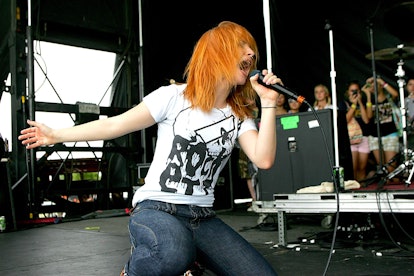
Last year, Warped Tour’s founder, Kevin Lyman, announced the end of an era: After nearly a quarter of a century, the monumental fest would make its “final, full cross-country run.” The news is now sinking in as a reality as the tour’s final date, August 5th, fast approaches. What’s been known as Vans Warped Tour since 1996 has equally officially been known as a place for aspiring alts trapped in the suburbs to flourish—one that just so happened to make history in the process. Warped Tour was not only a launching pad for Green Day, Katy Perry , Blink-182, and even Eminem; it was also a documentation of the birth of emo as we know it in the aughts, seen through its lineups’ shift from punk acts like Bad Religion, Rancid, the Casualties, NOFX, and Anti-Flag to bands like All Time Low, Simple Plan, Sum 41, Taking Back Sunday, the Used, and From First to Last—the latter of which featured one long-haired, screaming emo heartthrob Sonny Moore, now better known as Skrillex . In case you hadn’t noticed, pretty much all of the above feature almost exclusively white men—a lack of diversity that’s unfortunately continued into the 50-plus bands chosen to make up Warped Tour’s last hurrah. (Joan Jett is putting in her usual appearance, but Paramore’s flamed-hair Hayley Williams, essentially the only woman who managed to become a face of Warped Tour throughout its history, is noticeably missing from this year’s lineup.) Take a look back at that history, flaws and all, with the best photos of its glory days, including flashbacks to Perry’s guitar, Oli Sykes’s neck tats, Benji Madden’s snake bites, Jared Leto’s lipstick, Pete Wentz’s popped collar, Demi Lovato ‘s sweeping side bangs, and Jeffree Star’s infamous hot-pink mop, here.
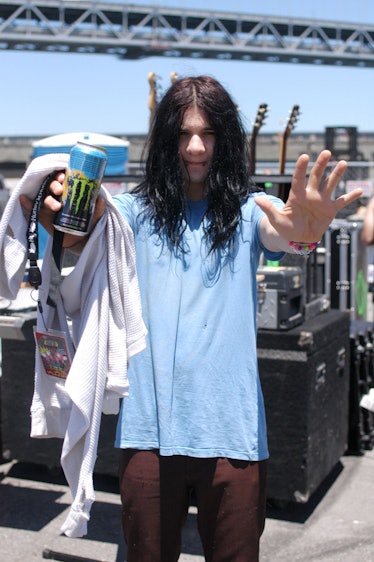
Skrillex, when he was Sonny Moore of From First to Last, at the 2006 Vans Warped tour in San Francisco.

A pre-pop-fame Katy Perry performing at the 2008 Warped Tour in Carson, California.
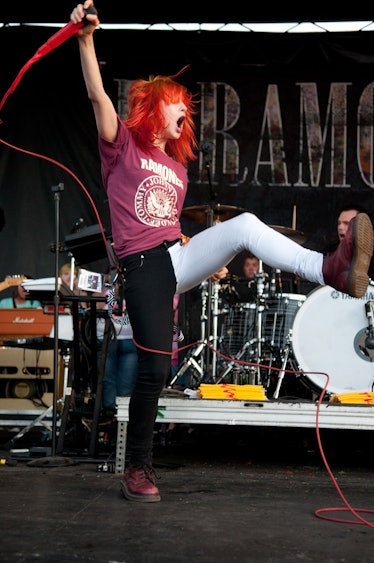
Hayley Williams of Paramore, with her signature neon hair, performing at the 2011 Vans Warped Tour in Milwaukee, Wisconsin.
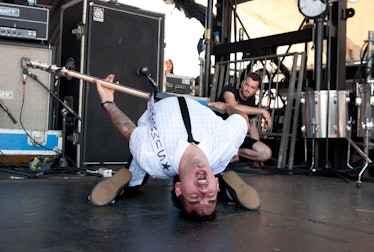
Chris Barker of Anti-Flag performing at the 2010 Vans Warped Tour in Wheatland, California.
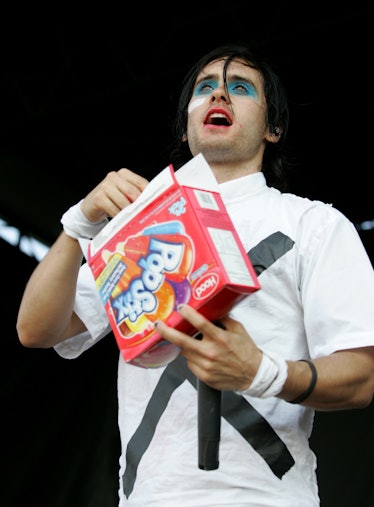
Jared Leto of 30 Seconds to Mars performing at the 2006 Vans Warped Tour in Fitchburg, Massachusetts.
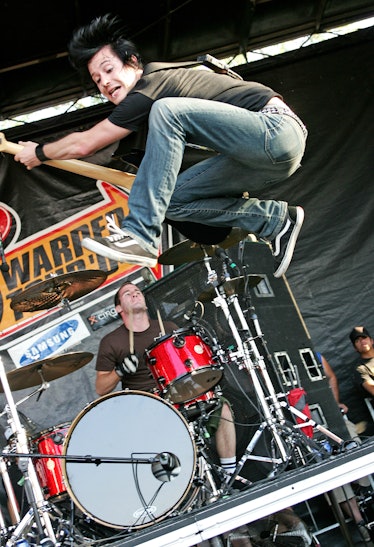
Simple Plan performing at the 2004 Vans Warped Tour in Bonner Springs, Kansas.
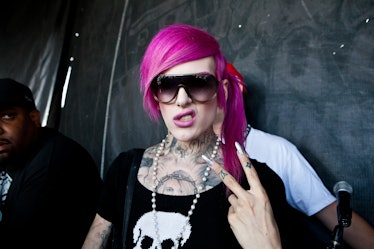
Before his makeup line became an empire, Jeffree Star, seen her at the 2011 Vans Warped Tour in Carson, California, was a Warped Tour regular.
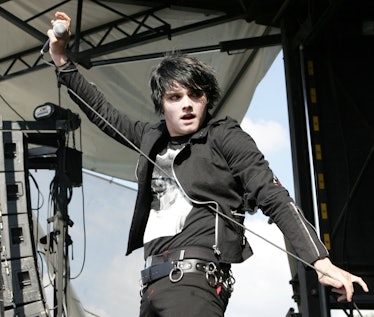
Gerard Way of My Chemical Romance performing at the 2005 Vans Warped Tour in Columbus, Ohio.
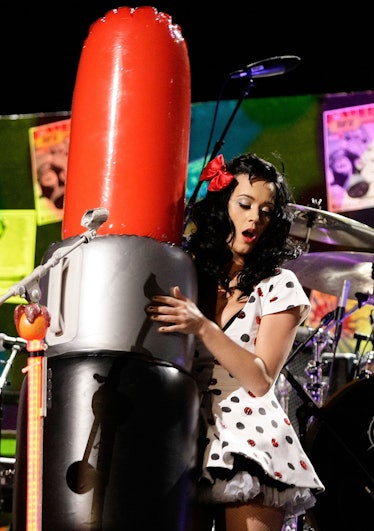
Katy Perry performing at the 2009 15th Anniversary Vans Warped Tour in Los Angeles, California.
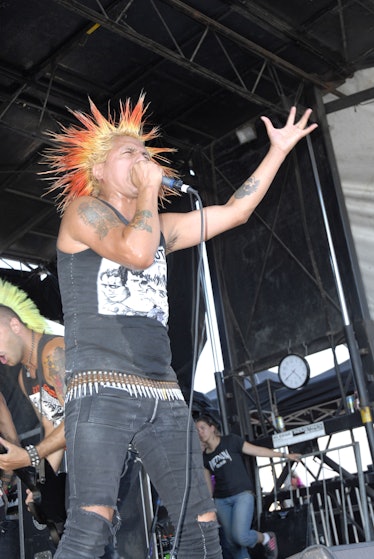
The Casualties performing at the 2006 Vans Warped Tour in Uniondale, New York.
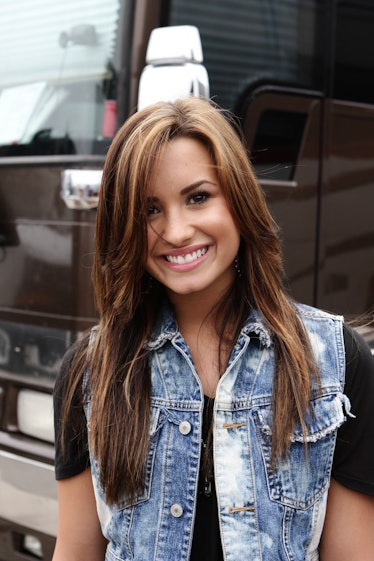
Demi Lovato posing backstage at the 2010 Vans Warped Tour in Ventura, California.
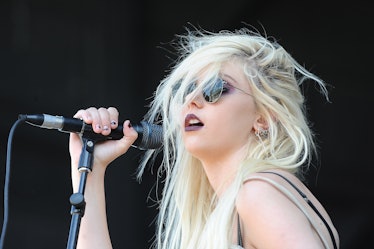
Taylor Momsen of the Pretty Reckless (and more famously of Gossip Girl ) performing at the 2010 Vans Warped Tour in Marysville, California.
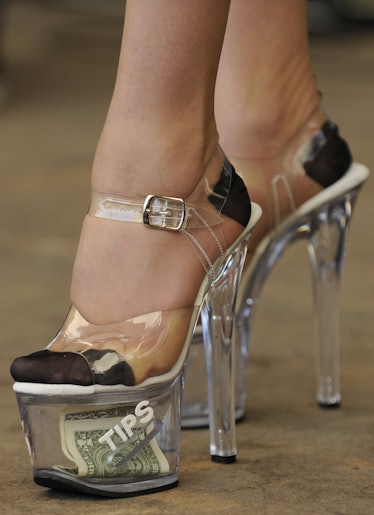
Taylor Momsen’s shoes during her performance at the 2010 Vans Warped Tour in Mountain View, California.
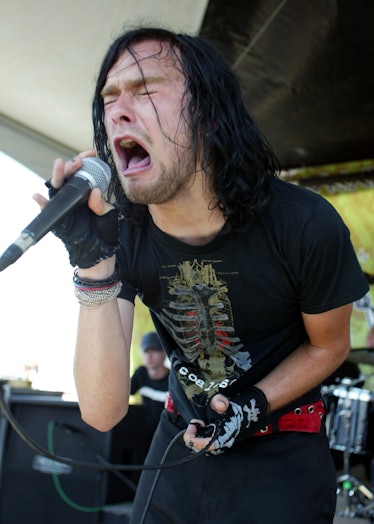
Bert McCracken of The Used performing at the 2002 Vans Warped Tour in San Francisco, California

Benji Madden of Good Charlotte performing at the 2004 10th Anniversary Vans Warped Tour in Boston, Massachusetts.
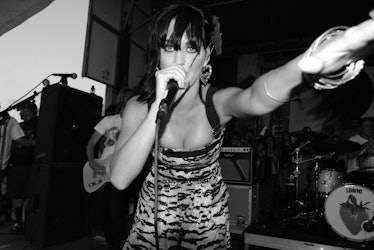
Katy Perry performing at the 2008 Vans Warped Tour in Carson, California.
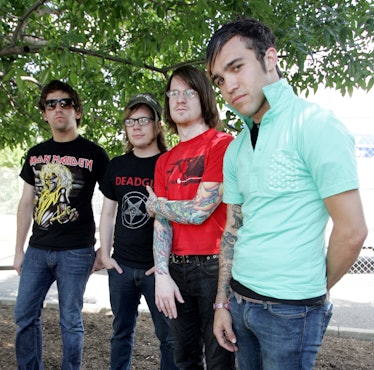
Joe Trohman, Patrick Stump, Andy Hurley, and Pete Wentz of Fall Out Boy at the 2005 Vans Warped Tour in Columbus, Ohio.

Billy Idol performing at the 2005 Vans Warped Tour in Pomona, California.

Lars Frederiksen and Tim Armstrong of Rancid performing at the 2003 Vans Warped Tour in San Francisco, California.

Joan Jett performing at the 2006 Vans Warped Tour in Detroit, Michigan.
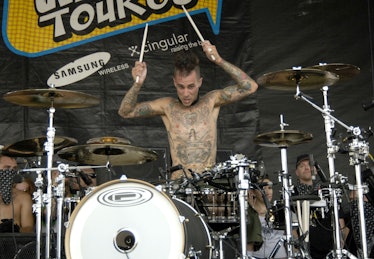
Travis Barker of The Transplants performing at the 2005 Vans Warped Tour in Randall’s Island, New York.
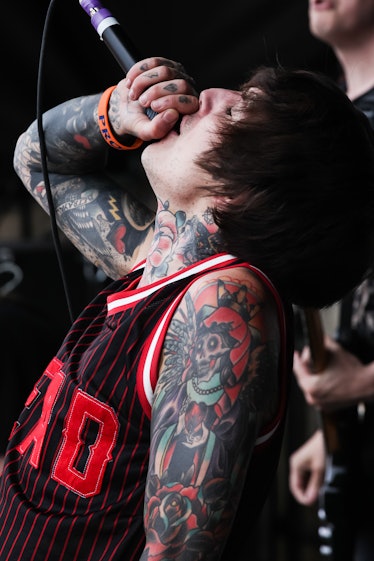
Oli Sykes of Bring Me the Horizon performing at the 2013 Vans Warped Tour in Ventura, California.

Jeffree Star at the 2013 Vans Warped Tour press conference and kick-off party in Los Angeles, California.
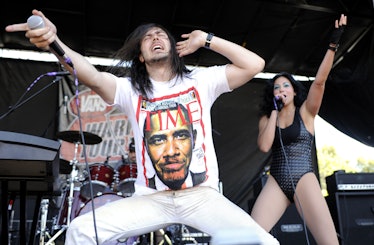
Andrew W.K. performing at the 2010 Vans Warped Tour in Mountain View, California.

William Beckett of The Academy Is… performing at the 2008 Vans Warped Tour in Englishtown, New Jersey.
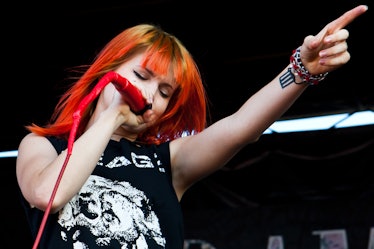
Hayley Williams of Paramore performing at the 2011 Vans Warped Tour in San Diego, California.
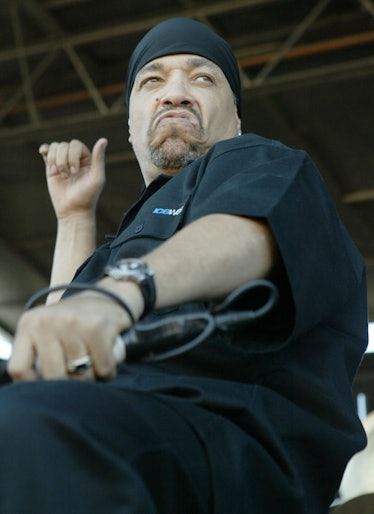
Ice-T performing in a surprise appearance at the 2003 Vans Warped Tour in San Francisco, California.
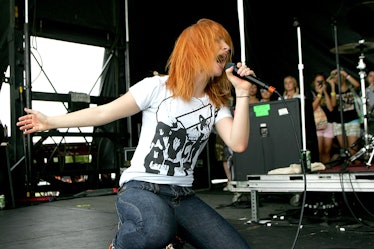
Hayley Williams of Paramore performing at the 2008 Vans Warped Tour in San Antonio, Texas.
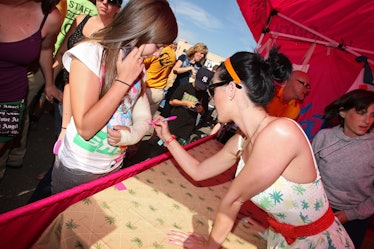
Katy Perry signing a fan’s cast at the 2008 Warped Tour in Ventura, California.
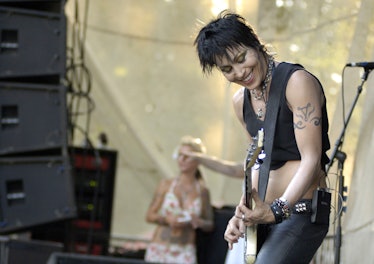
Joan Jett performing at the 2006 Vans Warped Tour in Atlanta, Georgia.
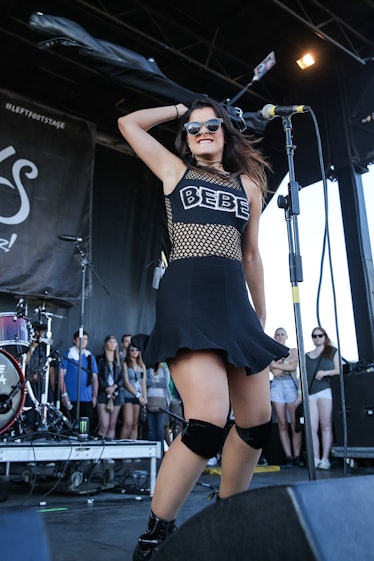
Bebe Rexha performing at the 2015 Vans Warped Tour in Ventura, California.
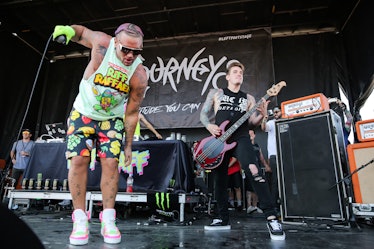
Riff Raff and bassist Andy Glass of We Came as Romans performing during the 2015 Vans Warped Tour in Ventura, California.
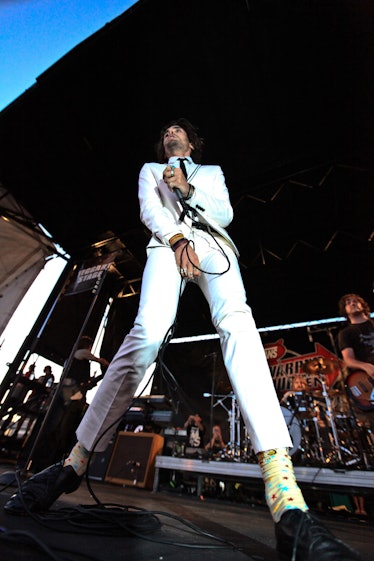
Tyson Ritter of the All-American Rejects performing at the 2010 Vans Warped Tour in Carson, California.

Katy Perry performing at the 2008 Vans Warped Tour in Ventura, Caliornia.
The Enlightened Mindset
Exploring the World of Knowledge and Understanding
Welcome to the world's first fully AI generated website!
The Start of Warped Tour: Exploring the History and Impact of the Music Festival
By Happy Sharer
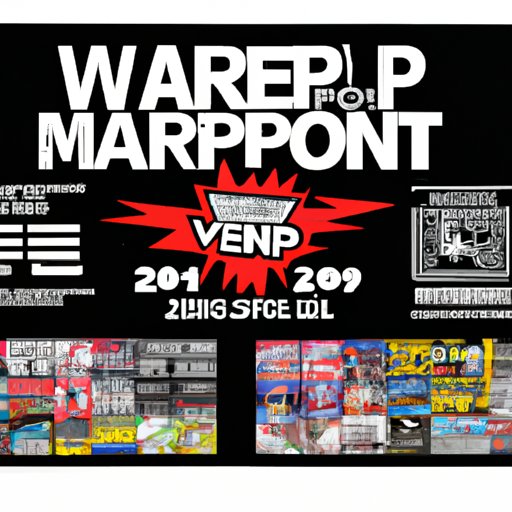
Introduction
Warped Tour is an iconic music festival that has been around since 1995. The festival is known for its punk rock roots, but it has evolved over the years to include bands of various genres. In this article, we will explore the start of Warped Tour, its founders’ vision, and its lasting impact on the music scene. We will also look at how Warped Tour has changed through the years and how it continues to shape the music industry today.
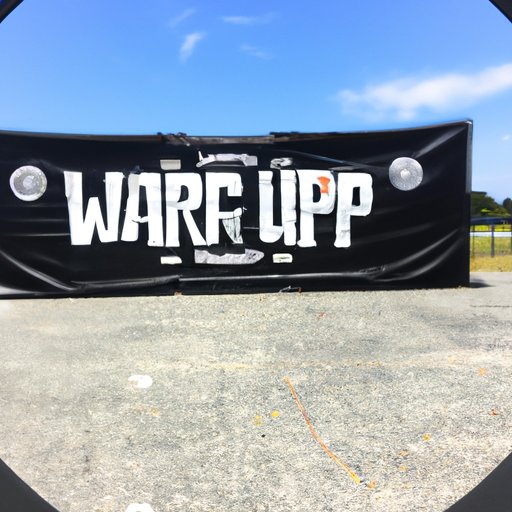
A Historical Look at the Start of Warped Tour
The origins of Warped Tour can be traced back to 1995 when Kevin Lyman, a former concert promoter, was looking for a way to bring punk rock music to a wider audience. He wanted to create an event that would feature bands from all over the world while providing an affordable ticket price. His goal was to create a festival that would give people an opportunity to experience punk rock in an intimate setting.
Lyman’s initial goals for Warped Tour were to bring together bands from different genres and to provide an affordable ticket price. He also wanted to create a festival that could tour around the United States and Canada, giving people from all corners of the country a chance to experience the music. To make this dream a reality, Lyman partnered with several major record labels to secure the bands for the tour.
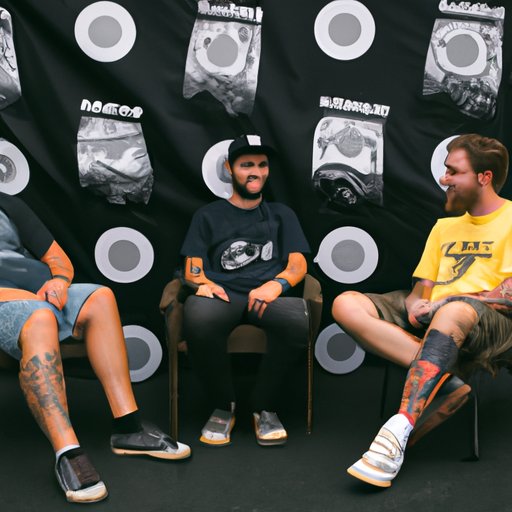
An Interview with the Founders of Warped Tour
We spoke with Kevin Lyman and Jonny Gross, two of the founders of Warped Tour, about their vision for the festival.
Q: Who founded Warped Tour?
Kevin Lyman: I started Warped Tour in 1995. I had been working as a concert promoter for many years prior to that and saw an opportunity to create a festival that could tour around the United States and Canada. I wanted to bring people together through music and create an affordable ticket price so more people could experience the music.
Q: What was your vision for Warped Tour?
Jonny Gross: We wanted to create a festival that would bring together bands from different genres and provide an affordable ticket price. We also wanted to create a sense of community among the fans by having them interact with the bands and other fans. We wanted to create an atmosphere where everyone felt welcome and accepted.
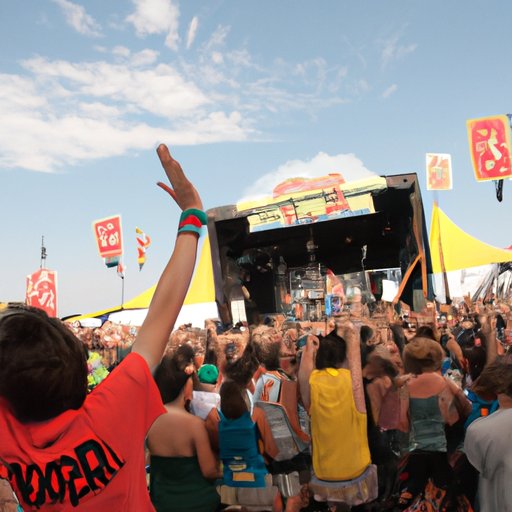
Warped Tour Through the Years: The Evolution of a Music Festival
Since its inception in 1995, Warped Tour has undergone several changes. During its early years, the lineup consisted mainly of punk rock bands. Over time, however, the lineup began to evolve to include bands from various genres such as metal, hip-hop, indie rock, and more. Additionally, the venues changed from amphitheaters to arenas and other larger venues as the festival grew in popularity.
Another major change was the expansion of Warped Tour to other countries. Originally, the festival only toured the United States and Canada, but in recent years, it has expanded to include tours in Europe, Australia, and South America.
A Timeline of Warped Tour’s Beginnings
1995-2000: Warped Tour was founded in 1995 by Kevin Lyman and Jonny Gross. The first year of the tour featured only punk rock bands, including Bad Religion, NOFX, and Pennywise. The tour continued to grow in popularity over the next five years, with the lineup expanding to include bands from other genres such as metal, ska, and hip-hop.
2001-2009: During this period, Warped Tour continued to expand, with the tour now traveling to other countries such as Japan, Australia, and the United Kingdom. The lineup also began to include more mainstream acts such as Fall Out Boy, Panic! At the Disco, and My Chemical Romance.
2010-Present: Warped Tour continued to grow in popularity during this period, with the tour now including even more mainstream acts such as Paramore, Twenty One Pilots, and All Time Low. Additionally, the tour has expanded to include festivals in Europe, South America, and Asia.
How Warped Tour Changed the Music Scene Forever
Since its inception in 1995, Warped Tour has had a major impact on the music scene. By showcasing bands from various genres, Warped Tour helped to introduce people to new styles of music and open their minds to different sounds.
Additionally, Warped Tour influenced the creation of other music festivals. As a result of Warped Tour’s success, many other festivals have adopted a similar format, featuring a variety of bands from different genres. This has allowed fans to experience more music and exposed them to new styles they may not have otherwise heard.
Finally, Warped Tour left a lasting legacy in the music industry. By bringing together bands from different genres, it helped to create a unified music scene. It also showed the power of music to bring people together and inspire them to create something meaningful.
Warped Tour has come a long way since its beginnings in 1995. From its punk rock roots, the festival has grown to include bands from all genres and to travel to other countries. The founders’ vision for a festival that could bring people together through music has become a reality, and Warped Tour has had a lasting impact on the music scene. Warped Tour continues to influence future festivals and show the power of music to unite people.
(Note: Is this article not meeting your expectations? Do you have knowledge or insights to share? Unlock new opportunities and expand your reach by joining our authors team. Click Registration to join us and share your expertise with our readers.)
Hi, I'm Happy Sharer and I love sharing interesting and useful knowledge with others. I have a passion for learning and enjoy explaining complex concepts in a simple way.

Related Post
Exploring japan: a comprehensive guide for your memorable journey, your ultimate guide to packing for a perfect trip to hawaii, the ultimate packing checklist: essentials for a week-long work trip, leave a reply cancel reply.
Your email address will not be published. Required fields are marked *
Expert Guide: Removing Gel Nail Polish at Home Safely
Trading crypto in bull and bear markets: a comprehensive examination of the differences, making croatia travel arrangements, make their day extra special: celebrate with a customized cake.
The Untold Truth Of Vans Warped Tour
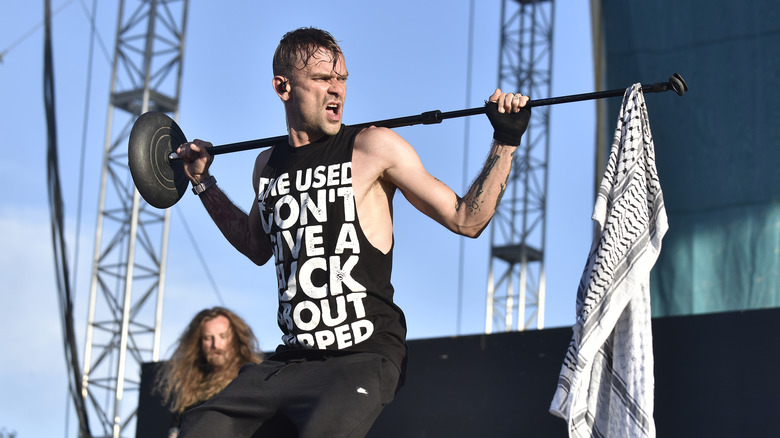
From 1995 to 2019, Vans Warped Tour became the mecca of alternative music. Fans would flock to the traveling festival to see their favorite artists and to discover the next big thing, while musicians would know a spot on this coveted tour could elevate their career. After all, there's no disputing the impact it had in the ascension of the careers of groundbreaking acts like Paramore, My Chemical Romance , and Fall Out Boy .
Founded by Kevin Lyman, Vans Warped Tour is widely associated with the punk rock movement and a strong ethos of the do-it-yourself attitude, being seen as the everyday person's music event. However, in the later years, controversy engulfed the tour. From scene politics to giving a platform to disgraced musicians, there were accusations that it was no longer the same place it was in the beginning. For some, it simply didn't feel like home anymore. As a result, there were mixed feelings when Lyman announced the tour would officially call it a day after its 25-year celebration.
Regardless of the sentiment toward the Vans Warped Tour, no one can deny the importance it played in the music scene throughout its run. It outlasted many of its peers and inspired others to start their own events, too. With that said, let's take a look back at the untold truth of Vans Warped Tour and if it is due to make a comeback.
The founder cut his teeth on Lollapalooza
Anyone who has worked on the live side of the music industry understands it is a demanding and grueling job. Not only is there the physical aspect of setting up the equipment and ensuring everything is in working order before the doors open, but there is also the marketing element and understanding of how to deal with unexpected issues that may arise on the day. Think of it like organizing a big birthday bash, but times the difficulty level by 100.
Kevin Lyman was no rookie when he decided to start his own tour, since he had already spent time working as a stage manager at another famous music festival. "Before Warped I was on three years of Lollapalooza, so [it's been] 26 straight summers out on the road," he told Billboard .
Having experience, Lyman also understood that he needed significant sponsorship to make this dream tour a reality. As revealed by Vans Vice President Steve Van Doren, Lyman approached the sneaker manufacturer for finance, and Vans saw it as a mutually beneficial opportunity to expand its reach throughout North America.
Vans Warped Tour gave a lot of people second chances
When applying for jobs, background checks have become the norm. However, that hasn't stopped people from being prejudiced against for having a criminal or substance abuse history, as research has shown, per Criminology . There's a stigma that sticks with people long afterward and makes it exponentially more difficult for them to find work and rebuild their lives.
Speaking to Loudwire , Kevin Lyman discussed the importance of affording people second chances, explaining how it is something deeply personal to him and his value system. "The majority of my early Warped Tour crew guys all had to spend a little time in jail for stupid decisions," Lyman said. "A lot of them were selling meth or whatever and did their time, and I gave them their second chance. And that built a loyalty, giving a second chance to people."
It is also one of the main reasons Lyman became involved in other organizations and philanthropy projects, such as MusiCares and FEND, which address addiction. He believes a large portion of society is still reluctant to allow others back into the community after they have shown remorse and tried to make amends, so he wanted to do his part in inspiring change.
If you or anyone you know needs help with addiction issues, help is available. Visit the Substance Abuse and Mental Health Services Administration website or contact SAMHSA's National Helpline at 1-800-662-HELP (4357).
Why the schedule for the Vans Warped Tour changed daily
Vans Warped Tour would take the acts across the country, performing sweaty day-long sets in numerous cities and states. There were even groups of fans who would follow the tour and try to attend as many shows as possible. To keep the shows fresh and unpredictable, the tour's organizer switched up the order of the lineup on a daily basis.
In an interview with Forbes , Kevin Lyman brought up his past as a stage manager for Lollapalooza and how this influenced his decision with Warped Tour's schedule. He explained how he would notice the same acts performed at the same time every day, and the predictability reflected in the audience attendance, as a majority of the people would only show up when it was time for the headliner to go on stage.
"So I said, if I ever get to do this, I'm going to mix it up," Lyman said. "It just spurred in my mind what I thought I'd do. I'll write the schedule each day. It keeps people engaged — you never knew who you were playing before or after, or what time you were playing. It keeps everyone on their toes." The unpredictability encouraged the audience to hang out for the whole day since they never knew who would be playing and when, while it excited the bands too. As Every Time I Die's ex-vocalist Keith Buckley explained, no one knew when they would be hitting the stage, which provided an element of surprise.
How the BBQ Band concept came to be
With all those bands on the road for Vans Warped Tour, there were bound to be a lot of hungry stomachs after a show. However, the tour figured out a way of solving this problem while also giving a group a unique opportunity every year. In return for working the grill after every show, a musical act would be given a spot on the tour's lineup. Hence the birth of what became known as the "BBQ band."
Kevin Lyman revealed to Vice where the initial idea stemmed from. He explained how punk rockers Lagwagon had their own barbeque after a show, but only bands with laminate passes sourced from Lagwagon themselves could get any. Lyman thought that every group deserved access to this and that it shouldn't be limited to the friends of the band, so he came up with a plan where a single act would be responsible for the barbeque at every stop for everyone.
Explaining what the group would get in return, Lyman said, "Yeah, they get a full set, they sell merchandise, they sell albums, and I pay 'em some money on top."
The time when Deftones set a Porta-Potty on fire
If there isn't an element of danger involved, can it really be considered rock 'n' roll? While no one decided to put their head inside a tiger's mouth or challenge a bear to an exploding barbed wire death match, other outlandish shenanigans took place throughout Vans Warped Tour's history.
Alternative Press interviewed numerous people who participated in the tour, and the stories ranged from a golf cart being wrecked to Sublime's trusty dog biting people. However, it was Kevin Lyman who recollected one of the wildest tour tales.
Lyman explained how he intended to take a few days off in 1997 after the birth of his child, but when he stepped off the plane, he was alerted to the chaos taking place in his absence. "It turned into the 'Lord of the Flies' out there," he said. "Deftones got fireworks and set a portable toilet on fire. My production manager's quick decision was to take the Porta-Potty on a forklift and push it into the river. The city's mayor had been running on this 'clean up the river' platform, and that was on the front page of the newspaper the next morning."
The presence of the controversial anti-abortion clinic
The spirit of punk rock is built on progressive values and fighting against oppressive systems. As a result, many non-profit organizations set up tents to promote their causes at Vans Warped Tour throughout its 25-year run; however, there was one that raised more than a few eyebrows. In 2016, the anti-abortion organization known as Rock for Life became a part of the tour, and it drew ire from many attendees and online commentators. The next year, Rock for Life returned to Warped Tour, again reigniting the debate about the presence of a pro-life organization there.
Speaking to Spin , Kevin Lyman explained how Rock for Life's values didn't necessarily align with his pro-choice stance, but that he included various other NPOs on Warped Tour with differing ideologies so that debate and conversation could take place between people.
He said: "I go to the booth, and I see people talk to them. They're really promoting adoption, and other things besides abortion. I'm adopted. I'm not supporting them, but they can have the spot. They're not hassling people."
13,000 people signed a petition to stop a musician from playing, but he did
In late 2014, disturbing accusations surfaced regarding Jake McElfresh, aka Front Porch Step. According to the allegations, McElfresh had sent inappropriate messages and images to minors. Considering Front Porch Step had performed at the 2014 Vans Warped Tour and was relatively well known within the music scene, the news spread fast and wide among the community.
Over 13,000 individuals signed a change.org petition to not allow Front Porch Step to play at Vans Warped Tour again. However, in 2015, McElfresh was confirmed to appear on the tour. This resulted in backlash from fans and other musicians, who couldn't believe Front Porch Step had been allowed this platform — especially considering how many young fans attended Warped Tour and the harrowing nature of the allegations.
Speaking to Alternative Press , Kevin Lyman stated that McElfresh had not been formally charged with any crime and his appearance was part of a rehabilitation program, based upon discussions with his counselor. In a later 2018 interview , Lyman expressed regret at allowing Front Porch Step to have performed at the 2015 Vans Warped Tour.
If you or anyone you know has been a victim of sexual assault, help is available. Visit the Rape, Abuse & Incest National Network website or contact RAINN's National Helpline at 1-800-656-HOPE (4673).
The accusation of being a boys' club for the most part
The Vans Warped Tour faced accusations of being a boys' club from certain sections, with The New York Times citing how only seven percent of the bands listed for the 2018 edition featured female members. Although the tour had shown improvement in its numbers and given more opportunity to women over the years, especially as headliners, there was no disputing that the acts on display were predominantly male throughout the years. Coupled with this was the prevalence of a bro culture that boasted bad behavior.
The publication spoke to several women and nonbinary artists to get their perspectives of the tour. Each person had their own unique experience, with some stating they hadn't seen misogynistic behavior, while others expressed opposite views.
Five Iron Frenzy's Leanor Ortega Till, for example, explained how there was a need to be cautious with tour buses as an example. "One of the bands we went out with had a little inflatable pool," Till said. "They'd get in their underwear and go out there and hang out. And I knew what they were up to, which was get girls into their underwear to hang out, too."
Kevin Lyman said 2017's Vans Warped Tour was a bad one financially
When Kevin Lyman announced the end of Vans Warped Tour, there was a lot of debate about the real reasons for doing so among fans. One of them was that the tour had stopped making money. However, Lyman dispelled this notion in an interview with "All Punked Up" podcast, revealing that Warped Tour made money — except for one year.
"I had one bad year: 2017," Lyman said. "It was one of those years where everything goes wrong that could possibly go wrong, went wrong in 2017."
While Lyman didn't delve into exactly what his challenges were, the initial announcement of the lineup for the Vans Warped Tour 2017 wasn't warmly received by the fans. There were notable acts such as Anti-Flag, Andy Black, Gwar, and Hawthorne Heights on the bill, but the audience felt it didn't have the star power of the previous year's edition, which had featured the likes of Good Charlotte and New Found Glory. Undoubtedly, the lack of excitement for the artists might have factored into the decision for many fans to give it a skip that year.
The one thing that the Warped Tour never managed to do
From Katy Perry to My Chemical Romance and Blink-182, there was no shortage of world-renowned musicians who performed at Vans Warped Tour. Considering the traveling festival ran for a quarter of a century, there can't be much that it failed to achieve in this time. However, for Kevin Lyman, there is something he wanted to do that he never managed to. When asked by Outburn what that is, he replied: "Have a Ramones reunion."
The seminal New York punk band called it a day in 1996 — a year after the formation of Vans Warped Tour. At that early stage, it might have been difficult for Lyman to attract a band of that caliber to the tour — plus, it would have been mighty costly, since the Ramones were bona fide legends and wouldn't come at a discount price.
Unfortunately, by the time Warped Tour had become a force to be reckoned with in the early 2000s and could probably afford the Blitzkrieg Boppers, most of the members of the Ramones had already died .
Scene politics contributed to its demise
Music brings people together, but the community also has the potential to divide like no other. Much like with any other fandom on Planet Earth — just ask "Star Wars" fans — there is a lot of politics, elitism, and people disliking each other for random reasons. Heck, even the bands themselves partake in this peculiar behavior, with social media feuds becoming equally the most hilarious and sad things to witness online.
Appearing on Kerrang's "Inside Track" podcast, Kevin Lyman opened up about how scene politics contributed to the demise of Vans Warped Tour. The promoter explained how he would reach out to various groups that he found talented and would offer them a slot on the tour; however, they would spurn his advances, citing how they didn't want to perform alongside X band or be seen as a "Warped-esque" band. They either had preconceived negative notions about other acts on the tour or didn't want to be bracketed with the type of genre artists the tour attracted.
Lyman didn't understand the logic, as most bands wouldn't even know the others and acted based on impressions rather than facts. Plus, he considered this a self-limiting behavior that impacted a band's ability to grow their fanbase and reach different audiences. Consequently, Lyman started to feel a disconnect from the community and the very reason he started the tour in the first place.
Fronzilla wants to bring back the tour
Since Vans Warped Tour hit the stop button in 2019, a massive gap has been left open in the music festival scene. Of course, the COVID-19 pandemic did no favors to live music, and many have pondered if the return of Warped Tour could help bring back the crowds in droves. Appearing on "No Jumper" in 2020, Attila frontman Chris Fronzak explained what Warped Tour meant to bands. "It's not glamorous, but it's an opportunity for bands to play in front of a huge audience that they wouldn't normally have," he said.
Fronzak added that Kevin Lyman offered to sell him Warped Tour in the past, but Fronzak didn't have the funds at the time to strike a deal. When that changed, the musician reached out to Lyman again in 2020.
"He explained to me that for legal reasons, which I can't go into depth, Warped Tour can't come back for at least another three years or so," Fronzak said, "but after that I'm happy to re-open conversation, and hopefully I'm the one that brings it back because I have a really good plan for how to make it sustainable and make Warped Tour even bigger than it's ever been."
- Cover Story
Here's What Really Caused The Downfall of Warped Tour
Founder Kevin Lyman explains how the scene that built Warped Tour ripped the festival apart from within.
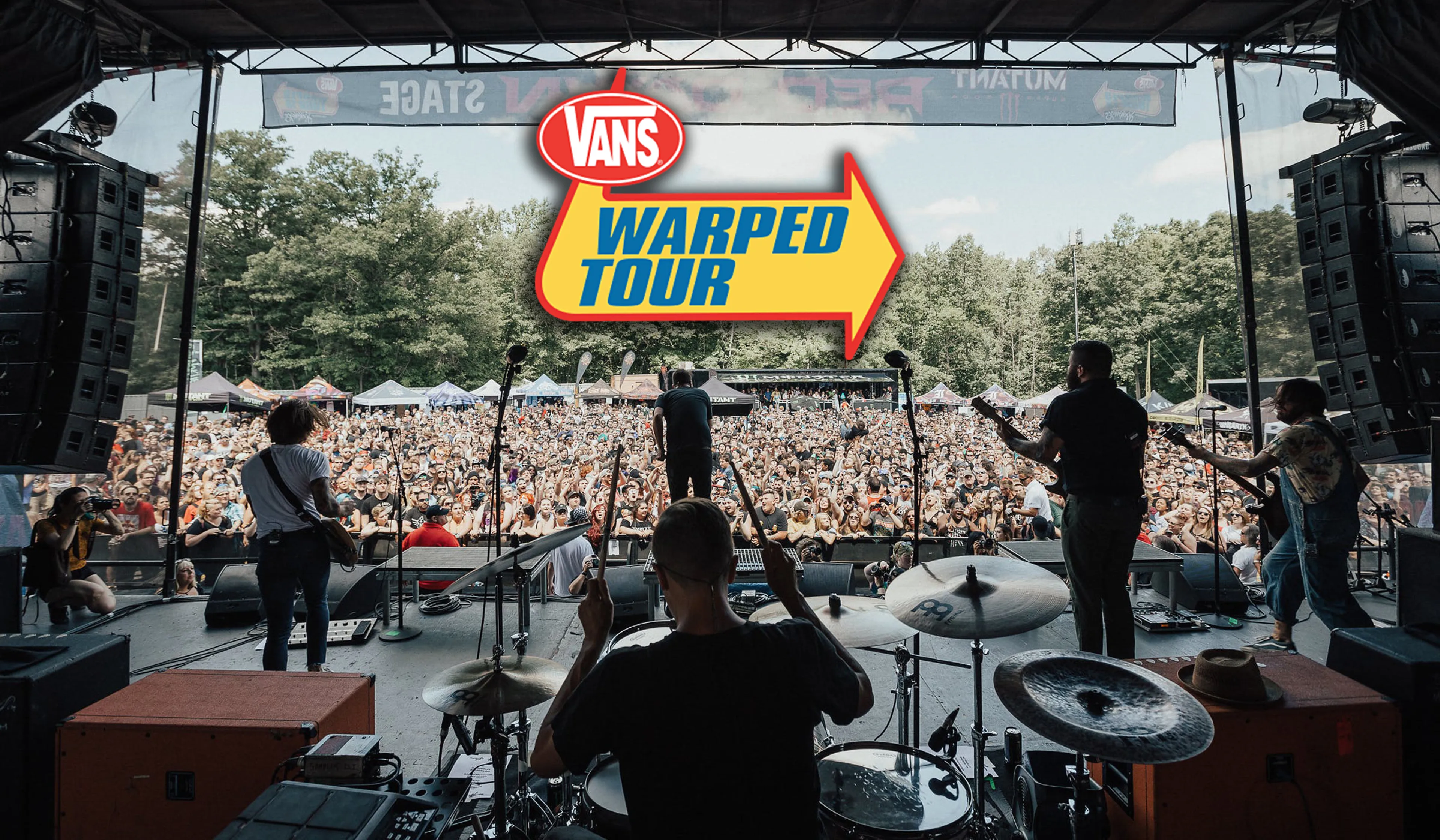
It's always sad when a big yearly festival or event comes to an end, and such was certainly the case with Vans Warped Tour , the massive traveling punk rock event that took the world by storm for 25 years. Sadly, 2018 was the year's last as a touring festival, with this year's three fests across the country acting as its memorial. When the fest ended, rumors circulated about what ended the festival -- most notably financial losses. But now, the man behind Warped Tour has stated that it was something much more human behind the festival's downfall -- the loss of punk rock community.
In the latest episode of Inside Track -- our podcast in which the true stories behind rock's most important moments are told by the people who lived them -- Warped Tour founder Kevin Lyman explains what led to him winding down the traveling festival after 25 years.
"Ultimately, when I started to think about winding this down after 25 years, it was, ‘I think we’ve lost the sense of community,'" says Kevin. "It took a community to make Warped Tour go. Some of that was self-inflicted… I thought you addressed the fans that complain on Twitter! I was addressing everyone and tried to keep that conversation going, but you realize that you can’t really negotiate, debate, or educate on social media!"
Not only did Kevin find that the unity that built Warped Tour was no longer present, but preconceived notions about bands resulted in great musicians turning down the gig, lest they come off as a "Warped" act.
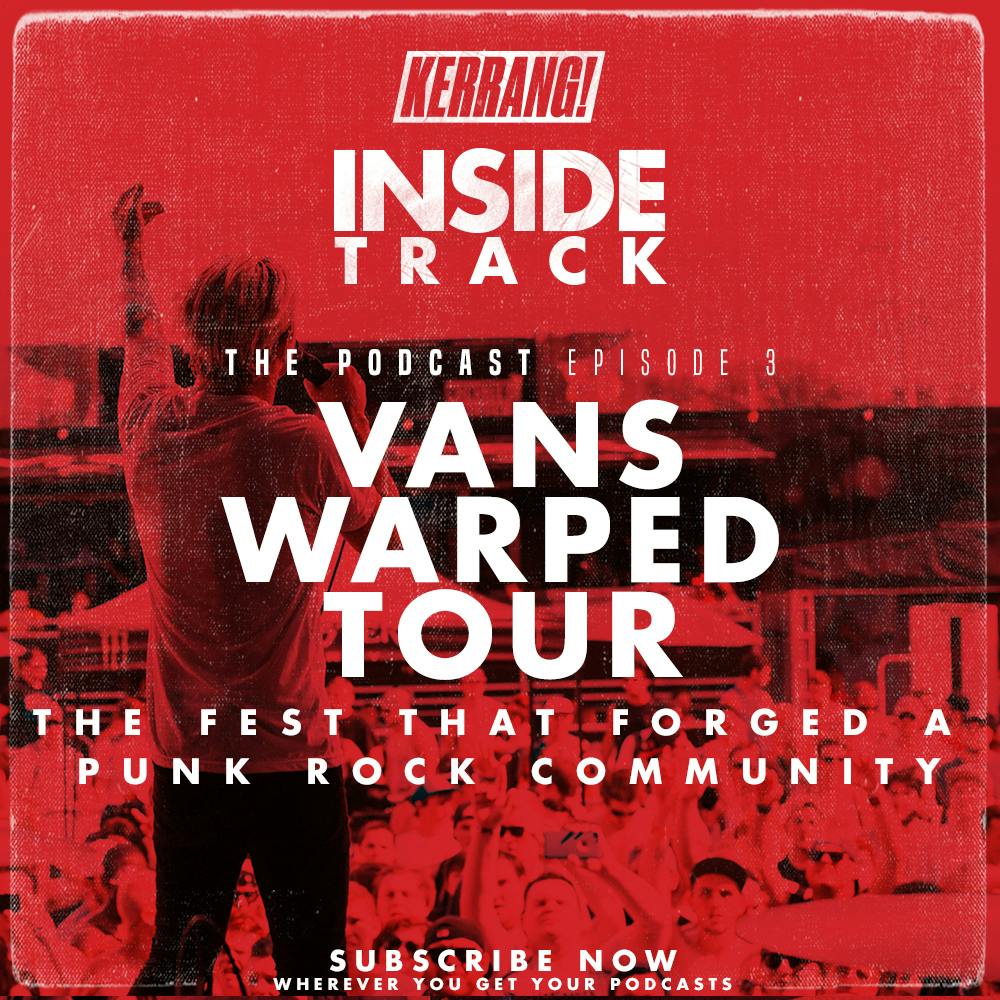
"This is what kind of pissed me off," says Kevin. "Because in 1997, ‘98, Pennywise couldn’t judge a band until you met ‘em in the parking lot. You’d be in line at catering because of this community setting with no dressing rooms. You’d meet these people, and they were musicians too. Then I started watching this community tear itself apart from within, with this band — not even meeting these people, just disagreeing with them or with how they look — bashing that band online.
"People would come up to me on Warped Tour, and say, ‘Well, I don’t want to be on Warped Tour because Attila are on Warped Tour,’" he continues. "Have you met the guys in Attila? We’re not here to judge each other’s music. The fans will judge each other’s music.’ Atilla brings people. Do I personally run around screaming ‘Suck my fuck?’ No. Do you? No. But they’re good musicians and they’re not bad people. I’ve never seen them do a bad thing to someone."
"Every year, I’d send offers, and just — ‘We don’t want to tour with those bands. We don’t wanna be a Warped-esque bands,'" sighs Lyman. And it’s like, dude, Warped-esque bands — you mean Bad Religion . A Day To Remember . Paramore … it got very frustrating."
Listen to the full episode below:
And don’t forget to SUBSCRIBE to Inside Track to hear more of the insane, wonderful, highly-unlikely and totally true stories behind some of the greatest moments in rock history:
- Subscribe on iTunes
- Subscribe on Spotify
- Subscribe on Stitcher
- Subscribe on Castbox
- Subscribe on TuneIn
- Subscribe on Acast
READ THIS: How Less Than Jake pranked Warped Tour with a "police escort" of strippers
Check out more:
Now read these.
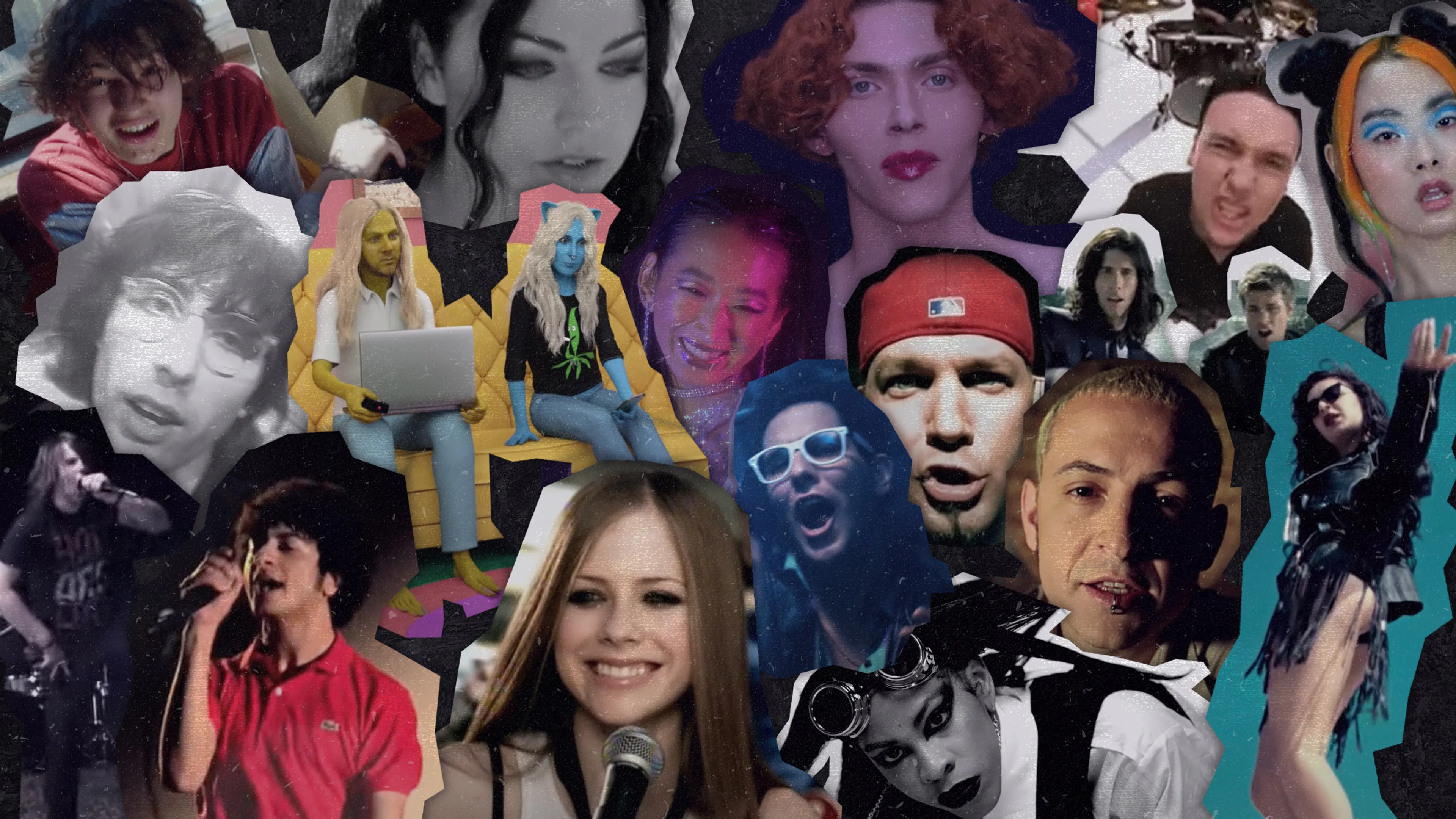
Why hyperpop owes its existence to heavy metal
Hyperpop is on the rise – and it’s thanks, in large part, to metal subgenres like nu-metal, crunkcore and metalcore…
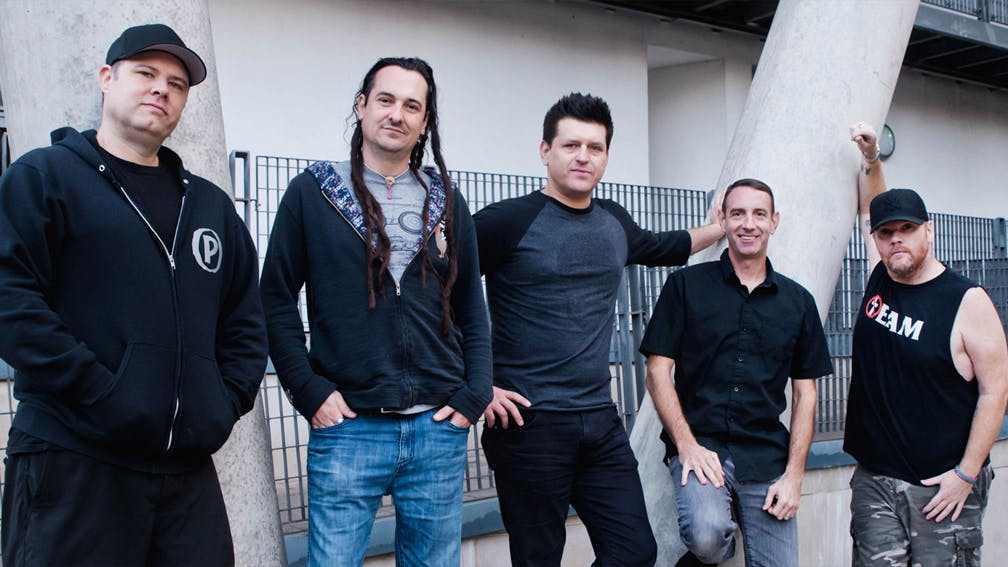
How Less Than Jake Pranked Warped Tour With A "Police Escort" Of Male Strippers
Chris Demakes of ska band Less Than Jake recalls the ultimate punk rock bait-and-switch in the latest episode of our podcast, Inside Track.

Warped Tour: The True Story Revealed In New Episode Of Our Podcast, Inside Track
Warped Tour founder Kevin Lyman and members of Sum 41 and Less Than Jake explain the rise, fall, and legacy of the festival in our new episode of Inside Track.

Tomorrow: The True Story Of Warped Tour's Rise And Fall, Told In Our Podcast
Members of Sum 41 and Less Than Jake -- along with fest founder Kevin Lyman -- reveal the hidden history of Vans Warped Tour in the latest episode of our podcast, Inside Track.
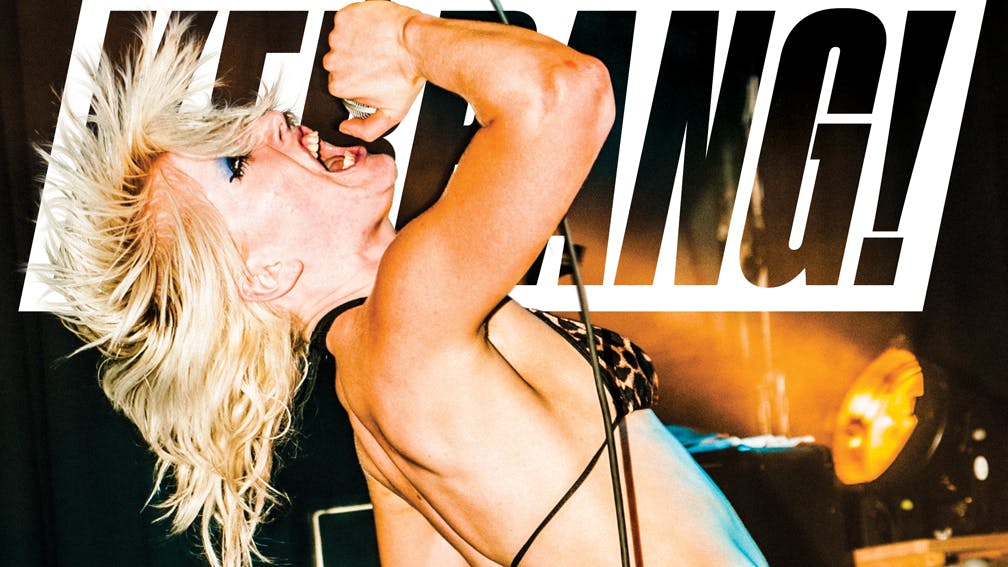
The 21 Hottest Live Bands On Earth
PLUS! Slipknot, Soundgarden, Black Veil Brides, blink-182, Ghost, Green Day, Metallica, Frank Iero and LOADS more!
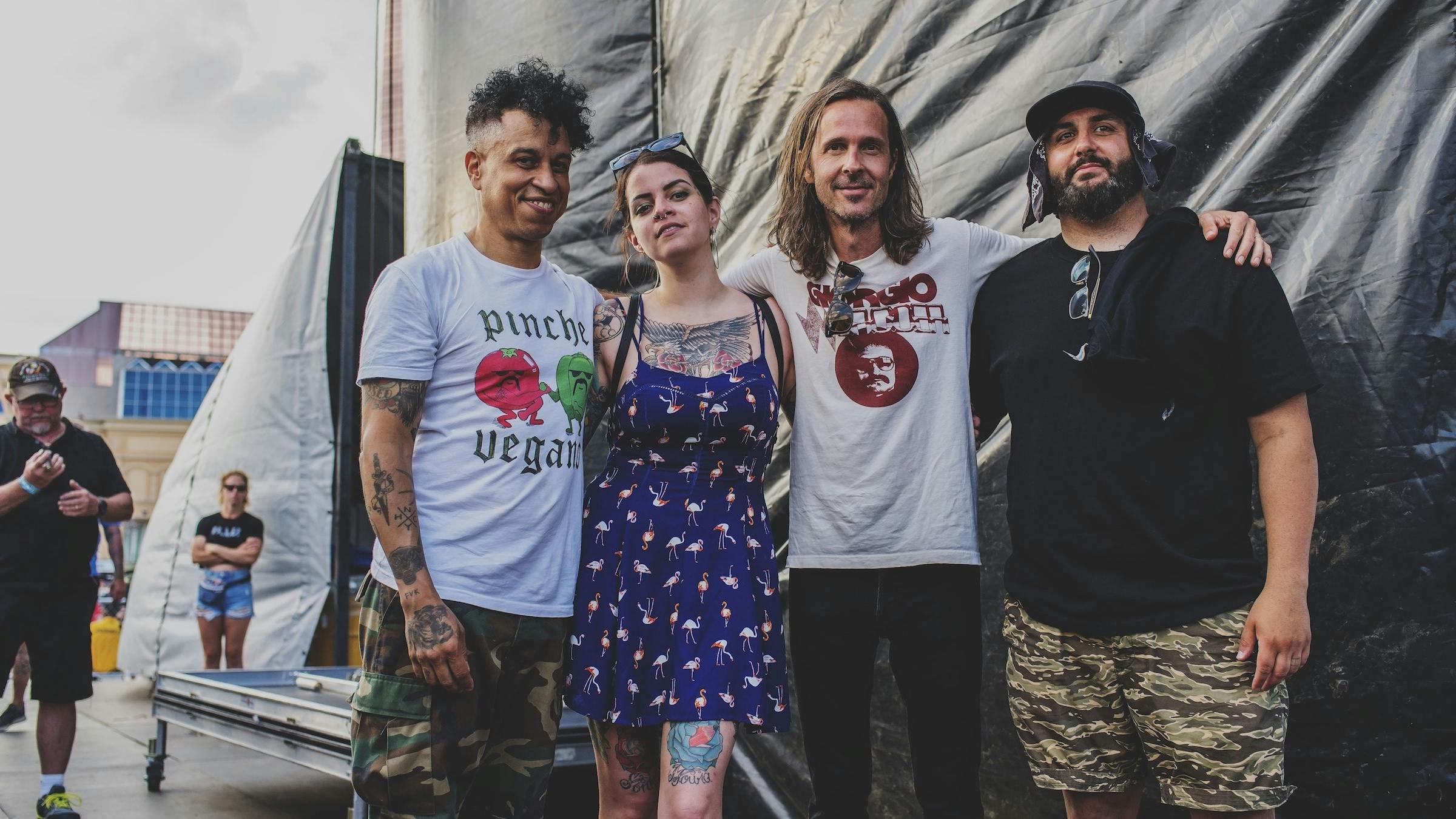
Quicksand's Sergio Vega Goes Behind The Scenes At Warped Tour's 25th Anniversary Festival
Quicksand bassist Sergio Vega gives us a backstage portrait of New Jersey's Warped Tour festival.

More Bands Have Been Announced For This Year's Warped Tour
ONE OK ROCK, The Used, The Story So Far, Yungblud and more have joined Warped Tour's 25th anniversary celebrations.
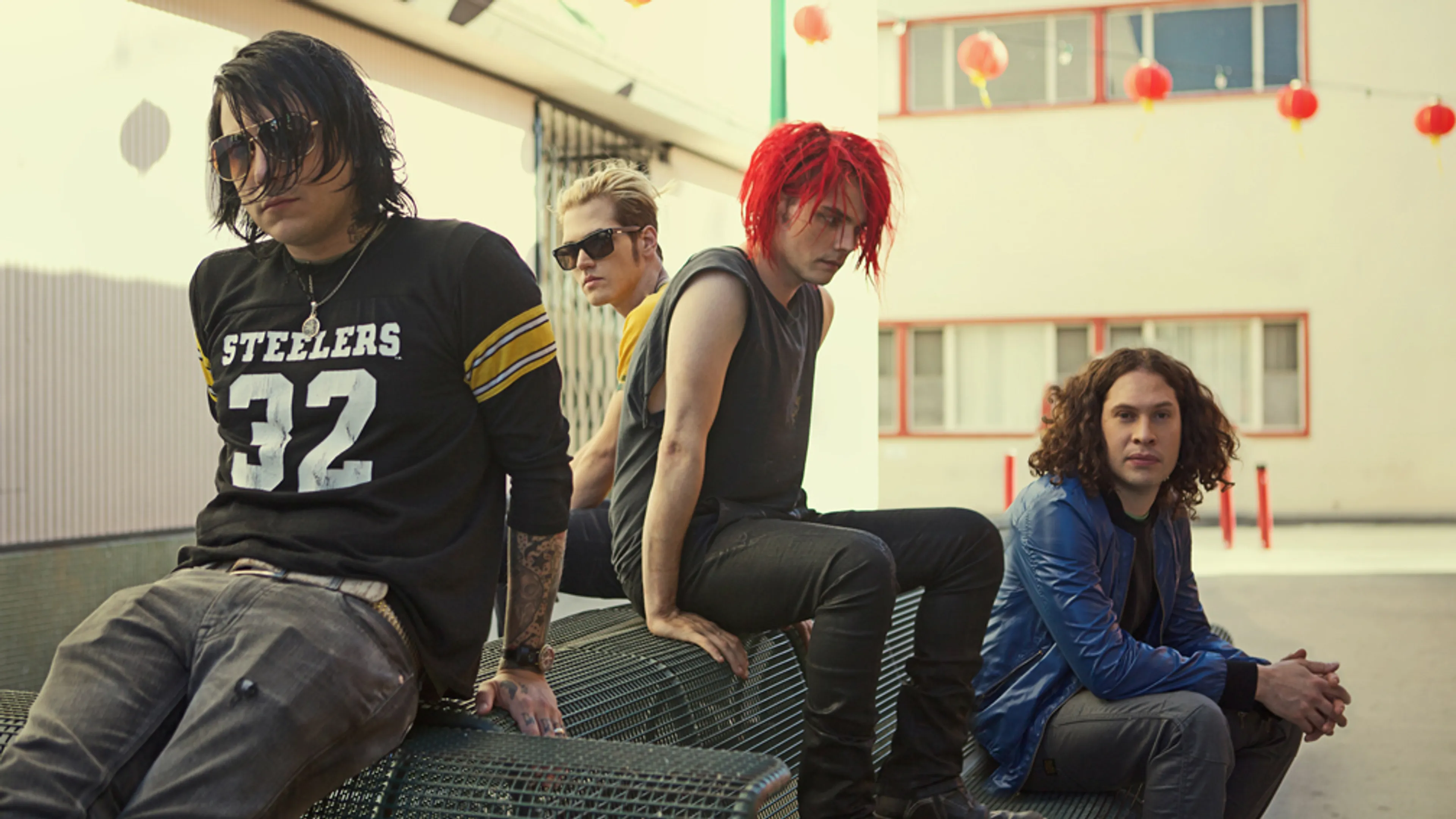
Kevin Lyman Tried To Get My Chemical Romance To Play Warped Tour 2019
The founder of the Vans Warped Tour put in the request for My Chemical Romance…
The best of Kerrang! delivered straight to your inbox three times a week. What are you waiting for?
- Latest News
- Daily Newsletter
- Weekly Newsletter
- Latest Food & Drink
- Restaurant Guide
- Restaurant Reviews
- Food & Drink Newsletter
- Latest Arts & Culture
- 100 Houston Creatives
- Submit an Event
- Movie Times
- HoustonPressArtsGuide.com
- Arts & Culture Newsletter
- Latest Music
- Concert Calendar
- Submit a Music Event
- Music Newsletter
- Things to Do/Tickets
- Best of Houston
- Best of Houston Readers' Choice Winners
- Houston Press Careers
- Local Advertising
- Things To Do Newsletter
- Best Of Newsletter
- Food & Drink
- Arts & Culture
Houston's independent source of local news and culture
- Welcome, Insider
- My Newsletters
Houston's Rememberances of Warped Tours Past
Craig Hlavaty July 2, 2009 2:47PM
"For the first couple of years at the AstroArena they held the entire show indoors, splitting the headlining bands between the arena itself and two side-by-side stages in the AstroHall. This insured that there was no rainout, and also insured that every band sounded like they were playing in an echo chamber. "NOFX played the arena stage at the end of the day, and announced that they were refunding their share of the day's ticket prices since it was supposed to be an outdoor festival and the sound sucked. With the help of the Aquabats, NOFX then threw $5,000 in cash over the entire floor and played their set to a room full of people scrambling like mad to get the money. "NOFX also announced that they'd be celebrating one of their birthdays that night at Emo's, but that they knew it wouldn't matter since nobody at Warped Tour was old enough to get in. "I also remember taking my little brother a few years later to see his first Mighty Mighty Bosstones set (he loved 'em), and during the show someone was fired out of a cannon over the audience. Some dude threw beer or something at [singer] Dicky Barrett, and he jumped offstage and chased the guy all through the entire parking lot. My brother asked if this was typical. I said, 'Kinda, except for the cannon.'"
"I went to the first one and had an awesome time. That whole show was indoors at the AstroArena. Fluf played first and just killed it, and yes, they played 'Peanut Butter.' I remember O telling me how excited he was to finally go to Astroworld. I just didn't have the heart to tell him it was lame. Seaweed was at the top of their game. Bob was still on drums, and they just killed it. Quicksand was awesome as well and Sick of it All was bitchin'. "As for the low points, Sugar Ray and local band the Jinkies (yuck). L7 played but it was the worst L7 show I have ever seen."
"That time when it got rained out a few years ago. I was thankful for that because that morning I had the most intense hangover I've ever had. "The next day's emasculated indoor Warped Tour was a huge clusterfuck with muddy noise throughout and for some reason I wound up sitting through Meg and Dia's set while looking for a friend who, come to find out, had been toking up with the Unseen. I was trying to find where Novista was playing so I could throw shit at them and make fun of their bassist for looking like a douche-version of Jeff Goldblum."
"I saw Social Distortion on the '97 tour in Atlanta. I remember Mike Ness telling some story about hanging out with his friends and running into groups of jocks or some other non-punk stereotype and getting into fights. He ended the story with: 'Sometimes we got our asses kicked . . . but sometimes we beat the FUCK out of 'em!' "Big cheer, song starts. The story was nothing but the punk version of canned stage banter and my brother played me a tape later on where he gave the exact same speech, right down to 'Sometimes we beat the FUCK out of 'em!'"
"Seeing Ice T and Suicidal Tendencies play together and watching Nazi skinheads get kicked out and them driving off in a big pick-up truck. The afterparty was held at the bar next to Lola's, where nobody showed up."
"I was selling merch, and unexpectedly, and to my horror, I split my shorts up the back when I bent down to grab a box of shirts. I will be forever in debt to the Surfrider Foundation, which was in the booth next to me. They gave me a sarong to tie around my waist. I still have it today."
"So I was waiting in the ticket line with my friend who will remain nameless. We were attempting to get the backstage passes that New Found Glory had left for us. (This was like ten years ago, and yes I'm a little embarrassed.) "When we reached the front of the line, we were told that NFG had canceled that date along with several others due to the singer's illness, therefore there were no backstage passes to acquire. We decided to regroup and figure out what to do. Ultimately we resigned to purchasing tickets. "While in our second wait in line my friend started to feel a little queasy. We had gotten seriously ham-boned the night before. So there we were waiting behind ten or so people in the scorching heat and my friend starts vomiting on the pavement, splatters and all. The people in line and within sight of this display were totally disgusted, some beyond words. "Then I heard somebody say, 'Sick, that dude just puked up a cigarette butt!' Sure enough, there was a bile logged butt that hadn't been on the ground prior to the incident. Gnarly, to say the least. At any rate, we braved the heat and tried to enjoy ourselves. It fucking sucked for the most part." "The highlight of the day was hanging out with Saves The Day in their tour van drinking warm beers and smoking joint after joint of really poor-quality weed. At one point we were talking about how stupid MxPx is, and they walked right by us."
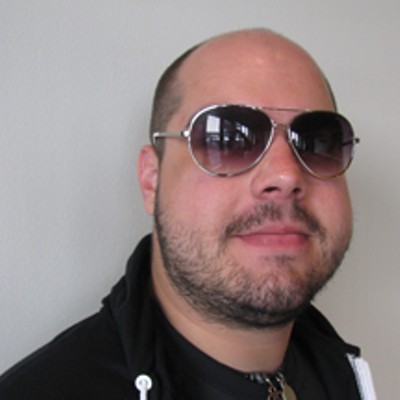
Trending Music
- Maynard James Keenan's SESSANTA is a Different Kind of Birthday Party
- Top 10 Butt-Rock Bands of All Time
- Houston Concert Watch 4/10: Rickie Lee Jones, Dave Mason and More

Latest Stories
Last Night: The Black Crowes at the 713 Music Hall
By Bob Ruggiero
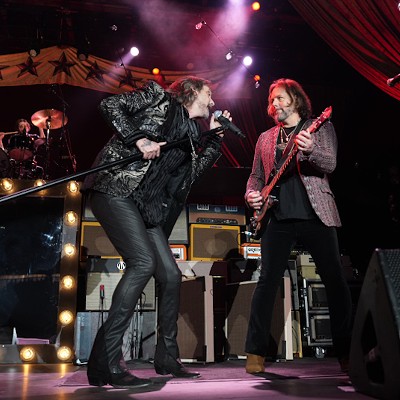
Blue Öyster Cult Resurrect Tapes of the Past To Tell Ghost Stories
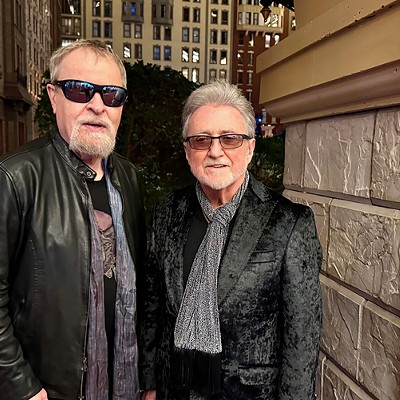
Eric Johnson's Tone-A-Rama Tour Comes to Houston
By Tom Richards
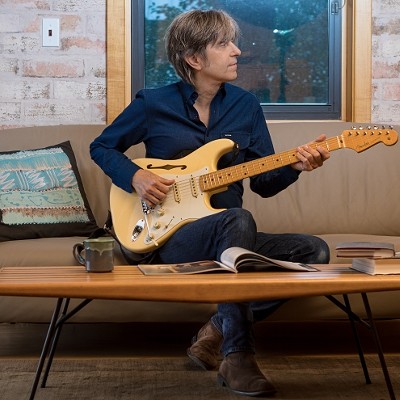
- Promotions Newsletter
- Terms of Use
- Privacy Policy
- Back to Top
- California Privacy Policy
- California Collection Notice
- Do Not Sell My Info
- Close Menu Search
- Front Page Stories
- Arts & Entertainment
- Open Campus
- Student Life

Boise Highlights
- March 15 Request your Senior Commemorative Ad here to be included in the special graduation issue of the Boise Highlights
The Warped History Behind Warped Tour

The VANS Warped Tour logo. The logo changed annually in style and design, displaying the year number and any specific honorary title, like 2007’s ‘Lucky 13th’ anniversary. (Wikipedia)
Andie Nickels , Reporter January 20, 2023
Warped Tour was the highlight of the summer for kids who liked music. It was an iconic rock festival that annually toured across America, stopping in both major cities and smaller towns alike. For many years, Warped Tour used to stop in Idaho, something that I believe to be one of the few good things that ever happened here. Unfortunately, Warped Tour founders Kevin Lyman and Ray Woodbury announced that 2018 would be the last year for Warped, with a 25 year tribute show in 2019 that consisted of only three shows. Starting in 1995, Warped Tour kicked off its first official show at the Idaho Center here in Boise, Idaho. Following its major success, it became officially sponsored and named after the popular shoe brand VANS.
If it was so good though, then why did it end? Well, like many other music festivals, Warped Tour eventually got out of hand. Similar to Warped, perhaps a sign of its impending doom, would be Woodstock ‘99. After the success of Woodstock ‘94, music proprietors hosted Woodstock ‘99, a well-known disaster of a festival that resulted in concertgoers setting fire to two stages and an audio tower, the deaths of three audience members, around 1,200 injured fans, approximately $22,000 being stolen from vandalized ATMs, and countless acts of sexual violence. I find Woodstock ‘99 to be one of the worst, most horrifying festival disasters ever.
Much like Woodstock ‘99, Warped Tour, originally a festival to celebrate the love of music and a place for fans to make new friends, inevitably became corrupt. As Warped Tour continued, the age of the fans decreased, with attendees being younger and younger and musicians becoming creepier. Kevin Lyman, the creator and owner of Warped Tour, began allowing parents of young fans to accompany them during the show free of charge, although he otherwise didn’t do much to halt or stop acts of sexual violence on his tour. Lyman discussed sexual harassment in an interview, apathetically invalidating victims and giving accused musicians far too many second chances.
“Well, that sexual harassment didn’t happen on Warped Tour…” Lyman explained in the interview. “But if you really go through all that stuff, things happen prior to the tour or things… it’s part of the culture.”
Lyman has also explained how Warped Tour ended multiple times, never seeming to have a straight answer. He’s described the end of the festival due to budgetary reasons, loss of an audience, commercialization of the tour, and more, oftentimes contradicting himself.
Front Porch Step, also known as Jake Mcelfresh, was allowed back onto the tour even after being accused of holding at least six sexual relationships with underage girls. Lyman explained to news outlet Billboard his reasoning, saying that: “The kid got himself in a little trouble. No charges, no court appearance, no restraining orders, nothing, it was a ‘stupidity of the road’ kind of thing. We stepped in and got him into counseling right away in Nashville.” He went on to say that social media ‘blew it out of proportion’, and that they felt it was best that he should be ‘assimilating back into music’. Regardless of how well the therapy and resources that he received in Nashville were, Warped Tour should have not allowed him on tour or at least waited a period of time to let Mcelfresh prove himself responsible. A large percentage of Warped Tour’s fanbase is women, and repeatedly allowing musicians who intimidate, threaten, and abuse women only shows that Lyman cares more about clout and money than the people who go to Warped. As long as huge headliner bands continue to line his pockets with money, he can sweep their misdeeds under the rug and say that social media exaggerated it. Lyman’s repeated blasé attitude towards sexual harrassment and his constant allowance of bands with members accused of sexual abuse to perform at Warped Tour makes him a negative factor in the ultimate question of ‘should Warped return?’.
For me, I think that the most horrifying fact that I’ve learned while writing this article has to be that due to the number of Warped musicians who were convicted of or accused of sexual abuse or violence, 2017’s tour required that the stages that played for all-ages audiences had to be set up a hundred feet from the concertgoers in order to comply with national sex offender laws.
But, despite the problems it has, I think that ultimately, Warped Tour should come back, at least once, but under new or firmer management. The things that Warped has gotten away with should not continually be excused and problematic bands should not be allowed to play. Warped Tour should be a safe space for punk kids to have a good time and listen to bands they like, not be afraid of the people they look up to.
- alternative rock
- warped tour

Eddie Nickels (they/he) is a junior at Boise High. This is their second year in Newspaper, recently promoted to Managing Editor. They are a superfan of...
- Polls Archive

Bad First Dates: A Guide for the Guys Who Don’t Know Better
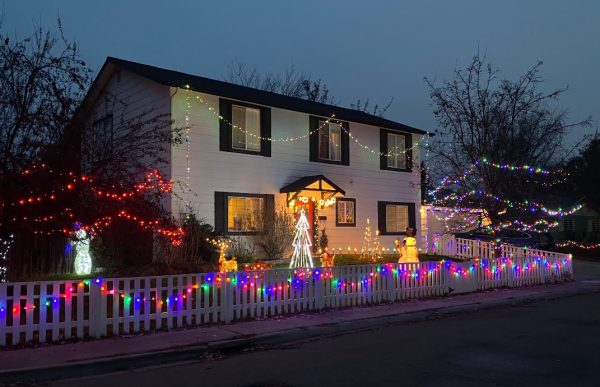
Delightfully Dreadful Decorations

Crimes of Christmas

Christmas Tree Debate: Real or Fake
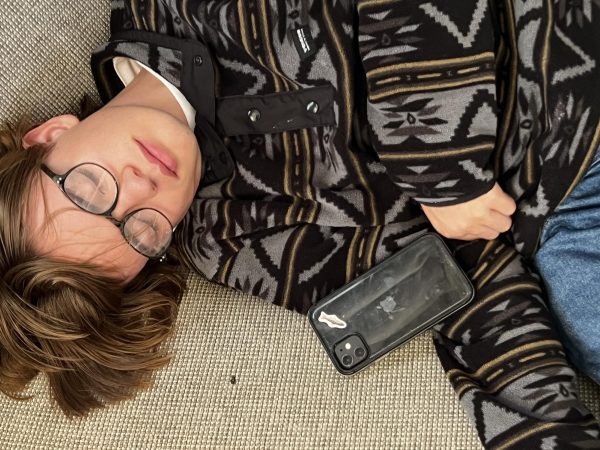
Block Schedule Rules

Scrumptious Halloween Candy Ranking

Horrific Hoco

Woah, What Happened to the Radio?
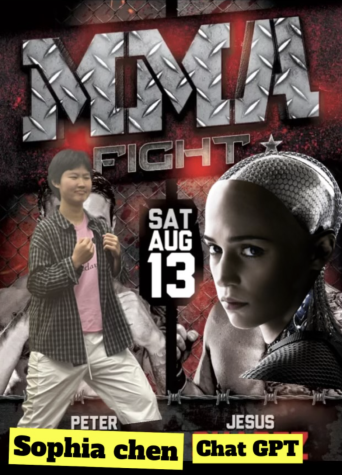
SOPHIA WANTS TO HURT AIAIAIAIAIAIAIAI
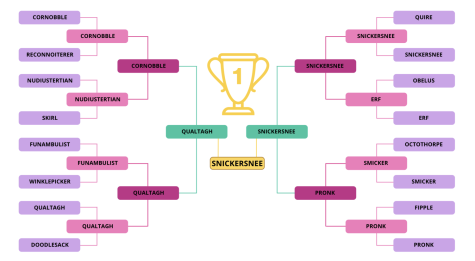
The Most Rib-Tickling, Sidesplitting, Uproarious Words
The Student News Site of Boise High School
- Print Edition
- Print Edition Archives
Comments (0)
Cancel reply
Your email address will not be published. Required fields are marked *

Turn Your Curiosity Into Discovery
Latest facts.

The Art of Email Marketing How to Craft Compelling Emails
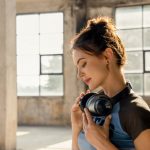
Elevate Your Audio Experience with the CuttingEdge OneOdio A10 Headphones
13 facts about warped tour.
Written by Fernandina Dave
Modified & Updated: 02 Mar 2024
Reviewed by Jessica Corbett
- Alternative Music Festival Facts
- Summer Music Festival Facts
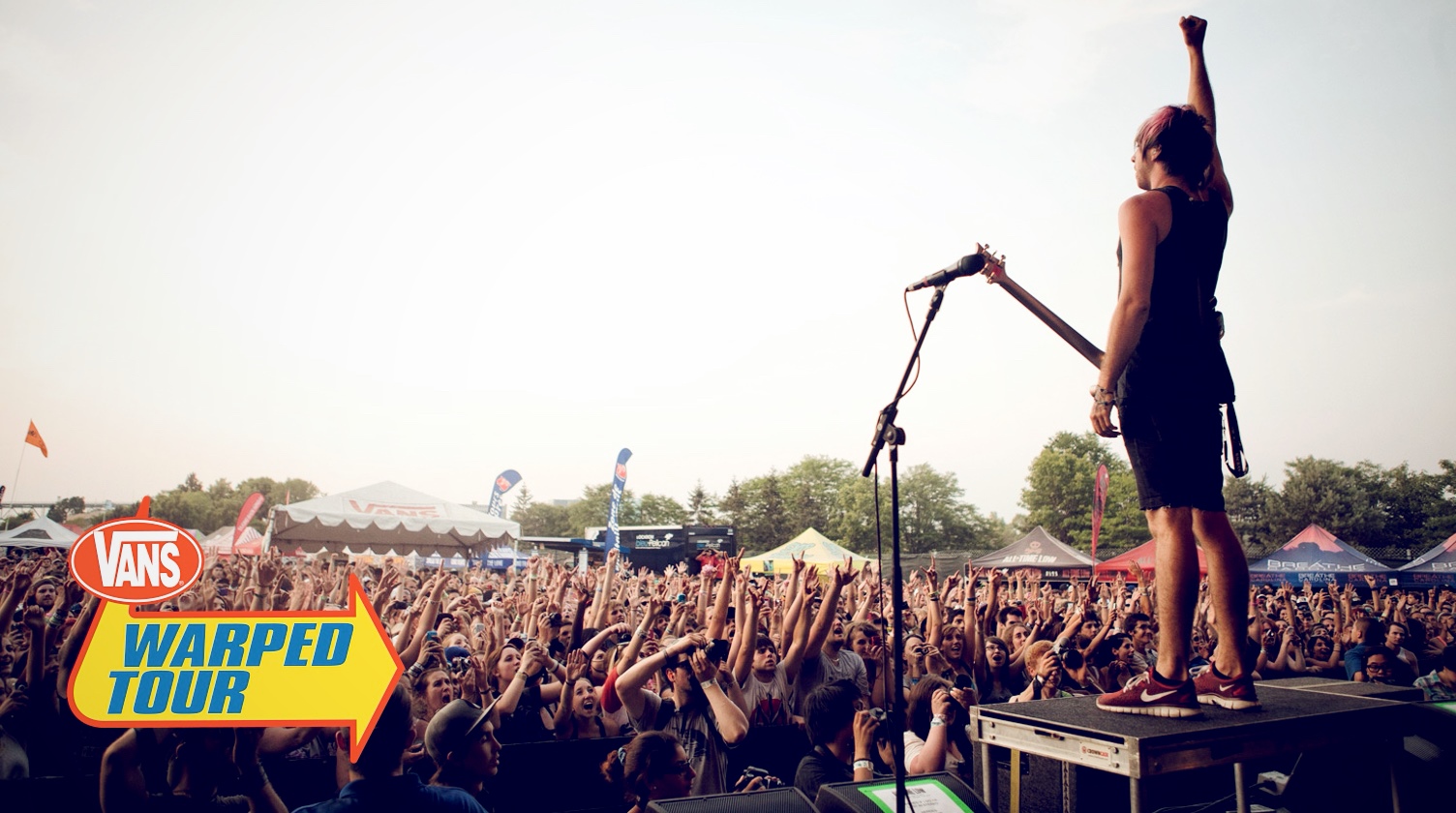
The Vans Warped Tour is an iconic music festival that has been rocking stages across North America for over two decades. From its humble beginnings in 1995, the Warped Tour quickly became a must-attend event for fans of punk, rock, and alternative music genres. Over the years, the tour has featured some of the biggest names in the industry, serving as a launching pad for many up-and-coming bands.
In this article, we will delve into the fascinating world of the Warped Tour and uncover 13 interesting facts about this legendary event. From its unique concept to its massive impact on the music scene, these facts are sure to intrigue both die-hard fans and casual attendees alike. So, grab your sunglasses, put on your favorite band t-shirt, and join us as we take a deep dive into the history, legacy, and unforgettable experiences of the Warped Tour.
Key Takeaways:
- The Warped Tour, founded by Kevin Lyman in 1995, showcased punk rock and skateboarding. It helped launch the careers of bands like Blink-182 and promoted community engagement.
- After 24 years of touring, the Warped Tour held its final full cross-country run in 2018. It inspired similar events worldwide and contributed to the growth of the alternative music scene.
The Warped Tour was founded in 1995 by Kevin Lyman.
Kevin Lyman, a music promoter and producer, created the Warped Tour as a platform to showcase punk rock and alternative music genres. Since its inception , it has become one of the most well-known and influential touring music festivals in the United States.
It was originally intended to be a showcase for skateboarding and punk music.
The early years of the Warped Tour focused heavily on skateboarding culture and featured skate ramps where professional skateboarders would perform tricks. Over time, the festival expanded to include a diverse range of musical acts from various genres.
The Warped Tour has visited over 40 cities annually.
Each year, the tour travels across North America, bringing its unique blend of music, skateboarding, and lifestyle to fans in more than 40 different cities. From coast to coast, the Warped Tour has left an indelible mark on the live music scene.
It has provided a platform for both established and emerging artists.
The Warped Tour has been instrumental in launching the careers of numerous bands and artists. Many well-known acts such as Blink-182, Paramore, Fall Out Boy, and My Chemical Romance got their start performing on the tour’s stages.
The Warped Tour is known for its inclusive and diverse lineup.
One of the defining features of the Warped Tour is its commitment to showcasing a diverse range of artists. From punk rock to metal, hip-hop to electronic, the festival brings together musicians from various backgrounds and genres, appealing to a wide audience.
The tour has featured special theme days.
Throughout its history , the Warped Tour has incorporated theme days to add an extra level of excitement. Examples include “Reverse Day ” where band members switch roles and play different instruments, and “Red vs. Black Day” where attendees wear either red or black clothing to show their support for specific bands.
The Warped Tour is known for its high-energy and interactive performances.
The festival atmosphere of the Warped Tour encourages artists to engage with the audience in unique ways. From crowd-surfing to interactive sets, the performances are memorable and create an immersive experience for fans.
The Warped Tour promotes community engagement and non-profit organizations.
Alongside the music, the tour emphasizes the importance of giving back to the community. Non-profit organizations are often present at the festival, providing information and resources to attendees on a wide range of social and environmental issues.
The Warped Tour has had its own documentary film.
In 2013, a documentary titled “No Room for Rockstars” was released, showcasing the history and impact of the Warped Tour. It provided an in-depth look at the behind-the-scenes aspects of the tour and featured interviews with artists, crew members, and fans.
The Warped Tour has a strong DIY (Do-It-Yourself) ethos.
The festival’s roots in punk rock culture have instilled a DIY mentality that resonates throughout the tour. Independent bands, artists, and vendors are often given opportunities to participate, fostering a sense of community and supporting the grassroots music scene.
The Warped Tour has contributed to the growth of the alternative music scene.
By showcasing emerging artists and alternative genres, the Warped Tour has played a significant role in expanding and diversifying the alternative music scene in the United States. It has helped create a platform for artists who may not have gained mainstream attention otherwise.
The Warped Tour has inspired similar events around the world.
The success and popularity of the Warped Tour have inspired the creation of similar music festivals and tours in other countries. Events like the Vans Warped Tour Australia and the UK’s Slam Dunk Festival have taken cues from the original Warped Tour, bringing its spirit to international audiences.
The final full cross-country Warped Tour took place in 2018.
After 24 years of touring, the Warped Tour held its final full cross-country run in The decision was made to transition to a more localized festival format, allowing the tour to continue showcasing live music in select cities while adapting to changing industry dynamics.
The Warped Tour is an iconic music festival that has left an indelible mark on the music industry. With its diverse lineup, passionate fanbase, and commitment to promoting up-and-coming artists, it has become a rite of passage for many music lovers. Whether you’re a die-hard punk rock fan or just someone looking to discover new music, the Warped Tour offers an unforgettable experience that celebrates both the music and the community that surrounds it. So, if you haven’t already, make sure to catch the next Warped Tour and join in on the excitement and adventure that this legendary festival has to offer.
1. What is the history of the Warped Tour?
The Warped Tour was first organized in 1995 by Kevin Lyman and quickly became the largest traveling music festival in the United States.
2. What genres of music are showcased at the Warped Tour?
The Warped Tour primarily focuses on alternative rock, punk rock, pop punk, and hardcore music, but also features a variety of other genres like hip-hop, metal, and indie rock.
3. How long does the Warped Tour last?
The duration of the Warped Tour varies each year, but typically spans from June to August, with multiple shows held across different cities and states.
4. Can anyone attend the Warped Tour?
Yes , the Warped Tour is open to music fans of all ages. However, some shows may have age restrictions or require parental consent for attendees under a certain age.
5. How can I buy tickets for the Warped Tour?
Tickets for the Warped Tour can be purchased online through official ticketing websites or at the venue on the day of the event, subject to availability.
6. Are there any special activities or experiences offered at the Warped Tour?
Along with the incredible live performances, the Warped Tour offers a range of attractions like signing sessions with artists, merchandise booths, interactive exhibits, and opportunities to meet your favorite bands.
7. How can I stay updated with the latest news and announcements about the Warped Tour?
To stay informed about the Warped Tour, you can follow their official website and social media accounts, sign up for newsletters, and join online communities dedicated to the festival.
Was this page helpful?
Our commitment to delivering trustworthy and engaging content is at the heart of what we do. Each fact on our site is contributed by real users like you, bringing a wealth of diverse insights and information. To ensure the highest standards of accuracy and reliability, our dedicated editors meticulously review each submission. This process guarantees that the facts we share are not only fascinating but also credible. Trust in our commitment to quality and authenticity as you explore and learn with us.
Share this Fact:
- Statistics Stats
- You are here:
Setlist History: Warped Tour 1995
- Setlist History
- Last updated: 3 Aug 2018, 17:58:35
- Published: 3 Aug 2018, 17:58:35
- Written by: Erica Lauren
- Photography by: Jeff Kravitz
- Categories: Festivals Setlist History Tagged:
As we say farewell to the full, traveling stretch of the Vans Warped Tour, we're flashing back to the roots of 'punk rock summer camp.' The Warped Tour, which was first created in 1995 by Kevin Lyman, ran for 26 dates, kicking-off on August 4th at the Idaho Center in Boise, Idaho, and wrapping up a few months later on September 6th in Irvine, California. It wasn't until the following year, in the summer of 1996, that the tour gained a Vans sponsorship, adding their name to be the Vans Warped Tour.
The very first alternative rock filled lineup included bands like Quicksand, L7, Sublime, Deftones, No Use for a Name, Face to Face, Sick of it All, No Doubt, Guttermouth, Swinging Udders, and more. The music festival also featured pro-skaters, boarders and bikers, with a half pipe and street course for the sports. You'd be hard pressed to find this at this summer's final run of the tour. Check out the flyer for the first ever Warped Tour below:
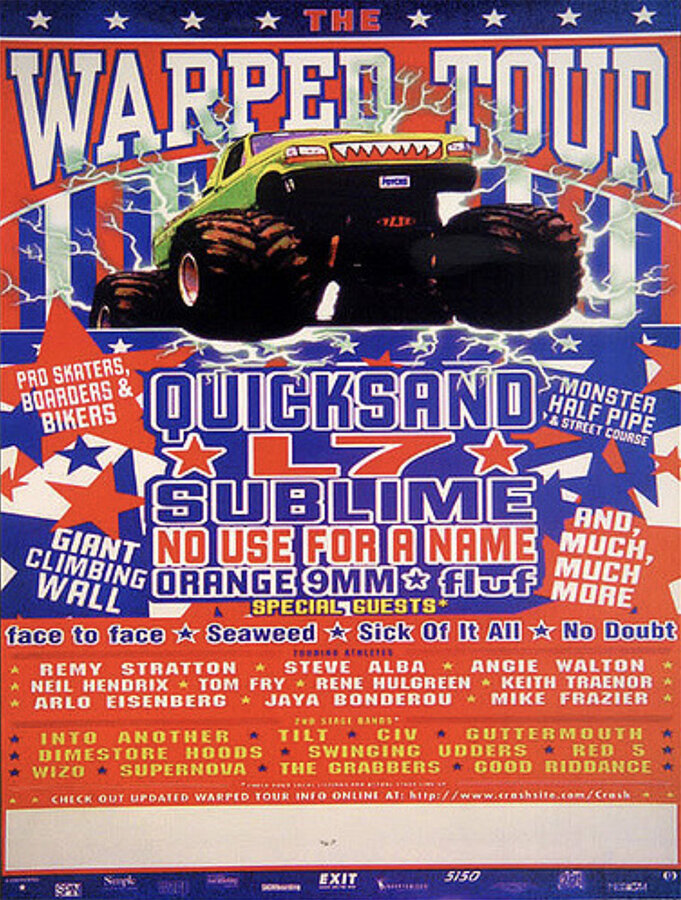
Check out some setlists from 1995's Vans Warped Tour:
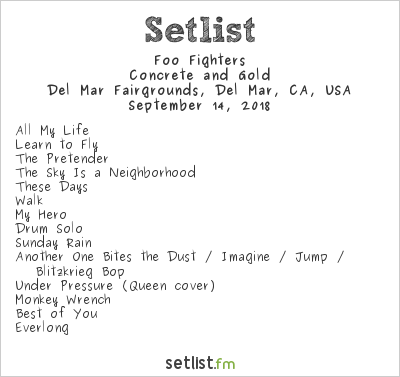
Watch No Doubt perform at the first Warped Tour, in this fan-shot video:
The current and final traveling Vans Warped Tour will conclude Sunday, August 5th at West Palm Beach, Florida's Coral Sky Amphitheatre. For ticket info to the final 3 shows remaining in Florida, visit the fest's official website here .
To view live photos from festivals and concerts, follow Setlist.fm on Instagram and Twitter .
Latest News
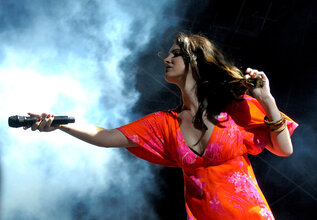
Six Songs Lana Del Rey Should Play Friday at Coachella
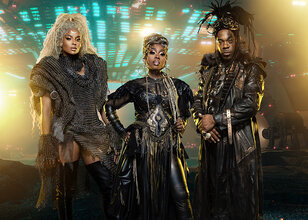
Missy Elliott Announces The Out Of This World Tour
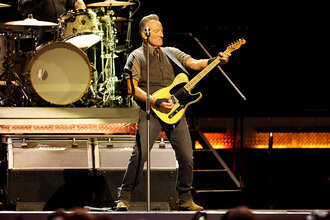
Bruce Springsteen Delivers "Fire" To Two LA Audiences With Wife
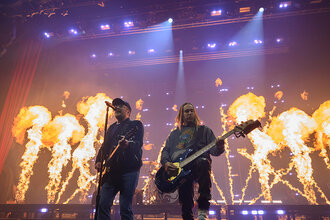
Fall Out Boy Wraps So Much for (2our) Dust in Minneapolis
- Setlist Insider See the artists dive into their own setlist data.
- Live Debuts Witness the first time a song is performed live.
- Setlist.fm Exclusives Videos, photos and interviews - see it here first.
- Covers Better than the original? You decide.
- Guest Appearances Keeping track of the on-stage cameos.
- Setlist History Looking back on moments in music history.
- Tour Dates How to catch your faves: The who, what, where and when.
- Festivals News about the multi-artist, multi-day extravaganzas.
- General News Other music-related news.
- Apr 8, 2024
- Apr 7, 2024
- Apr 6, 2024
- Apr 5, 2024
- Apr 4, 2024
- Apr 3, 2024
- FAQ | Help | About
- Terms of Service
- Ad Choices | Privacy Policy
- Feature requests
- Songtexte.com

April 8 Language acquisition in human development
April 4 The truth unfolds in the “Quiet on Set: The Dark Side of Kids TV” documentary
March 30 Total solar eclipse appearing in North America on April 8
March 29 Trader Joe’s mini totes rise in popularity
March 28 Cherry Hill’s Spring Break Plan fails to recognize students and teachers
March 26 From Prosecutor to Lieutenant Governor: The Rise of Kimberly Guadagno in New Jersey Politics
March 23 The Class of 2025 prepares for Junior Prom
March 22 PODCAST: Eastside tries Crumbl Cookies (St. Paddy’s Day Edition)
March 21 The Class of 2024 raises money through a student vs staff basketball game
March 20 96th Academy Awards recap
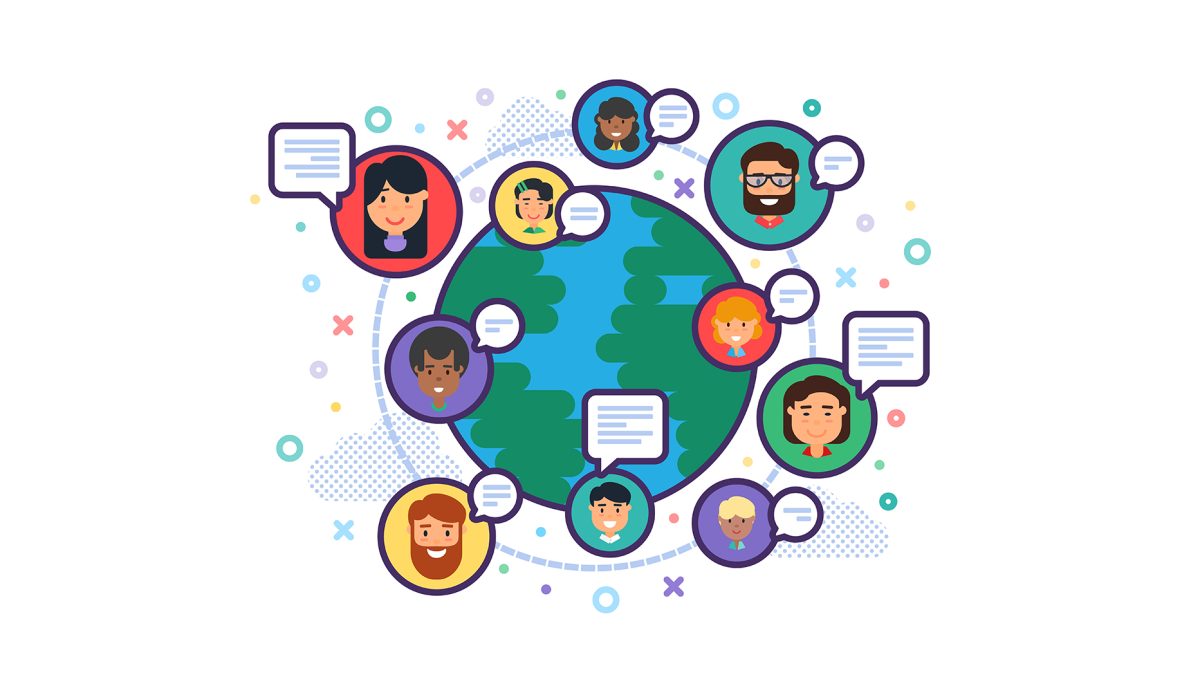
Mika Bhaskaran | April 8, 2024
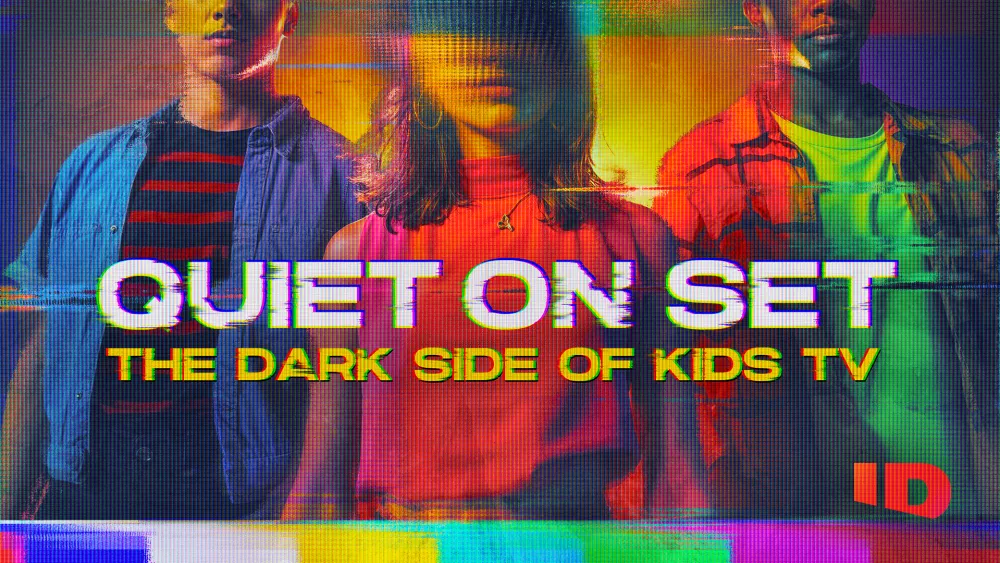
Stella Kim , Eastside Staff | April 4, 2024

Dino Russo , Eastside Staff | March 30, 2024

Kaylee Yoon , Eastside Media Director | March 29, 2024

Gabrielle Levine , Eastside Community Editor | March 28, 2024
Vans’ Warped Tour: a history
Normal 0 false false false MicrosoftInternetExplorer4
Van’s Warped Tour is a music festival that brings over 600,000 kids across the country a lineup of 100 rock bands. Today, the tour attracts thousands of music loving fans, but in 1995 Kevin Lyman created Warped Tour for a very different reason.
Kevin Lyman started his career
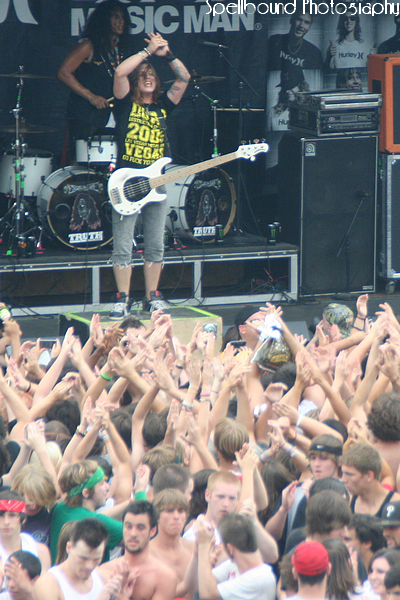
in music while in college. For his university, he booked performances featuring upcoming bands. After graduating, Lyman continued pursuing his music career by working as a production manager under the up-and-coming music promoter Goldenvoice. Still, Lyman wished to promote bands on a larger scale. Pairing his love of music and skateboarding, Lyman envisioned a skateboarding competition accompanied by live music. The first ever Warped Tour took place in 1995 when Vans, a skateboarding company, sponsored the tour.
The music genres played at Warped has progressed over the years. Originally Ska and skate punk was played, including bands such as No Doubt and Sublime. The genres played progressed into punk rock and metal core. By the early 2000’s, Warped became centered on pop rock and post-hardcore bands that it features today. This year a few of the bands included in the band lineup is Saosin, Bayside, Nevershoutnever, and A Day to Remember.
From June to August, the Warped Tour travels across the country, from coast to coast. In 1998, Warped Tour went international, playing at venues in Australia, Japan, and throughout Europe. Almost every day of the summer, The Warped Tour is set up in empty lot, or a large stadium. Scattered across the designated area are five stages. Smaller stages are reserved for up and coming bands, while the larger stages are performed on by well known bands. Many times
throughout the day, bands are playing at the same time. Those who attend the concert pick and choose the bands they wish to see.
The Warped Tour may center on music, however the tour is also a social event. Along with the stages, tents are raised throughout the lot. Clothing companies, band merchandise, and charities all set up displays. Bands that are just starting out follow the tour hoping to attract new fans. A skateboard ramp is set up in the center of the grounds, where anyone can skate.
Although warped tour only takes place one day in a local community, it has become a traditional summer event throughout the world.
- Warped Tour
The School Newspaper of Cherry Hill High School East
Comments (0)
Your email address will not be published. Required fields are marked *
- Work & Careers
- Life & Arts
Become an FT subscriber
Try unlimited access Only $1 for 4 weeks
Then $75 per month. Complete digital access to quality FT journalism on any device. Cancel anytime during your trial.
- Global news & analysis
- Expert opinion
- Special features
- FirstFT newsletter
- Videos & Podcasts
- Android & iOS app
- FT Edit app
- 10 gift articles per month
Explore more offers.
Standard digital.
- FT Digital Edition
Premium Digital
Print + premium digital.
Today's FT newspaper for easy reading on any device. This does not include ft.com or FT App access.
- 10 additional gift articles per month
- Global news & analysis
- Exclusive FT analysis
- Videos & Podcasts
- FT App on Android & iOS
- Everything in Standard Digital
- Premium newsletters
- Weekday Print Edition
Essential digital access to quality FT journalism on any device. Pay a year upfront and save 20%.
- Everything in Print
- Everything in Premium Digital
Complete digital access to quality FT journalism with expert analysis from industry leaders. Pay a year upfront and save 20%.
Terms & Conditions apply
Explore our full range of subscriptions.
Why the ft.
See why over a million readers pay to read the Financial Times.
International Edition
Advertisement
Supported by
Critic’s Pick
Beyoncé’s Country Is America: Every Bit of It
On the bold, sprawling “Cowboy Carter,” the superstar plays fast and loose — and twangy — with genre.
- Share full article

By Jon Pareles
The first song on “Cowboy Carter,” Beyoncé’s not-exactly-country album, makes a pre-emptive strike. “It’s a lot of talking going on while I sing my song,” she observes in “Ameriican Requiem” over guitar strums and electric sitar, adding, “It’s a lot of chatter in here.”
That’s an acknowledgment that a pop superstar’s job now extends well beyond creating and performing songs. In the era of streaming and social media, Beyoncé knows that her every public appearance and utterance will be scrutinized, commented on, cross-referenced, circulated as clickbait and hot-taked in both good faith and bad. Every phrase and image are potential memes and hyperlinks.
It’s a challenge she has engaged head-on since she released her visual album “Beyoncé” in 2013. For the last decade, even as her tours have filled stadiums, she has set herself goals outside of generating hits. Beyoncé has deliberately made each of her recent albums not only a musical performance but also an argument: about power, style, history, family, ambition, sexuality, bending rules. They’re albums meant to be discussed and footnoted, not just listened to.
“Cowboy Carter” is an overstuffed album, 27 tracks maxing out the 79-minute capacity of a CD and stretching across two LPs. It flaunts spoken-word co-signs from Willie Nelson and Dolly Parton that interrupt its flow; it includes some fragmentary, minute-long songs. Its sprawl is its own statement of confidence: that even half-finished experiments are worth attention.
The “Cowboy Carter” album cover is an opening salvo, brandishing western and American symbols: Beyoncé holding an American flag while riding a white horse sidesaddle, with platinum-blond hair proudly streaming. In a red-white-and-blue outfit, high-heeled boots and a pageant sash that reads “Cowboy Carter,” she’s a beauty queen and a white-hatted heroine claiming her nation — her country, in both senses. The politics of her new songs are vague and glancing, but the music insists that every style is her American birthright. As a pop star it is: Pop has always breached stylistic boundaries, constantly exploiting subcultures to annex whatever might make a song catchier.
Beyoncé grew up in Texas, where country music has long mingled with styles from jazz to blues to hip-hop — and where, in fact, early cowboys were enslaved Black men . Beyoncé met a racial backlash when she performed “Daddy Lessons,” a country song from her 2016 album “Lemonade” about gun-toting self-defense, with the (then-Dixie) Chicks at the 2016 Country Music Association Awards. Presumably that’s what she alluded to when she wrote on Instagram that there was “an experience that I had years ago where I did not feel welcomed.”
She wasn’t daunted. Instead she pushed further, and the mere prospect of Beyoncé releasing a country album stirred things up. Even before its release, “Cowboy Carter” prompted reminders of country’s obscured Black roots — like the African origins of the banjo and the genre’s long cross-pollination with the blues — and pointed at, yet again, its historical exclusion of nonwhite performers, despite a handful of exceptions like Martell, Charley Pride and, more recently, Darius Rucker, Mickey Guyton and Kane Brown.
What Beyoncé drew from country is productions that feature hand-played instruments — guitars, keyboards, drums — rather than the programmed beats and glittering electronics that propelled her 2022 album “Renaissance,” which also had Beyoncé on horseback on the cover and was subtitled “Act I.” That album was Beyoncé’s time-warped, multilayered homage to the electronic dance music that emerged from Black gay subcultures. “Cowboy Carter,” subtitled “Act II,” also scrambles eras and styles, with samples, electronics and multitracked vocal harmonies unapologetically joining the guitars.
The advance singles from “Cowboy Carter” paired “16 Carriages,” a booming arena-country song about Beyoncé’s industrious career and artistic drive, with the foot-stomping, banjo-picking “Texas Hold ’Em,” about enjoying Texas-style good times away from home. “Texas Hold ’Em” seized No. 1 on Billboard’s Hot Country Songs chart, making Beyoncé the first Black woman to do so, and topped the all-genre Hot 100.
If Beyoncé had merely wanted to make mainstream country hits, she could have hired a seasoned Nashville producer and had her pick of expert Music Row songwriters. But “Cowboy Carter” has different aspirations, and Beyoncé brought her own brain trust, including producers known for hip-hop and R&B. “This ain’t a Country album. This is a Beyoncé album,” she wrote on Instagram. That’s true.
“Cowboy Carter” leans into its anticipated discourse, openly interrogating categories and stereotypes and pointedly ignoring formulas. With historical savvy, Beyoncé enlisted Linda Martell — the Black country singer whose 1970 album, “Color Me Country,” included the first charting country hit by a Black woman, “Color Him Father” — to provide spoken words. For the intro of “Spaghettii” — which features Beyoncé rapping — Martell says, “Genres are a funny little concept, aren’t they? Yes, they are. In theory, they have a simple definition that’s easy to understand. But in practice, well, some may feel confined.”
Beyoncé gathers young Black women currently striving for country careers — Brittney Spencer, Reyna Roberts, Tiera Kennedy and Tanner Adell — on a remake of the Beatles’ veiled civil-rights song, “Blackbird.” It’s a careful gesture, though it might have been more substantial to write a new song with them.
The album includes some understated, largely acoustic contenders for country or adult-contemporary radio play — notably “II Most Wanted,” a duet with Miley Cyrus that harks back to Fleetwood Mac’s “Landslide,” and “Levii’s Jeans,” a boast about being a “sexy little thing” that she shares with a besotted Post Malone. In the steady-thumping, Motown-tinged “Bodyguard,” Beyoncé plays an amorous, jealous but selfless partner in an uncertain romance. And in “Protector,” an acoustic-guitar lullaby, Beyoncé personifies a loving, supportive parent singing about “lifting you up so you will be raised.”
Beyoncé also reworks Parton’s “Jolene” — a country classic about a dangerous temptress — by turning it inside out. Where Parton’s 1973 original had her “begging” Jolene to stay away, in 2024 Beyoncé isn’t one to cede power. She starts out by “warning” Jolene and raises the threat level from there, reminding her target, “I know I’m a queen.”
Martell returns to introduce “Ya Ya,” explaining, “This particular tune stretches across a range of genres. And that’s what makes it a unique listening experience.” The song is a hand clapping, 1960s-flavored garage-rock stomp that samples Nancy Sinatra, quotes the Beach Boys and brandishes lines like “There’s a whole lot of red in that white and blue/History can’t be erased,” then moves on to dancing and lust. It’s not geared for any radio format. It’s just a romp.
It’s the odder, genre-fluid songs that give the album its depth. “Just for Fun” — a hymnlike duet with Willie Jones, a Louisiana songwriter who draws on country and R&B — plunges into Beyoncé’s somber low register as she sings, “I need to get through this/Or just get used to it.” “Riiverdance” deploys intertwined Celtic-tinged guitars and close-harmony backup vocals to sketch an enigmatic relationship that encompasses murder and resurrection and weekend seductions. And “II Hands II Heaven” is equally cryptic and celebratory; using an electronic pulse drawn from Underworld’s “Born Slippy (Nuxx),” it has Beyoncé and backup voices singing about whiskey, coyotes, God, sex and “Lost virgins with broken wings that will regrow.”
Beyoncé has been a stalwart of the full-length album, sequencing and juxtaposing songs in synergistic ways. But “Cowboy Carter” is a bumpier ride than “Renaissance,” “Lemonade” or “Beyoncé.” It suggests that Beyoncé wanted to pack all she could into one side trip before moving on elsewhere. Perhaps she’s already immersed in Act III.
Beyoncé “Cowboy Carter” (Parkwood Entertainment/Columbia)
Jon Pareles has been The Times’s chief pop music critic since 1988. He studied music, played in rock, jazz and classical groups and was a college-radio disc jockey. He was previously an editor at Rolling Stone and the Village Voice. More about Jon Pareles

IMAGES
COMMENTS
The Warped Tour was a traveling rock tour that toured the United States and Canada each summer from 1995 until 2019. ... History The Alternative Press/Advent stage (left) and Glamour Kills stage (right) on the 2010 tour, an example of the tour's side-by-side stage setup. Acts play alternating 30-minute set times on the two stages.
The Vans Warped Tour was a summer music and extreme sports festival that toured annually from 1995 to 2019. The following is a comprehensive list of bands that performed on the tour throughout its history.
Starting as an eclectic alternative rock festival in 1995 and gradually morphing into a punk rock festival by the next year, the tour gained momentum when Vans, the wildly popular shoe manufacturer, was signed on as the tour's main sponsor in 1996. As Warped Tour became increasingly popular with each passing year, more sponsors signed on ...
Warped Tour, especially in its earliest years, acted this way, year upon year, launching artists out of obscurity and into the eyeline of the mainstream. Blink 182, a band that was long considered too crude and provocative for mainstream success, appeared on three out of the four Warpeds between 1996 and 1999.
A history of Vans Warped Tour, the iconic music festival that helped commodify punk. ... Warped Tour itself is a contradiction — it's a punk rock festival that's also a prodigious marketing ...
The Summer Punk Went Pop: Oral History of the 2005 Warped Tour. On the first day of Warped's final run, we present the firsthand story of its watershed year - when Fall Out Boy, My Chemical ...
In August 1995, a traveling alt-rock music festival called the Warped Tour played at the University of Colorado's Franklin Field in Boulder—the tour's second show. Over the next 23 years, it helped launch the careers of big names like Eminem and Paramore, plus hundreds of less-famous talents.
Read more: Warped Tour 25-year history, brought to you in one playlist. From 1995 to 2005, Laura Raun was family nurse practitioner for Warped Tour, coming to the aid of action-sport athletes ...
In AP 253, we have a massive Oral History of the Vans Warped Tour, but that’s only half the story. Check out our abridged version of the sounds that emanated from 15 summers of Warped. 1995
Warped Tour: A Look Back in Photos in Honor of Its Last Hurrah. Last year, Warped Tour's founder, Kevin Lyman, announced the end of an era: After nearly a quarter of a century, the monumental ...
Music Festival History: The Vans Warped Tour. Dating back to 1995, the Vans Warped Tour was a rock tour that traveled around the United States and Canada every summer. Known as "punk rock summer camp," this mobile music festival was the biggest one in the United States, and it also had the distinction of being the longest-running music festival that has ever toured in North America.
When the Vans Warped Tour kicked off in 1995, nobody knew exactly what to expect— least of all founder Kevin Lyman. "We did 24 dates that first year, which is pretty ambitious. We probably should have done a couple of them and come home," laughs Kevin. "But I've always tended to go for it, and the promoters were willing to give us a ...
June 5, 2019. The AP office has been running wild ahead of Warped Tour's 25th anniversary dates, trying to think of proper ways to celebrate its unprecedented run as the go-to punk-rock event of ...
This article explores the history of Warped Tour, from its beginnings in 1995 to its impact on the music scene today. It includes interviews with the founders of Warped Tour, a timeline of its development, and an exploration of its lasting legacy.
The Vans Warped Tour faced accusations of being a boys' club from certain sections, with The New York Times citing how only seven percent of the bands listed for the 2018 edition featured female members. Although the tour had shown improvement in its numbers and given more opportunity to women over the years, especially as headliners, there was ...
Each of them were experienced with Warped Tour, having attended the festival on and off beginning in the early 2000s. Aaron, 33, described with pride seeing Paramore in 2005 "before they were ...
Members of Sum 41 and Less Than Jake -- along with fest founder Kevin Lyman -- reveal the hidden history of Vans Warped Tour in the latest episode of our podcast, Inside Track. News The 21 Hottest ...
For the past 15 years, the Vans Warped Tour has been barreling through city after city across the globe creating punk rockers out of boy scouts and riot grrls out of band geeks. The traveling punk ...
Andie Nickels, ReporterJanuary 20, 2023. Warped Tour was the highlight of the summer for kids who liked music. It was an iconic rock festival that annually toured across America, stopping in both major cities and smaller towns alike. For many years, Warped Tour used to stop in Idaho, something that I believe to be one of the few good things ...
The Warped Tour was founded in 1995 by Kevin Lyman. Kevin Lyman, a music promoter and producer, created the Warped Tour as a platform to showcase punk rock and alternative music genres. Since its inception, it has become one of the most well-known and influential touring music festivals in the United States.. It was originally intended to be a showcase for skateboarding and punk music.
The Warped Tour, which was first created in 1995 by Kevin Lyman, ran for 26 dates, kicking-off on August 4th at the Idaho Center in Boise, Idaho, and wrapping up a few months later on September 6th in Irvine, California. It wasn't until the following year, in the summer of 1996, that the tour gained a Vans sponsorship, adding their name to be ...
July 30, 2009. Van's Warped Tour is a music festival that brings over 600,000 kids across the country a lineup of 100 rock bands. Today, the tour attracts thousands of music loving fans, but in 1995 Kevin Lyman created Warped Tour for a very different reason. Story continues below advertisement.
The Warped Band: The Ultimate Tribute to Warped Tour More Info. Sat • Aug 17 • 9:00 PM Music Farm, Charleston, SC. Important Event Info: Doors will open at 8:00 pm and the show will begin at 9:00 pm.
Period drama wriggles defiantly free of ruffs and bonnets in Dirty Hare theatre company's Gunter: a punky, funny, feminist take on history.A hit at last year's Edinburgh Fringe, the show now ...
NYT Critic's Pick. The first song on "Cowboy Carter," Beyoncé's not-exactly-country album, makes a pre-emptive strike. "It's a lot of talking going on while I sing my song," she ...